








Fillers, filters, fitness—they all make it impossible to distinguish age nowadays. Someone’s technological capabilities, on the other hand, can serve as the proverbial proof in the pudding.
For instance, it’s easier for me to order my 50-something parents an Uber, even when I’m 5,000 miles and two time zones away, than it is to explain how to download the app onto their own phones. But even as a 30-something millennial, I have my own ill-fated encounters with technology. I’ve never mastered how to set “out of office” messages on my email. Pigs will fly before I use my phone for contactless payments. And much to the dismay of the 20-something creatives who put this magazine together, I have a long way to go with InDesign.
A person’s jeans preference can also say a lot about their age despite denim’s timeless appeal to both the young and young at heart. This issue explores the generational aspects of designing and shopping for denim.
In “Middle Ground” (pg. 36), hear from executives at NYDJ and Jen7 on how they balance trends with comfort, stretch and versatility for women 40 and up. In “Science of Stretch” (pg. 52) discover how fiber and fabric mills are working to make stretch technologies better for the planet.
Meet the youngest generation in “A+” (pg. 19), which considers how technology, inclusivity and activism will shape Generation Alpha into a unique consumer demographic that brands and retailers need to prepare for right now. In “Indigo Children” (pg. 22) kids’ denim brands like DL1961 and OshKosh B’Gosh share how school closures and the overall casualization of fashion have impacted their businesses.
Meanwhile, Gen Z is ditching traditional retail altogether to cop preowned jeans from stores like Plato’s Closet. In “Thrifty & Thrifting” (pg. 32), Gen Z consumers explain why they prefer to buy secondhand fashion, what they consider to be a sustainable jean and how much they’re willing to pay for one.
Their answers may be a wakeup call for an industry challenged by rising production costs and extreme weather, which we put under the microscope in “Under Water” (pg. 60) and “Energy Agony” (pg. 64).
Angela Velasquez Executive Editor, Rivet
Peter Sadera Editor in Chief, Sourcing Journal
Jessica Binns Managing Editor
Arthur Friedman Senior Editor
Vicki M. Young Executive Financial Reporter
Jasmin Malik Chua Sourcing & Labor Editor
Kate Nishimura Features Editor
Kari Hamanaka Logistics Editor
Glenn Taylor Business Editor
Christopher Blomquist Denim Editor
Lauren Parker Branded Content Manager
Sarah Jones Senior Editor, Strategic Content Development
Andre Claudio, Staff Writer, Strategic Content
Tirso Gamboa VP, Creative, Fairchild Media
Celena Tang Associate Art Director
Libby Groden Associate Art Director
Yeni Cho Senior Designer Arani Halder Designer
SOURCING JOURNAL ADVERTISING
Edward Hertzman Founder & President, Sourcing Journal & Rivet Executive Vice President, Fairchild Rebecca Goldberg VP, Strategy & Business Development
Eric Hertzman Senior Director of Sales & Marketing
Deborah B. Baron Advertising Director
Allix Cowan Corporate Subscription Sales Associate
Aaron Buotte Media Coordinator
Sarah Sloand Executive Sales Assistant
Kevin Hurley Production Director
John Cross Production Manager Therese Hurter PreMedia Specialist
JAY PENSKE CHAIRMAN & CEO
GERRY BYRNE VICE CHAIRMAN
GEORGE GROBAR CHIEF
CRAIG
JENNY
DAVID
JUDITH R. MARGOLIN SENIOR VICE PRESIDENT, DEPUTY GENERAL COUNSEL
KEN DELALCAZAR SENIOR VICE PRESIDENT, FINANCE
LAUREN UTECHT SENIOR VICE PRESIDENT, HUMAN RESOURCES
NELSON ANDERSON SENIOR VICE PRESIDENT, CREATIVE
RACHEL TERRACE SENIOR VICE PRESIDENT, LICENSING & BRAND DEVELOPMENT


Designers experiment with denim in their Spring/Summer 2023 collections.
Inclusivity, sustainability and digital fash ion are the norm for Generation Alpha.
In a post-pandemic world, the children’s denim market faces its own host of chal lenges and opportunities.
Teen denim retailers prepare for holiday with new fits and digital storytelling.
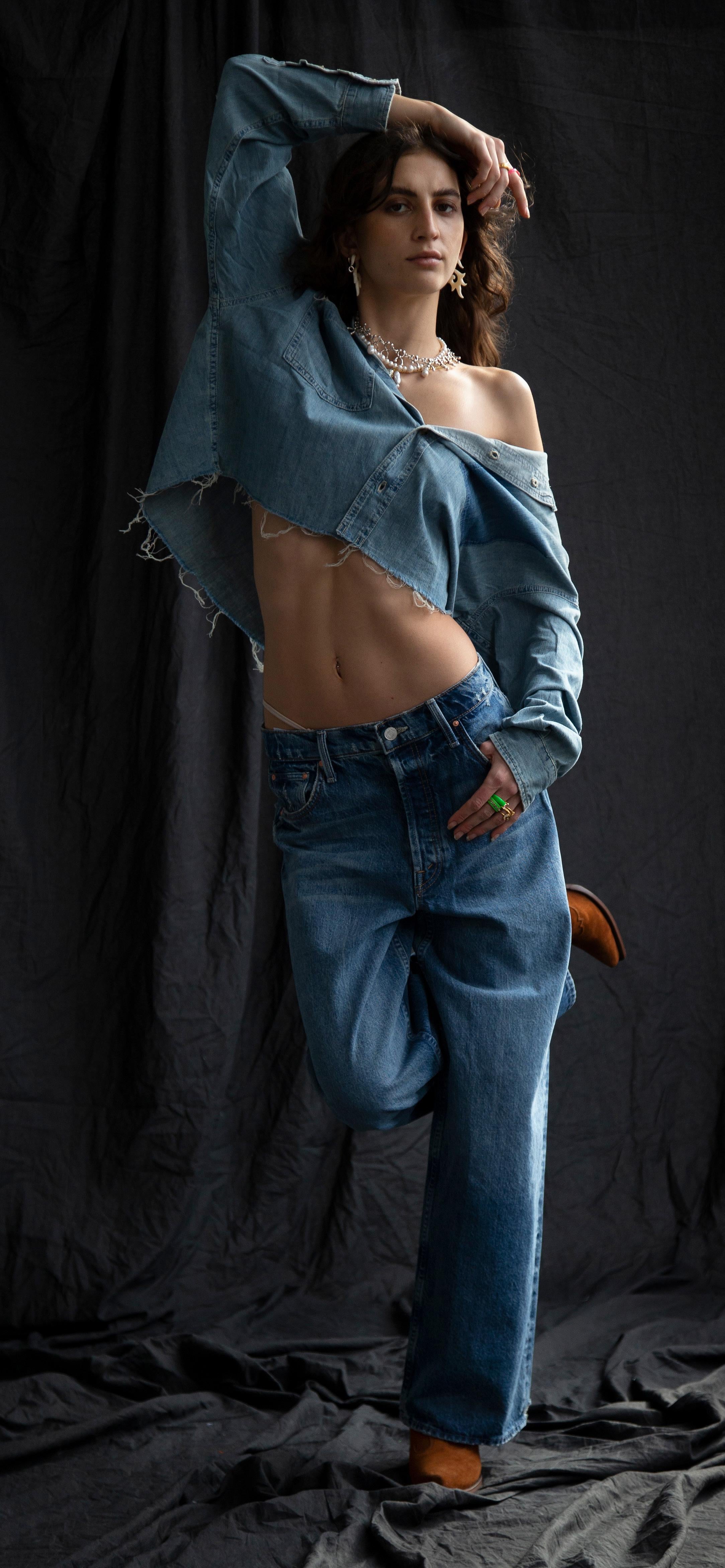
Are Gen Z consumers really willing to pay the price for sustainable jeans?
Denim brands serving Gen X balance comfort and fashion.
Denim is the foundation of the modern wardrobe.
New technologies are making denim with give greener.
The denim sector continues to weather challenges that industry leaders could never have predicted.
Exorbitant increases in the cost of gas, oil and electricity are driving some denim mills to the brink of survival.
Collaborations, Ye and supply chain-led projects caught the industry’s attention in 2022.
The humble denim belt loop turns 100.
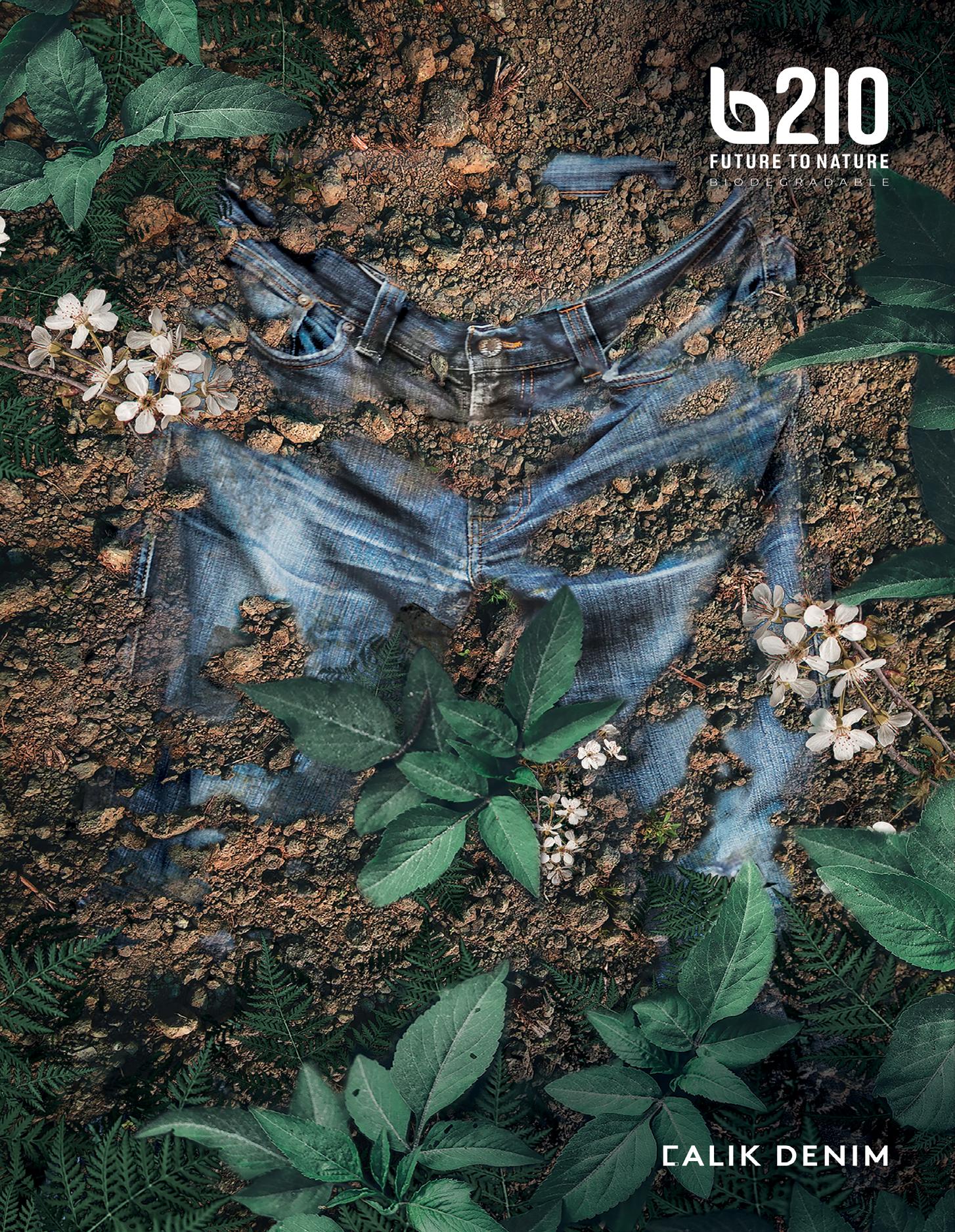


Why mess with Y2K perfection? G-Star Raw re-released key items in its collection dating back to 2000. “No edits, no additions, just pure original G-Star styles from Y2K,” the Dutch brand said of the time-warp collection. The collection of nostalgic replicas for women spans a low-rise denim chino with a wallet chain, a low-rise jean with two-tone patchwork details, a bomber jacket, a ribbed knit sweater, a denim vest, cropped army pants, a strapless denim mini dress, logo tee and a pink leather vest and black leather peacoat. The collection retails for $45-$560.
With Gen Z increasingly embracing the Y2K trend, relaunching the 11 limited-edition styles was a nobrainer for G-Star. The brand says its first years since launching in 1989 were lived through the “hedonistic” ’90s and ’00s. “It was a time of cultural relevance, when the internet was born and low-rise jeans were worn,” it added.
While the designs are straight from its archive, G-Star found young blood to pull together the range, tapping into 27-year-old model Rose Bertram’s taste and point of view. “When G-Star asked me to curate the Y2K collection—directly from their archive—I had to say yes,” Bertram said.
“It was super inspiring because I love the brand and the era. I picked my favorite original designs, all from the year 2000.”
Likewise, the report found that in Spain searches for cargo pants have seen a 60 percent increase month over month by Gen Z on Pinterest, with majority sell outs tracked across nine retailers. Baggy fits are also popular there and reflect the growing appreciation of gender fluidity.

It is tailored trousers that dominate in the U.K. at present though. Edited said that an appreciation for stereotypical Scandinavian simplicity has become a hot U.K. trend due in part to the popularity of Swedish influencer Matilda Djerf who has received more than 50 million views on TikTok.
Gen Z are not a cookie-cutter bunch says a new analysis from Edited, the retail intelligence firm. The report stresses the cohort has very different tastes and concerns based upon what country they live in. However, roomy bottoms from cargos to full-on parachute pants seem to be a rare common denominator.
“[U.S.] Gen Zers are cultivating grunge influences for a Sad Boy/Girl Fall. This movement coincides with the return of Indie Sleaze and the Teenage Dirtbag TikTok trend, sparking interest in slouchy denim, graphic tees and knitted vests,” the report said.
“The parachute pant is set to become a breakout trend, with Australiasian Pinterest searches showing a weekly double-digit increase. A Dion Lee style at David Jones, retailing at AUD $650, sold out in a majority of sizes at full price in under a month, while more than ten new styles at Shein are out of stock,” it added.
Wide legged trousers are also popular in China as Gen Z embraces modern takes on more traditional Chinese looks while baggy cargos dominate in Sweden where a love of Gorpcore continues to take hold.
Denim brands can’t get enough of Paramount Network’s hit TV series “Yellowstone” and its fictional Dutton family of ranchers. Authentic Brands Group-owned Lucky Brand launched a limited-edition collaboration with the popular Kevin Costner-led drama. Featuring styles for both men and women, the apparel collaboration riffs on styles worn by the “Yellowstone” cast.

Key denim items in the women’s stud-adorned assortment include a worn-in Western denim snap shirt, a cutoff miniskirt, wide-leg jeans, and a jean jacket with a shearling collar and horse-themed artwork on the back. The men’s line spans distressed and faded jeans, a jean jacket with two flap chest pockets and a Yellowstone patch and a chore jacket with Yellowstone branding on the back. A shawl collar cardigan is also included.
Lucky Brand lassoed real cowboys to help bring the collection to life. Its accompanying ad campaign features members of Compton Cowboys, a group of 10 childhood friends in the Los Angeles-area city of Compton who use horseback riding and equestrian culture to improve their community. For every Lucky Brand x Yellowstone item purchased from Lucky Brand either online or in-store between Nov. 1, 2022, and Nov. 30, 2022, the brand will donate $10 to Compton Jr. Equestrians, up to a maximum donation of $50,000.
A true collaborator, Tommy Hilfiger tapped British designer Martine Rose to apply her vision for gender-inclusive fashion to archival styles from the ’90s.
The resulting 35-piece Tommy Jeans x Martine Rose collection is filled with powerful colors, graphics and exaggerated proportions that fuse streetwear with modern wardrobe essentials. Denim spans unisex cargo jeans in indigo and off-white, denim chaps, a Trucker-style puffer jacket and washed denim cap.
The accompanying campaign features diverse couples in classic domestic settings, aiming to redefine traditional ’90s Americana.

“I really enjoyed being able to explore American subculture and create a campaign that not only celebrates, but rightly spotlights marginalized communities,” Rose said. “Tommy Hilfiger has always been a brand that I’ve drawn inspiration from, so this partnership was such a natural and organic marriage.”
The collection follows other collaborative efforts by the PVH Corp.-owned brand, including a collection of throwback NBA gear and a partnership with Richard Quinn. Hilfiger described the collection as “elevated and unique” and highlights how “out-of-the-box and experimental Martine’s work is.”
“Collaborating with Martine has been inspiring and really pushed me creatively,” he said. “I love it when a designer can come in and put their own touch on our archival pieces.”
New York’s unwavering influence on fashion extends beyond the runway, according to a new index of U.S. states with the best street style by men’s wear brand BoohooMan.
Based on online search data from the last 12 months and social media engagement per state, the Boohoo Group-owned fast-fashion e-tailer’s The Street Style Index ranks the street style of all 50 U.S. states and the District of Columbia against four pillars. The index is based on the number of fans per look on popular online fashion community Lookbook.nu; streetwear video views on TikTok; streetwear search interest via Google Trends; and style influence according to the number of Google searches for streetwear in each state via the SEO tool, Ahrefs.
New York maintained its title as America’s fashion capital, with the highest number of fans per look on Lookbook, with 28.93 fans per look based on 52,396 posts. It also drove the strongest search interest in streetwear on Ahrefs.
New York generated the second-most interest via Google Trends (D.C. ranked No. 1) and the seventh highest views on Tiktok for search terms such as “New York streetwear.” The Empire State has the most Googled street style in the nation, receiving 22,150 monthly average searches, almost 10 times the search volume seen compared to any other state, according to the index.
California, Hawaii, New Jersey, North Carolina, Texas, D.C., Washington, Florida and Oregon rounded out the top 10 list.
Unspun’s new collection highlights technology’s future in fashion. The apparel tech company tapped Portuguese illustrator Bráulio Amado to create three exclusive prints available on custom-fitting wide-leg, straight fit and classic straight jeans.
Inspired by “post-punk, psychedelic, space and the future,” the prints are lasered onto jeans using Jeanologia’s finishing technology. The patches and other graphics are printed using a waterless direct-to-garment printing method by Kornit. The 100 percent organic cotton jeans retail for $250 with a portion of the proceeds donated to Planned Parenthood.
“Like Unspun, Bráulio’s work is personal and full of individual character,” said Annika Visser, Unspun brand lead. “We were drawn to his graphic prints across various mediums and liked that his work was unique and had a signature flair to it.”
Trendy fits and bright colors pop in Dsquared2’s Honey collection for Fall/Winter 2022. The new collection features a flirty twist on wardrobe classics, faithful to the Italian brand’s bold DNA.
Dsquared2 launched Honey in May as a denim-focused subbrand available in extended sizes.
Available in sizes 24-40, the mostly F/W ’22 denim styles are designed to dress and flatter all shapes. Jeans are made from premium stretch denim to give elasticity and softness. “The silhouettes are form-fitting yet comfortable, each one created with a specific pattern to match the right proportions for all body types,” the brand stated.
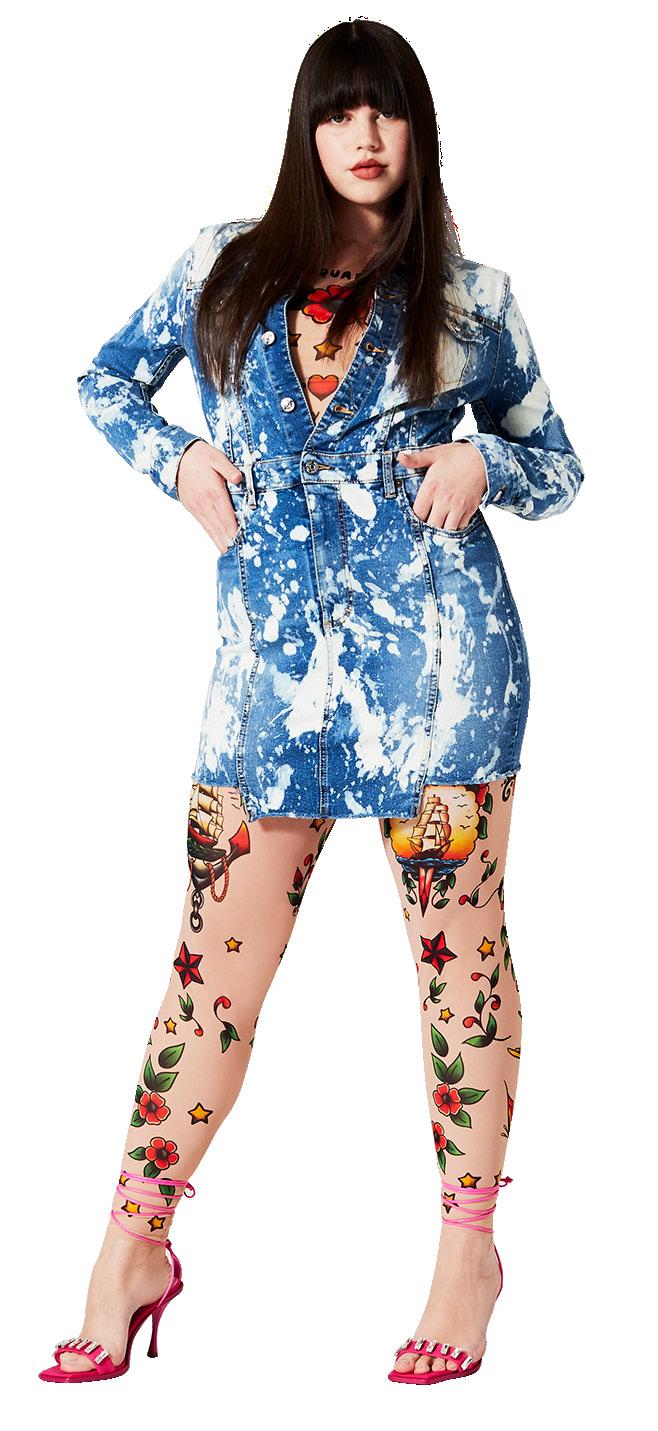
Jean cuts include the Curvy Baggy with a medium rise and wide legs, the high-waisted Twiggy skinny, the high-waisted Flare with a ’70s fit and the high-waisted Bell Bottom that creates an elongated silhouette. Other denim styles include a trench coat, a halter mini dress, a button-front dress, a skirt with an uneven hem, high-waisted shorts and a cropped jacket.
A variety of washes and finishes add personality to the denim range, including Barbiecore pink, splashes of bleach, rips and paint splatter. The collection retails for $215-$1,250.









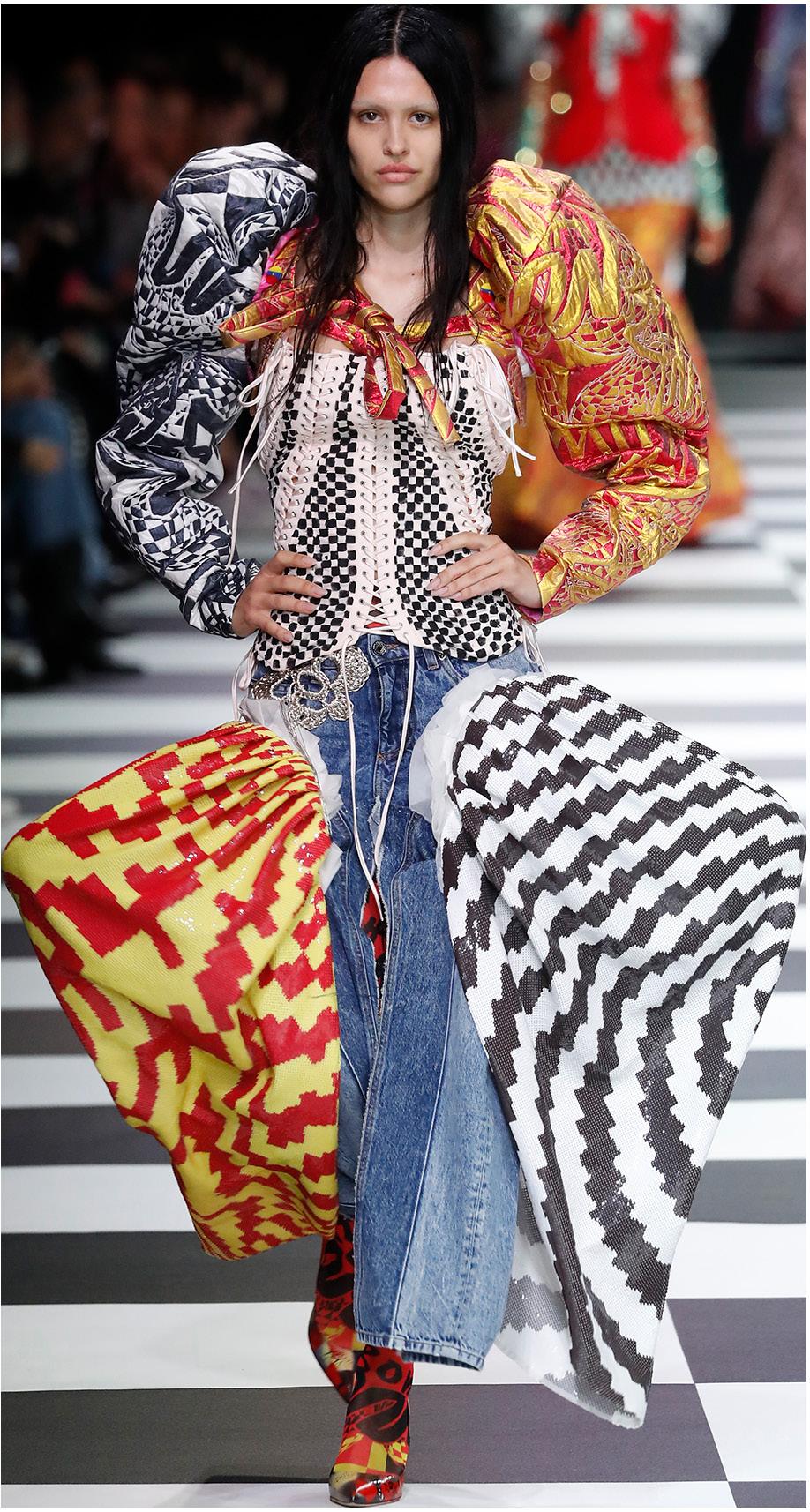

There’s no shortage of new ideas for Spring/Summer 2023.
The fashion industry’s nonstop cycle of newness kicked off in July with men’s and dual-gender labels presenting their S/S ’23 collections, followed by Copenhagen flexing its creative muscle as an emerging sartorial powerhouse in August, followed by back-to-back fashion weeks in New York, London, Milan and Paris that stretched into October.
With just a few months to process the fashion whirlwind before collections land in stores, one thing is certain: denim has a permanent place on the runway.
From the eminent return of grunge and Y2K’s stronghold on youth-driven brands to decorated den-im and fresh takes on workwear, here’s a look at how denim is making a splash.
Men’s Fashion Weeks in London, Milan and Paris revealed a season that is edgy and soft at the same time.
In fact, denim nabbed the No. 1 spot on fashion search engine Tag-Walk’s report on top S/S ’23 men’s wear trends.
Designers relied on tried-and-true techniques to update their jeans assortments. Echoing a trend seen in women’s resort collections, Celine presented jeans with unraveled hems. Maison Mihara Yasuhiro showed jeans with two-tone legs. Drawstring waists added a laidback vibe to Rhude and Maison Mihara Yasuhiro’s drapey bottoms.

Elements of utility filtered into collections as well. Alyx placed various pockets on wideleg jeans. Ahluwalia presented printed utility vests with matching jeans. Meanwhile, Reese Cooper’s 10-piece collaboration with Levi’s blended runway style with workwear utility. The collection includes a Le-vi’s Type II Trucker and straight fit jeans in triple-stitched organic cotton

duck canvas—available in green or ecru—as well as a patchwork chore coat and straight fit jean in indigo denim made from cottonized hemp.
Double denim was also a mainstay on the runway. Prada vouched for coordinates by styling collar-less shackets into vintage washed jeans and shorts. Alyx paired a classic Trucker jacket with frayed hems with ripped jeans in the same wash. Rhude upated the Trucker/jean combination with unique pocket placement on its jacket.
Light washes softened the look. Amiri applied a sun-bleached effect to short-sleeve shirts and matching tear-away jeans. A cloudy shade of blue enhanced the softness of Craig Green’s elastic-waisted jeans and matching tank. Light ’90s washes allowed Hed Mayner’s oversized silhouettes to take center stage.
The trompe-l’œil trend also continued. Natasha Zinko featured denim-printed panties. Y/Project added denim prints to a pink-tinted Y2K-inspired skirt. Loewe may have presented the season’s biggest “made you look” moment

with experimental jeans with grass growing from the legs and waist.
Non-traditional colors, however, took a back seat to classic indigo. Doublet applied a marble effect to its jeans and jackets. Pieced denim in various indigo shades added dimension to Dsquared2’s collection, which also featured jeans with tonal marijuana leaf appliques. Exaggerated shoulders and lapels and mismatched seams updated Jordanluca’s pieced blazer.
While Greg Lauren, Federico Cina and Wooyoungmi kept bottoms wide and loose, other designers embraced slimmer silhouettes. Flared jeans added a touch of retro styling to Ami’s men’s collection. Courreges opted for a bootcut take.

In general, designers updated destroyed denim with fresh silhouettes. Doublet’s ripped slouchy jeans featured an extra-long exposed zipper. Egonlab paired a slim-fitting chopped-hem denim skirt over distressed jeans. Shredded ecru styles were a bright spot in Etudes’ assortment of yellow-tinted denim. In JW Anderson’s surreal collection, rips and tears on jeans and jackets exposed a layer of twill khaki and barcodes.
Styling reminiscent of the early 2000s punkpop music scene nudged itself into collections as well. Cool TM layered chopped denim vests over cropped tees and cutoff shorts over exposed branded boxers. Skate-inspired long denim shorts also made a comeback. System, Amiri and Louis Vuitton were among the labels giving jorts a second chance.
Denim made its mark at Copenhagen Fashion Week with low-rises, color and subtle nods to work-wear.
Ganni’s S/S 2023 collection shared turf with the Danish brand’s “see now, buy now” collaboration with Levi’s. Inspired by Mother Nature and the uptick of interest in gardening, pieces in the Levi’s x Ganni collection are made with at least 55 percent certified organic cotton and water-saving natural dyes sourced from plants and minerals. The result is a range of “easy silhouettes” in muted yellow, pink, red and lavender hues that complement vintage indigo washes.
Other denim pieces by Ganni included baggy jeans with red metallic foil, white and ecru jeans, overdyed green jeans and a washed black mini wrap skirt.

Stockholm-based Hope balanced tailoring with utilitarian fashion. Known for labeling garments with men’s and women’s sizes since 2017, the S/S ’23 collection offered genderless items like a washed black Trucker jacket, straight fit jeans and jumpsuits. The brand tipped its hat to trends with baggy fits in gray and lavender and paint-splattered black jeans.
more denim looks in S/S ’23 collections vs S/S ’22 - Tag-Walk
Schnayderman’s presented white jeans with bold indigo dye effects. Bleached-out denim skirts and dresses added an ethereal look to Jade Cropper’s collection. Remain featured washed tan jeans with monochromatic tops and neutral trench coats. Layered hems in contrasting shades of indigo added depth to Munthe’s jeans and denim shorts.
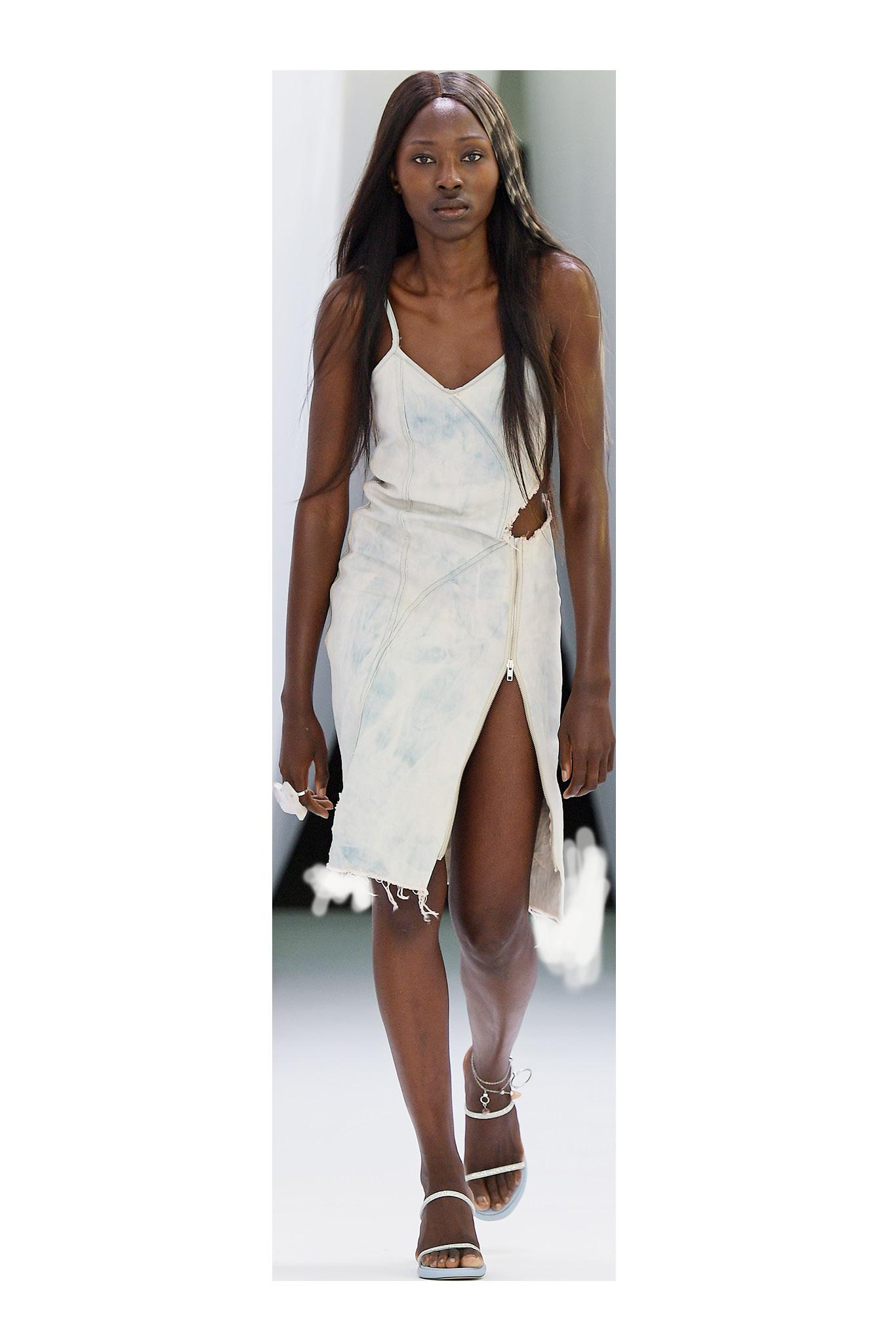
Dark indigo denim provided a foundation to Saks Potts’ vacation-inspired collection spanning ’70s-inspired liquid gold dresses to halter tops and dresses splashed with pink paillettes. Wide-leg jeans hung low on the hips, while denim blazers and matching front-slit skirts were paired with bikini tops. Both jeans and jackets featured deep cuffs.
Operasport styled Y2K-era front-tie cardigans with cropped carpenter jeans and denim miniskirts. Gestuz combined the hallmarks of joggers and cargos into a single pair of anklecinched jeans. A looser version was styled with a metallic silver bikini top, while a light-wash denim dress, cropped jacket and jeans featured crystal accents.


Patchwork denim was a common theme in (Di)vision’s collection. Zip-up jackets with elongated sleeves, slouchy low-rise jeans and
work shirts featured an array of yellow-tinted denim swatches—some splashed with paint. The brand also experimented with printed patchwork and destruction mo-tifs. (Di)vision delved into Y2K with ruched-legged low-rise jeans and destroyed denim.
Latimmier slashed the side seams to reveal whole legs, while P.L.N. remained true to its punk-goth roots by taking an aggressive approach to black denim with monochromatic patchwork, cutouts and rips.
The S/S ’23 collections presented at New York Fashion Week illustrated the varied roles that denim plays in setting trends and forging sustainable partnerships.
Party-ready denim loomed large on the
Prabal Gurung nailed the Barbiecore for grownup aesthetic. From lace-up neon stilettos and Hanky Panky’s peek-a-boo lingerie to tulle frocks styled with black latex gloves, the designer showcased a collection made for nights out on the town. High contrast ’80s-inspired washes highlighted the sharp shapes of a denim bodysuit, bustier top, blazer and miniskirt with an oversize denim rosette.
Pearl baubles, beaded fringe and quilting decorated Pat Bo’s loose-fit jeans and collarless jackets.
A perennial source for maximalist fashion, Alice + Olivia juxtaposed monochromatic chiffon gowns and satin suiting with ’90s-inspired denim in decade-appropriate washes. Items included a denim maxi skirt, bra top, suit with flare denim trousers and a cloudy bleached dress and matching jacket. Elements like crystal fringe trim on cropped jeans and the pairing of a white tulle duster added a bridal element to some looks.
Denim continued to be a key fabric in Et Ochs’ collections. Smatterings of white crystal decorated light-wash shackets, jeans and voluminous opera-length gloves. The Trucker jacket was reinvented as a bolero jacket with souped-up shoulders. A two-tone denim jacket and coordinating skirt offered a more casual look.
Skin was in at Dion Lee’s Y2K-tinged show. Zippers and cutouts accentuated low-rise flare jeans and a denim bustier top. Slouchy low-rise jeans and a pleated denim microskirt were styled with black cowboy boots and black knit tops.
Designers explored denim’s functional side as well. Foo and Foo by Elizabeth Hilfiger nodded to Y2K with workwear signatures. The young label served acid green overdyed
(and oversized) jorts—some decorated all over with hammer loops. The same overdyed fabric was applied to miniskirts, zip-up jackets, baggy jeans with drawstring waists and shredded jeans.

R13 didn’t skip a beat in serving new takes on its signature punk-meets-skate aesthetic. Plaid flannel overalls and dresses, checkerboard print graphics and edgy separates made with gray suiting fabric contrasted with bleachedout denim shorts, cropped wide-leg jeans and vintage blue baggy jeans. Pink also made a strong appearance in the form of straight-fit jeans and destroyed knits, while the prevalence of denim overalls in R13’s collection (with exaggerated silhouettes and washes) make it an item to watch for S/S ’23.
Overalls—with the bib top worn down—were part of Brandon Maxwell’s collection as well. Deep cuffs emphasized the garment’s wide legs.

Layering pieces also dominated the runway. Though simple in design, N. Hoolywood’s

Trucker, cinched coat, pull-over and shacket made an impact with their rich indigo hue. Meanwhile, Khaite applied blown-up proportions to a classic Trucker design.

Denim was a key category for designers looking to add sustainable elements and collaborators to their collection.
Collina Strada founder Hillary Taymour tapped robotics and digital apparel company Unspun to create four pairs of custom jeans for her inclusive runway show. The collaboration marked Unspun’s first appearance at a major fashion week.
The oversized, baggy fit styles were made with GOTS-certified 100 percent cotton 12.5 oz. ecru fab-ric from Candiani and vintage light and mid color 100 percent organic cotton 13 oz. fabrics from Evlox, which were then finished with Tonello’s All-In-One laundry system. Taymour added her own unique touch to the jeans by painting plaid patterns and adding rhinestone embellishments.
European collections threaded denim into their S/S ’23 stories with ease.
Designers aren’t finished experimenting with denim’s core details. Annakiki used frayed and wavy seams to add shape and patterns to jeans, shorts and bra tops. White frays outlined the cargo pock-ets and hems of Act No.1’s indigo pieces.
Burberry ran with denim’s hallmark details. Jackets featured wide cuffs and extra-large pockets. Seams detailed the front of jeans. Jacket sleeves served as belts tied around models’ denim-clad waists.
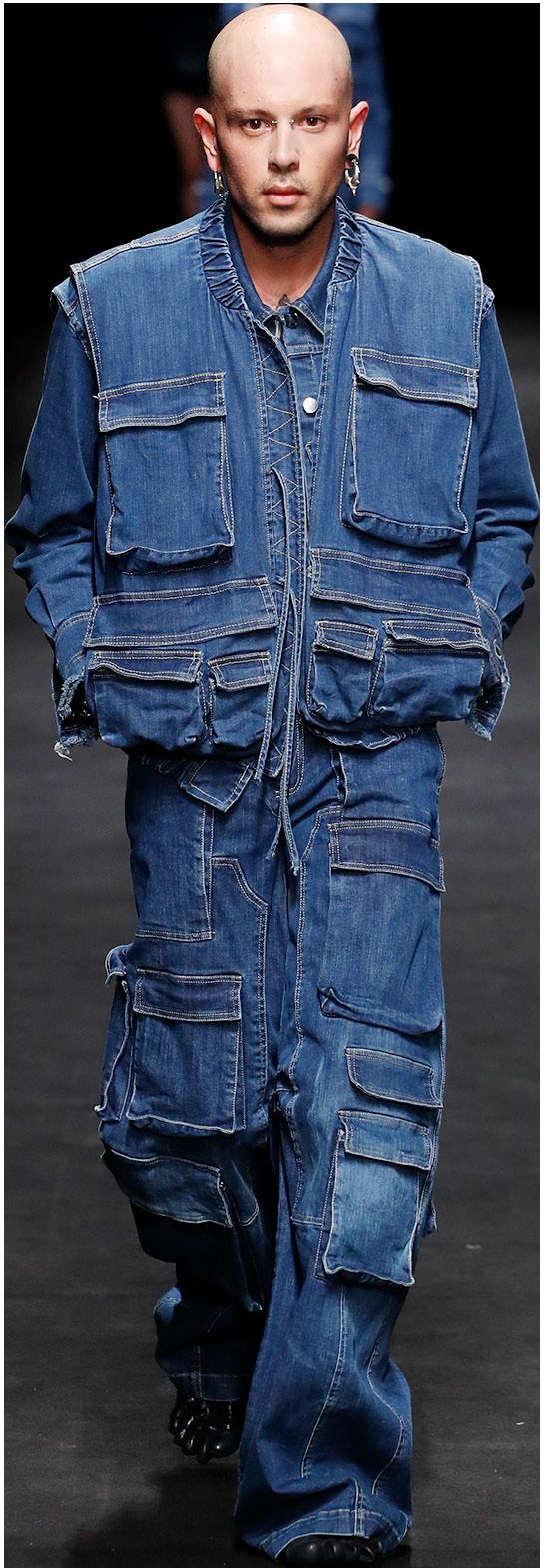
Meanwhile, frayed edges doubled as fringe for Fabiana Filippi’s mix-and-match collection. The line also included denim jackets, jeans and miniskirts in a variety of classic washes.
With an indoor stadium audience of almost 5,000 (including design students), Diesel earned the Guinness World Records title for the largest inflatable sculpture with its 160-foot-wide runway cen-terpiece. The denim was also larger than life with oversized moto jackets, low-sling jeans treated with sun-bleached techniques and shirred corseted jackets and skirts. Frayed edges turned into feather-like trim while the Diesel logo was transformed into a ballgown skirt.
Yellow- and green-tinted washes added grit to collections. KNWLS used the moto-meetsapocalyptic color for its denim miniskirts, duster coats, chopped jackets and body-hugging jeans with split hems. Yellow tints gave Vaquera’s collection of cropped jackets, distressed skirts and low-rise jeans a patina effect. Givenchy applied the vintage wash to denim bras, midi skirts and slouchy jeans, and bleached wash baggy cargo jeans.
Taking a turn from its hyper-girly aesthetic, Blumarine used the dirty-looking wash across its range of goth-tinged denim. Wide wrap belts and brushed gold studs decorated the Italian label’s low-rise flare jeans, shackets, bustier tops, strapless gowns and midi-length dresses. A lace-up, cross-shaped top served as a subversive alternative to the S/S ’22 butterfly top Dua Lipa helped put on the radar of Gen Z fans.
GCDS channeled a similar vibe with a denim bra top with shirred cups. The edgy top was styled with a cutout denim miniskirt held together with a crystal-covered logo. The same shirred effect was applied to the front of jean shorts and a yellow overdyed, back-slit denim midi skirt.
Chloe added large grommets to denim trench coats and jeans with twists seams.
Portrait presented denim pieces in a classic blue wash and embellished with diamante buttons and encrusted bow details. In synergy with key knitwear pieces, tailored denim dresses are finished with a plaited woven trim.
Diamond-like crystals and crystalcovered red hearts with daggers gave Philipp Plein’s denim its signature shine. AZ Factory inlaid jean jackets with Chevonshaped swatches of crystal-covered tex-tiles.
Maje added sweet floral embroideries to high-rise straight jeans, while Paradis trimmed jean shorts with dove-shaped white lace. It also presented relaxed-fit jeans with dove prints.
Collections were also filled with new classics. Bally’s made a denim shirt with snaps looks chic with both wide-leg jeans and a highslit long black skirt. Cormio and Christian Dior kept it simple by pairing low-rise wide-leg jeans with tank tops—a normcore basic making a comeback. Thin leather belts with a chain attachment added a jewelry-esque touch to Etro’s loose baggy jeans.

Low-slung, wide-leg jeans were also part of Drome’s collection. Jeans were detailed with exposed zippers, patch pockets and doublegrommet belts worn around waists and over busts. Likewise, Kimhekim Studios presented a belted denim bandeau top with cinched-ankle jeans.

Sparkle—some subtle, others generously piled on—injected a youthfully feminine vibe. Self-
Bottega Veneta returned with its trompel’œil leather “jeans”. In a cleaned-up take on grunge, the laidback slouchy fits were paired with leather flannel-inspired tops and buttondown shirts.
When it comes to understanding denim, creating denim and helping brands sell denim to their many types of customers, Twin Dragon Marketing Inc. (TDMI) is an expert. The company has more than 40 years of experience working with different brands and divining how certain demographics prefer particular types of denim over another.
Here, Stephanie Poon, director of marketing and merchandising for denim manufacturer Twin Dragon Marketing Inc., discusses how the company markets to different segments of the population while still helping brands maintain their respective DNA.
RIVET: Do you find denim is more segmented in how it is designed and marketed to different generations now than ever before, or do you find there is more overlap?
Stephanie Poon: We find it is more segmented than overlapped. It has been observed in the past that one broad trend would be marketed across the industry, but now there are a variety of trends permeating the market. When the skinny jeans trend was popular and flourishing, all demographics gravitated towards that style.
At present, we are seeing younger generations favor loose, wide-leg, and low-rise aesthetics, while millennials are holding onto their safe and secure high-rise and straight-legged silhouettes. There is still some crossover between generations, but we are speaking on what we are seeing in the majority. We believe the best denim type for anyone is whatever fits and feels the best to that customer, and it is our hope that they feel empowered and comforted by the looks we create.
Twin Dragon has so many denim collections. What are the hottest trends for each type of consumer, from GenZ to Millennials to Baby Boomers for 2023?
S.P.: TDMI is observing that Gen Z leans towards rigid fabric, thicker slubs and textured denim. They also favor more androgenous aesthetics. Millennials are loving comfort stretch denim with vintage-slub character, marbling and finer slubs with a good hand. Baby Boomers continue to like subtle-slub characteristics, stretch, and cleaner, less textured fabrics.
Not all generations view sustainability with equal urgency. Which demographics do you find are most concerned with sustainability and how are you and your brand clients targeting them? What about generations that might be less concerned with it?
S.P.: We are discovering that Gen Z is the most concerned with sustainability, with millennials and Gen X following very closely behind. Our mission as a company is to constantly strive for implementing sustainable measures in new developments. In order to protect the environment, it has to be a collaborative effort with everyone’s contribution, so we educate our brands and clients the same to raise awareness. Some customers request solely sustainable items and some like to see a variety, but we always offer eco-friendly options because we believe it is the future.
TDMI has many processes that add to sustainability, such as biodegradation, water savings, recycled fibers, etc. How do you educate your brands so they can get those messages across to their consumers?
S.P.: TDMI educates our brands through introducing new collections and developments and explaining how new fibers and processes are beneficial to the planet.
Stretch is increasingly in demand, especially during and post pandemic. Are you seeing this across the board or more for older customers?
S.P.: We are definitely seeing stretch items increase across the board, especially post pandemic when everyone has become accustomed to feeling extra comfortable.
Does elastane make stretch denim less sustainable? If so, how do you work around that? Are you using more recycled materials on the front end?
S.P.: We want to make stretch denim as sustainable as possible, and we are definitely using more recycled and sustainable materials on the front end like lyocell, recycled cotton, recycled polyester, biodegradable polyester, hemp and linen.

“We believe the best denim type for anyone is whatever fits and feels the best to that customer.”

Anytime a new cohort of consumers enters the fold, fashion brands know they must stay ahead of the curve. After years of brands tweaking their messages, designs, and values to cater to millennials and Gen Z consumers, the cycle once again puts the spotlight on the newest kids in town: Generation Alpha.
Depending on who you ask, “Gen Alpha” roughly spans children born from 2010 to 2025. This demographic is the textbook definition of “digital natives,” with social media and mobile devices omnipresent throughout their everyday lives, further enhancing their need for convenience and personalization.
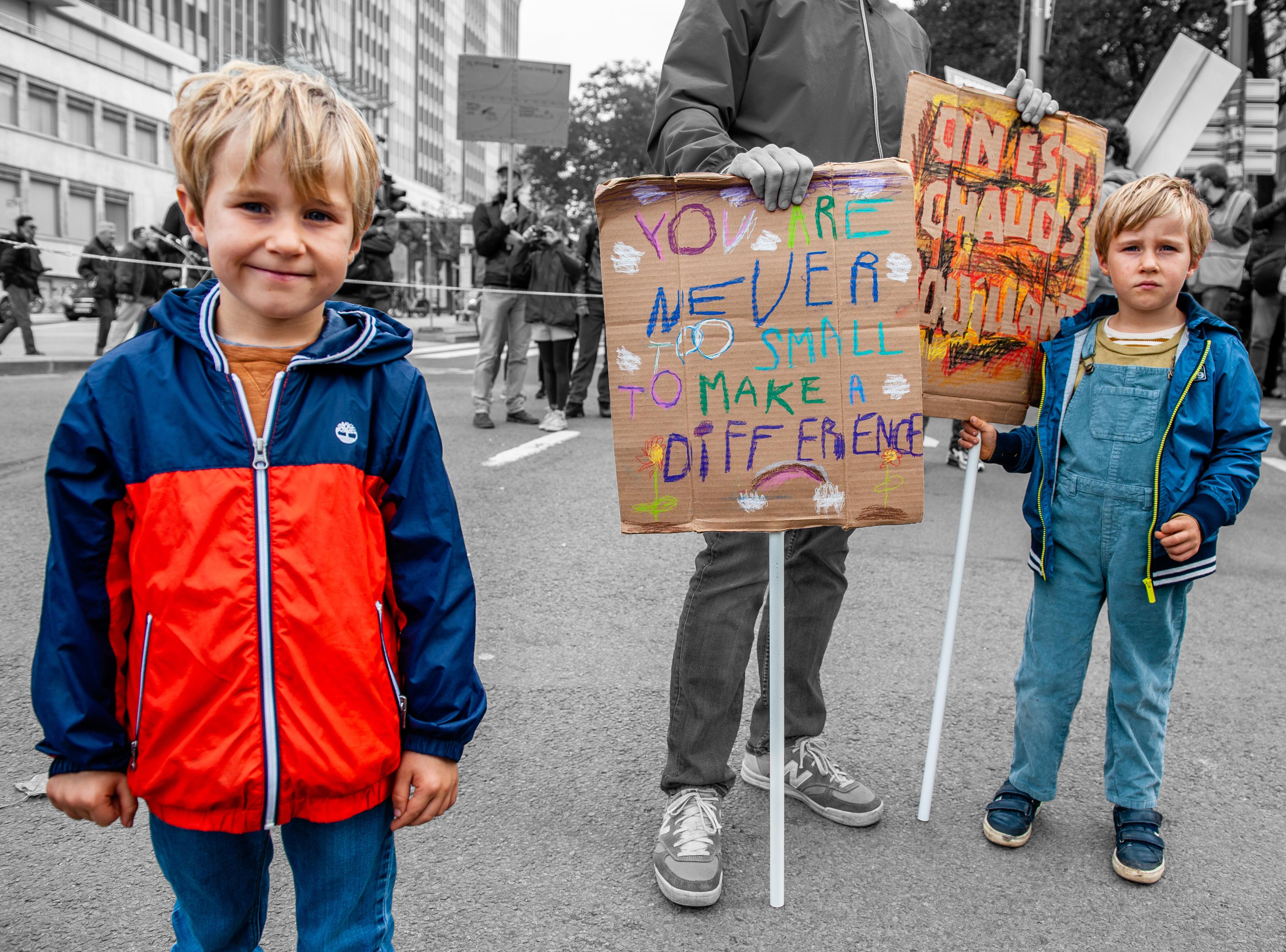
But they also live in a more socially conscious world that is becoming more focused on inclusivity and sustainability—efforts that apparel has already sought to ramp up in recent years.
The demographic is growing rapidly, and as such is a massive growth opportunity for brands that have a firm grasp on them. Sociologist Mark McCrindle, who is credited with coining the term, says that an estimated 2.5 million Alphas are born globally every week and are expected to number 2 billion by 2025.
The children’s wear market is already massive, reaching $260.6 billion in 2021, according to Imarc Group. This number is expected to grow
to $352.4 billion by 2027. According to Imarc, the key factors driving the growth will be highquality premium apparel as shoppers ensure the optimum comfort and safety for their children. The report also points to emerging trends including children’s styles that match their parents, or in some cases, mini versions of dresses that emulate those worn by celebrities.
Regardless of the trend, how exactly is Gen Alpha going to make an impact on fashion retail, especially if they are years away from having any purchasing power? Even though they don’t have direct buying power, they certainly have an influence on cultural norms.
Although older generations may still exhale a sigh at the concept, the popularity of digital platforms like Roblox and games such Minecraft and Fortnite has led many a retailer to throw their hat in the metaverse.
This pool of retailers and consumers that may participate in the arena is only expected to widen, as everyone from Walmart to Nike to Tommy Hilfiger to Vans now has a Roblox presence. The platform presents major growth potential for the fashion industry in a different way, with the company saying that 67 percent of users are under the age of 16 as of 2021.
Morgan Stanley is bullish on the idea of digital fashion gaining prominence and influencing fashion trends, saying it could reach approximately $50 billion by 2030. These virtual clothes could have plenty of runway, especially as Gen Alpha consumers age along with the current platforms they use.

Forever 21, for example, is taking advantage of ways that could benefit both the digital and physical realms. Users and creators can create their own storefronts on Roblox where they can buy and sell physical and virtual merchandise and participate in monthly drops.
While the fast-fashion retailer sold 1 million units of its virtual Forever Beanie, further illustrating the platform’s ability to generate positive fashion buzz, it also now has a potential funnel for more ideas for real apparel.
“Then the question for us is, ‘Should there be a real Forever Beanie? And how do we collaborate further with creators on these great ideas?” said CEO Winnie Park at the Retail Influencer CEO Forum in September.
Gen Alpha also has an altruistic side. According to Wunderman Thompson Commerce, Gen Alpha is seeking to make a difference in the world, and their favorite brands reflect that. Of 4,000 children interviewed aged six to 16, twothirds (66 percent) said they want to buy from brands that have a positive impact on the world.
“Of all the issues that could inform the values of today’s children, environment and sustainability loom the largest,” said Hugh Fletcher, global marketing director, Wunderman Thompson Commerce. “The generation of Greta Thunberg and school climate strikes is already telling their sometimes-bemused elders loudly and clearly—the environment matters to us, and we demand action to safeguard its future.”
Education about climate change in elementary schools has certainly raised awareness, putting retailers in a role where they need to look ahead when it comes to sourcing eco-friendly materials and implementing more sustainable production practices such as regenerative agriculture. According to McCrindle, 81 percent of parents say their Generation Alpha children have influenced their actions or consumption decisions, making them more environmentally aware.
“The most important message is much deeper than trumpeting your green credentials to appeal to kids,” Fletcher said. “It means that Alphas want to be engaged with on issues that matter to them. Sustainability is certainly part and parcel of that, but the bigger picture is that Alphas are unlikely to view the things they buy as simple commodities and the places they buy from as commercial production lines. The indications are that they will want to know the stories behind what they buy and engage on a deeper level.”
If Gen Alpha’s elders are any indication, the future of fashion may be gender-neutral.
In October 2021, California became the first U.S. state to require retailers with more than 500 in-state employees to maintain a genderneutral section for childcare items and toys. Set to go into effect in 2024, this law does not cover children’s clothing. But it does illustrate the mindset shift that is occurring and its impact on commerce trends and what consumers are demanding.
California’s own PacSun launched a gender-neutral children’s clothing brand, PacSun Kids, that same year. The kids’ collection ranges in sizes from 4 to
14 and carries everything from graphic tees to fleece sweats to outerwear to swimwear. Last November, the lifestyle apparel retailer launched its first genderfree kids’ clothing store in further illustration of its commitment.
“The kids’ market is saturated in brands that cater and market specifically to either boys or girls, but very few brands explicitly design, dress, and market with an emphasis towards ‘gender free’ dressing and a ‘fully inclusive mindset,’” said Brieane Olson, president of PacSun, in a statement upon the launch. “This is at the heart of why we chose to start PacSun Kids now. We want children to have the freedom to express themselves as individuals, dress how they feel most empowered, and be their true unique [selves].”
Caption
In Canada, outdoor lifestyle brand Roots has sought to cover ground across genders and sizes with its One Collection, which crowdsourced consumer preferences and based the line on the try-on experiences of 50 consumers, all of whom varied in size and gender.
“When we think about the omnichannel concept of wherever, however, whenever you want to shop, that should also apply to the products that you want to shop for,” said Meghan Roach, CEO and president of Roots. “In our research, we found that we had a lot of female customers shopping in the men’s section. We also had a lot of nonbinary and transgender customers who were shopping with us.”
Inclusivity in general is becoming more of a need within the kids’ apparel space, with consumer insights platform Getwizer reporting that only 50 percent of parents would label their kids’ size as “regular.” The other half of parents define their children as either tall (24 percent), short/petite (13 percent) or plus-size (11 percent).
“Children are facing a lot of different things when they go to school. How do I make friends? How do I deal with social media?” Roach said. “We want them to feel comfortable in their own skin and comfortable in the clothing we’re offering them.”
“We want
have theGen Alpha is plugged into the latest digital technology.
Each denim garment gives a voice to the cultures of yesteryear, but also holds an unsung promise of tomorrow, according to Zennure Danisman, marketing and washing manager, Orta. Here, Danisman shares how the Turkey-based mill manufactures denim with unlimited creative freedom in mind, based on the mentality that one fabric can be applied for many uses.
RIVET: Are you producing denim differently based on what different generations of consumers are interested in?
Zennure Danisman: When we produce fabric, what we really want to create is an abundant fabric of life that fits the needs of all generations. We believe denim is a cultural movement in fashion that fits between the old and the new.
ORTA fabrics are timeless and full of vitality, reflecting a colorful past and a vibrant future—blended for longevity, to be worn by everyone, with future masterpieces in mind.
How are you working with brands, or what tools are you giving them, to help them spread the word of sustainability?
Z.D.: First of all, we have been conducting our life cycle assessment (LCA) studies for the past five years. We do circularity studies of our own products and share this data with brands and designers in a transparent manner, especially with QR codes that we integrate within our products. We also have an application called ORTA BLU, which we developed in line with the LCA studies, to share our sustainability data with consumers through more digital methods.
Additionally, we have developed a design guide to help the designers in order to ask the right questions from the first stage of the design, because we believe sustainability starts from the design.
Have you introduced any new fabrics within your denim collections?
Z.D.: We want our denim to match with the needs of different markets so it can keep its importance in different consumer demographics. We mostly focus on making
fabric that does it all with unlimited creative freedom, representing a modern “life wear” mindset that demands one fabric for many uses. If possible, this one denim would cater to today's genderneutral style of texture and character in every shade of denim for unlimited possibilities.

In addition to providing unlimited possibilities with ORTA fabrics—since comfort is an important need—we have created our Endorphin fabrics that can shape to a body without compromising for comfort. The fabrics celebrate body neutrality, shape neutrality and even gender neutrality. Endorphin has been built for diversity and to provide wider usage.
Can you talk about your newest collection you debuted at Kingpins?
Z.D.: ORTA’s new IMAGINUS collection advances our BLUESKY mission by using alternative solutions—from regenerative fibers to wood and mineral-based coatings. This is a new generation of denim possibilities that makes every piece of ORTA fabric an actionable solution for today’s eco-stressed world. At ORTA, it is in our DNA to be in a constant search for innovative solutions for a better future of denim. IMAGINUS furthers our commitment to generativity, ingenuity and community—and BLUESKY innovation as the optimistic path towards a net-positive denim reinvention.
What trends in denim are you noticing around Gen Z vs. millennials? Does this vary from older consumers? Is denim segmented by age group?
Z.D.: ORTA launched the #Y2K concept with rigid character and forever denim looks, remixing lo-fi and retro texture. Although it’s called #Y2K that addresses the millennials, it’s a perfect match for Gen Z who looks for rigid denim with wider relaxed-denim fits.
On the other hand, ORTA’s BLU DOPAMINE addresses the “dopamine denim dressing” that both Gen Z and millennials are seeking. As consumers aim to escape climate anxiety, the collection enables them to feel the pleasures of joy, self-expression and control. It addresses both the comfort needs of Gen Z and the performance denim needs of millennials.
“Denim is a cultural movement in fashion that fits between the old and the new.”
growth for kids’ jeans right now compared to last is in mass stores, she added.
Value remains a key driver in consumers’ purchasing decisions for children’s denim. Looking across all mass and value retailers tracked by retail intelligence firm Edited reveals a mix of pureplay and own-brand offerings. Top stockists include Shein, Levi’s, OshKosh B’gosh, Rainbow and Gap. So far this season, Katherine Bailey, Edited children’s wear analyst, said the $25-$30 price bracket is the most popular range for full-price children’s denim, accounting for 26 percent of all denim products.
words _____ANGELA VELASQUEZAfter being steamrolled by loungewear in 2020, new fits and trend cycles coupled with the reopening of workplaces gave men’s and women’s denim brands new leases on life in 2021. Jeans generated $18.4 billion in U.S. sales last year, an increase of 36 percent over the prior year, and a 9 percent increase over prepandemic levels in 2019, based on Consumer Tracking Service data from The NPD Group. Sales for women’s jeans increased 9 percent and men’s increased 12 percent versus in 2019.
With many of the themes that helped reinvigorate the men’s and women’s categories trickling into kids, Maria Rugolo, NPD apparel industry analyst, said there’s room for growth in the children’s denim market. Children’s jeans account for 10 percent of total jean sales for the 12 months ending August 2022. “This is not performing to its potential as kids account for 14 percent of total apparel sales,” she said.
The kids’ denim market—which NPD defines as girls 13 and under and boys 14 and under—accounted for over $1.8 billion in U.S. sales revenue. Unit sales are down 11 percent versus last year, however, Rugolo said children’s jeans revenue is down just two percentage points due to higher average selling prices.
The bright spot for both dollar and unit sales
While mass retailers receive most of consumers’ denim dollars, online and direct-toconsumer channels have become a crucial part of brands’ businesses, especially as the children’s independent boutique business inches closer to extinction with each financial crisis. A quarter of revenue for children’s jeans is spent online, according to NPD. While online revenue is down two points from last year, Rugolo said it is still higher than pre-pandemic levels.
DL1961, which offers premium denim for sizes 2T to girls’ 16 and boys’ 18, said its direct-toconsumer digital channel continues to grow year over year. Likewise, heritage brand and Carter’s Inc. subsidiary OshKosh B’gosh is seeing the most success in its own physical stores.
The popularity of children’s denim has long been tested by leggings and athletic apparel, perhaps even more so than its adult counterparts thanks to the bottoms’ array of colors, prints, and licensed characters, and their mix-and-match appeal. However, the pandemic and subsequent school closures and social distancing amplified this demand for the comfort-driven, sizeforgiving, elastic-waisted staples.
“The pandemic impacted us in 2020, as kids were homeschooled and wearing sweats and leggings,” said Sarah Ahmed, DL1961 chief creative officer. Despite their offering of jeans

In a post-pandemic world, the children’s denim market faces its own host of challenges and opportunities.
made with “ultra-soft fibers and stretch,” the New York City-based brand saw their sales shift from blue jeans to joggers and comfort knit styles during covid.
“I think kids and parents got used to being more comfortable in what they are wearing with covid and staying at home,” said Louise Vongerichten Ulukaya, founder and CEO of the “Made in Portugal” children’s brand Mon Coeur. “Consumers are looking for comfortable denim options for their kids, and the traditional rough denim is probably not as popular as it used to be.”

Mon Coeur’s solution for kids’ sizes 2-8 has been straight cut gender neutral shapes—which Vongerichten Ulukaya said are both stylish and practical—and pull-on jogger styles for babies. Garments still have to look good, however. “That has not changed, everyone wants to feel good in what’s there are wearing, and this is why our denim has done so well,” she said.
Like what Zoom did to office attire, virtual schooling forced kids’ brands to evolve to suit their customer’s changing preferences. “Competing with the booming loungewear market meant integrating details that enhanced wear, like elasticated waists and soft linings, and merging shapes to create hybrid options like denim joggers,” Bailey said. “Where hardwearing fabrics were once a priority, now comfort and ease of movement ranked highly.”
Indeed, OshKosh is seeing a new trend in boys with the consumer leaning towards pullon styles with a functional drawcord over the traditional 5-pocket styling, said Zia Taylor, OshKosh B’gosh VP of design. The heritage brand’s Fall 2021 collaboration with Kith Kids— the streetwear retailer’s first partnership with a children’s apparel brand—centered on tees, crewnecks, hoodies, and sweatpants with rinsewash denim overalls, jeans and jacket making up a small fraction of the overall assortment.
However, a year later the OshKosh consumer is finding comfort in looser denim fits, creating new opportunities for the brand outside the skinny jean/jegging cycle. “Slouchy and relaxed denim fits paired with tees and with a denim jacket are always a win,” said Carissa Atkins, OshKosh B’gosh senior director of merchandising.
Similarly to working from home for adults, Kendall Becker, fashion and beauty trends editor at Trendalytics, said the kids’ denim market saw a lag during peak pandemic years. “With that being said, the interest has been revitalized, not only from a trend standpoint but sizing, too. Newness not only is a want but a need for many, especially for kids as they’ve grown over the remote years to back in-person. All in all, these factors give confidence in the growth of the category,” she said.
DL1961 is already seeing the tide turning back in favor of jeans. Once schools began to open back up, Ahmed said the company “saw a massive uptick in overall denim sales” and
business bounced back from covid within one year. Ahmed said the company is on track to end 2022 as our strongest year to date. “With the trends changing so quickly and the demand for wider leg options, we have been a key resource for our retail partners,” she said. “Denim is definitely having a moment right now.”
To understand what’s trending in the children’s category, one only needs to look at the women’s and men’s markets for clues.
“Trickle-down from the men’s and women’s wear market plays a significant role in children’s denim trends, with runway-informed narratives like Y2K, collegiate/preppy, and grunge showing influence,” Bailey said.
However, the approach to trends is softer in children’s wear. Becker said more approachable iterations hit the market on a later timeline after it has resonated with the more mature counterparts.
For boys, Edited’s data shows that “commercial silhouettes” like slim and straight jeans are being updated with baggy and relaxed styles that reflect a move away from restrictive shapes. Boys’ jeans with utility details like patch pockets are also picking up momentum this fall, following “the cargo pant revival,” Bailey said.
Echoing Edited’s data, Ahmed said DL1961’s best-selling styles for boys are its new utility joggers and hooded jackets. “Cargo pockets and utility detailing have been a big trend in boys,” she said. “We also do very well with our classic
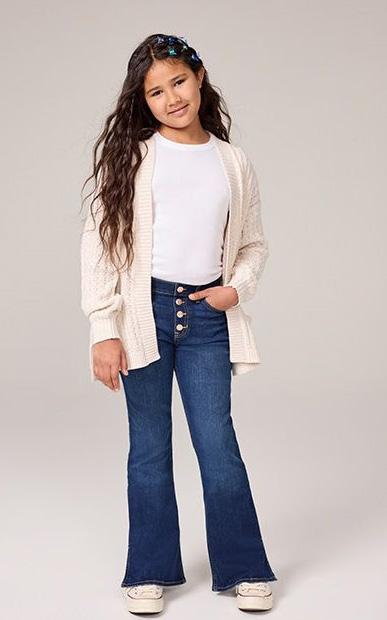
slim legs, especially our navy and khaki twills for back-to-school shopping.”
There’s also been an interest in “mommy and me” dressing across categories, Becker said. The search volume for “mommy and me” is high at 12,000 average weekly searches and an average of 263 social media posts a week.
Parents’ nostalgia for Y2K fashion as well as the era’s panache for glitz and novelty designs make it a perfect match for girls’ denim. Edited named the era’s signature fits—wide-leg and flare jeans—as fits to watch.
DL1961’s trends for girls closely mirror its women’s business. The new Emie High Rise Straight has been a best seller across all department stores and its new Lily High Rise Wide Leg is “gaining a ton of momentum,” Ahmed said. Though the brand still has a solid business with fall staples like classic miniskirts and skinny jeans.
OshKosh B’gosh saw consumers gravitate to its core denim assortment during the back-toschool season, stocking up on skinny, straight and relaxed fits for boys and skinny, super skinny and jegging fits for girls. However, the denim trends for adults are the source of excitement for the heritage brand, which is seeing higher rises, flare fits, wide leg and relaxed fits trickle into children’s wear. “For girls, we are seeing a lot of consumers purchase our flare silhouette style,” Atkins said.
Wider legs are becoming a norm across girls’ assortments, Becker said. The style is up 24 percentage points in average weekly searches compared with last year. “As we know, skinny jeans and leggings, especially in children’s, were the standard and that’s certainly shifted,” she added.
Though the color palette remains overwhelmingly in favor of tones of blue, Edited’s data shows retailers are venturing into more experimental aesthetics, arriving in
brown, neutral and pastel tones.
“Colored denim is also having quite the resurgence with colors like sage, mauve, butter yellow and steel blue owning this trend,” Becker said. “This is one-to-watch as its most saturated in the women’s luxury market at the moment, making it a key indicator of the trend trickling down.”
Variations of washes are driving boys’ trends, she added, noting that grey stonewash, acidic olive green and distressed blue are leading new arrivals.
Digital-native kiddos are also turning to social media for style inspiration. Becker said the age of social media influencers is increasingly becoming younger which provides a correlation to the wants of their audiences.
“The normality of influencers in the children’s wear market is more important than ever with increasing access to social platforms that didn’t exist prior,” she said. “Kids can keep up with their idols in real time rather just in magazines or on the television as in generations past.”
said Kelly Hall, senior vice president and general manager of Abercrombie Kids.
Edited has also tracked “exponential growth” in the number of jean multi-packs in stock across the last three years. Bailey said numbers more than doubled from 2021 to 2022 “as a result of significant uplifts in options” at retailers like H&M and The Children’s Place. Jeans sold as a two-pack is the most common pack size, accounting for 56 percent of intake. However, she said bundles extend to encompass as many as five pairs.
“The dramatic market expansion of multi-packs will favor cash-strapped consumers seeking cost-effective purchases, while retailers will benefit from higher overall order values and slashed packaging costs,” she added.
VONGERICHTENThe children’s category also brings its own unique opportunities.
Bailey said “significant strides” have been made recently in children’s denim by Abercrombie & Fitch, which introduced a sizeinclusive collection for kids in July. Though size inclusivity has been a dominant conversation in the women’s market, the children’s denim market lacked a leader until now.

Designed based on feedback from more than 1,000 customers and following two years of fit testing, the entire range features inbuilt waistband adjusters and includes short, regular, and long lengths to ensure as accurate a fit as possible.

“Age is just one factor in finding the right fit, but by introducing multiple lengths, expanding the size range, and including waistband adjusters in every pair, kids can now enjoy the same experience as adults: find a waist size, find a length, and enjoy their comfiest denim fit,”
Packs work in children’s brands’ favor because demand for constant newness has less importance in the category compared to men’s and women’s. The slower pace of trends allows brands to invest more in quality and production. Whereas many brands license out their children’s ranges, DL1961’s vertical operation allows the company to produce its kids’ jeans in-house, utilizing the same fabrics featured in the men’s and women’s collections. “This sets us apart in the market,” Ahmed said.
As important as sustainability is, Becker said Trendalytics is seeing a downturn in searches for sustainable fashion across all categories. Searches for the term are down 40 percent in average weekly searches compared with last year.
The right consumer, however, appreciates children’s brands with a sustainable backbone. “We are one of the few kids’ denim brands in the market right now that is sustainable and ecofriendly. This appeals to the millennial mom who is conscious of the environment,” Ahmed said.
Though DL1961 strikes on the right trends and fits, the brand prioritizes recycled and renewable fibers, clean dyes, ozone and laser finishing technologies and produces in solar power and energy-efficient closed-loop manufacturing facilities. The brand recently introduced Recoverbranded recycled cotton fibers in its men’s and women’s ranges and is currently discussing adding it to its kids’ range in future seasons.
“Sustainability is a huge selling point for DL1961’s wholesale partners and consumers,” Ahmed said. “Consumers care about the environmental impact and want to invest in sustainable clothing.”
“Parents and kids got used to being more comfortable in what they are wearing..."
—LOUISE
ULUKAYA, MON COEURMon Coeur OshKosh B'gosh
Keeping up with consumers isn’t always easy—but it’s an imperative for any fashion brand to survive. That pressure is magnified at the mill level, where manufacturers must produce the exact fabrics and garments that their brand partners will need to keep coming back.
Aydan Tuzun, executive director of sales and marketing, Naveena Denim Mills, told Rivet about the company’s recent fabric production, and how the business continues to stay ahead of changing consumer demographics.
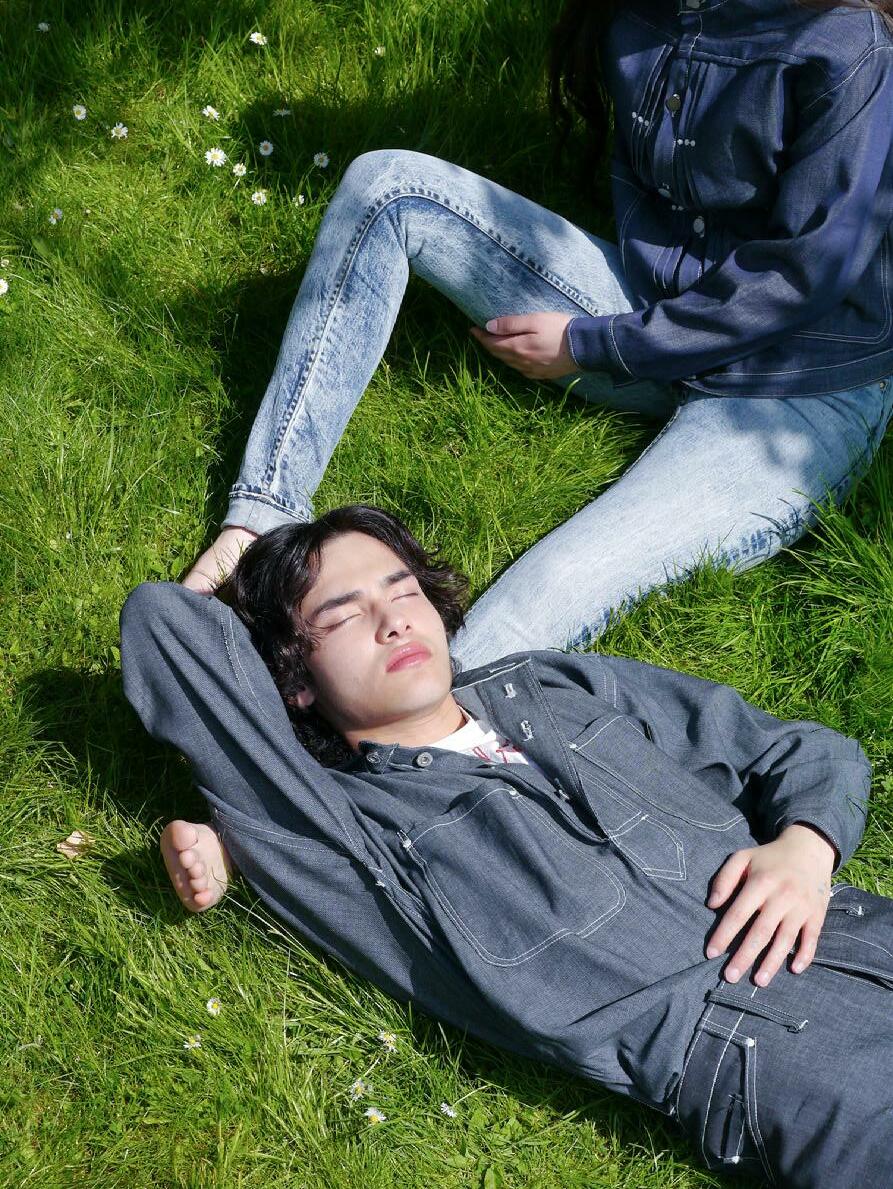
RIVET: What trends in denim are you noticing around different generations of consumers?
Aydan Tuzun: We notice lately that new generations are more interested in authentic and rigid looking denim fabrics, with a modernized performance in terms of comfort. We see a difference between men and women though; men are inclined to more stretch fabrics whereas women prefer rigid looks. Sustainable fabrics are also an ever-increasing interest for the younger generation. Among older consumers, comfort and more classic looks are still the trend.
Are you introducing any new fabrics within your denim collections, and are you tailoring them to various consumer demographics?
A.T.: We are constantly introducing new fabrics, tailoring them to different demands in the market around sustainability and function.
In terms of sustainability, we have recently brought a new natural fiber to the market refined with a waterless process. Designed in collaboration with Circular Systems, BIOTECH fabrics are made with natural fiber derived from CBD hemp crop residue and refined into textilegrade fiber called Agraloop™ BioFibre™. The end result is durable, low-impact fabrics with unique natural fiber aesthetics.
In terms of durability and function, DUALISTIC fabrics address a large consumer demographic, as they combine outstanding stretch and cooling characteristics, with an authentic denim look and touch. Designed in collaboration with The LYCRA Company, they offer very low growth and shrinkage, no bagging and sagging and 2-3X better strength values compared to cotton fabrics.
Can you talk about the newest collections Naveena Denim debuted at Kingpins?
A.T.: Our newest collections represent where the market is headed in terms of consumer expectations, brands’ focus areas but also our planet’s needs.
Our most sustainable fabric, the HOLISTIC DENIM collection, represents the combination of the most conscious raw materials and processes, and always has new additions. ORA I83 fabrics are a product of eco-friendly raw materials and the best sustainable practices in indigo dyeing and finishing processes—a cutting-edge combination of Aqualter, Ecolean in indigo dyeing and H2NO for finishing—using less water and energy and fewer chemicals.
We also offer fabrics such as RETRO-SOFT—which has an authentic and marble look with a super soft touch thanks to TENCEL™ blends—and our mechanical stretch technology MECHA-STRETCH. Both reflect the trend towards vintage, authentic and rigid fabrics which also offer wear comfort and softness.
Mid and high-stretch fabrics are also keeping their place in our collection. Fabrics from our SCOPIC, FLEXITECH and SELF-FIT collections offer 35-100 elasticity, and are in high demand.
How has Naveena Denim helped improve labor/worker conditions across its mills? Are you seeing younger generations showing more concern about worker treatment?
A.T.: Younger generations are concerned with people and the planet. They want employers who care about their well-being and who support diverse and inclusive workplaces.
At Naveena, our primary aim is to create positive impact for all our stakeholders, including our employees, in line with Sustainable Development Goal 8: “Decent work and economic growth.”
We do this by focusing on occupational health and safety and organizing training for continuous career planning. Upon recruitment, we provide all the necessary information regarding freedom of association, medical coverage and other issues related to our employees’ and their families’ well-being in a Workers Rights and Obligations Handbook.



Teen denim retailers prepare for holiday with new fits and digital storytelling.
 words _____VICKI M. YOUNG
words _____VICKI M. YOUNG
Inflation is having an impact on discretionary apparel purchases, including denim. However, the worsening macro environment is hitting younger consumers more than their older counterparts, a trend that was brewing even before the start of the back-to-school (BTS) selling season.
While inflation is expected to pressure sales for holiday, teens are still buying denim—only now they’re opting for wider legs and Y2K styling.
HSBC Global Research reported in August that weakening demand and high inflation likely led to inventory building, creating a challenging backdrop for the tail end of the third quarter and heading into the final reporting period of the year. While the report targeted BTS sporting goods, it has implications for the mindset of the younger consumer cohort—a trend that became evident during the second quarter earnings season.
Skate, surf and snowboarding retailer Zumiez Inc.’s CEO Rick Brooks said during a second-quarter conference call in early September that the results “fell short of expectations” due to a sales shortfall impacted by inflationary cost pressures. Zumiez sells a range of denim bottoms and jackets for young women and men by Dickies, Vans, The Ragged Priest and more. Brooks noted that product margins remain strong, but also said that the retailer’s experience is that “we lead into [recessionary cycles] given the discretionary nature of our business and the impact of tough economic times on our customer base.”
Zumiez’s CFO Chris Work said inflationary pressures have resulted in consumers shifting from higher-priced brands to value-oriented offerings, such as the retailer’s private label
line. Looking ahead to the fourth quarter, Work said the market is “going to continue to be tough based on the current trend lines.”
The trends were no different at Zumiez’s competitor Tillys, which sells Levi’s, Volcom and Free People as well as its house label RSQ. In a second-quarter conference call in early September for the three months ended June 30, president and CEO Ed Thomas said traffic and conversion [to sales] declined as customers faced the “highest inflationary environment of the past 40 years.” The comparisons also were impacted by last year’s record-setting results fueled by federal government stimulus payments.
Thomas noted that some selling periods such as BTS always seem promotional, particularly in denim. “Our long bottoms
business has been pretty good, denim not so great,” Thomas said.
Tillys CFO Michael Henry said the retailer is “contemplating a slowdown” going forward as its early BTS sales show declines of more than 20 percent when he spoke in September during an earnings conference call. But he also said that while Tillys is expecting more challenges ahead, that could shift if “normalized holiday shopping patterns return.”
American Eagle Outfitters (AEO) has been long considered a denim destination for BTS. According to Jen Foyle, president and executive creative director for both AEO and intimates sister brand Aerie, the buzz is building for
newness and innovation across silhouettes, wash and color.
For women, she said best-sellers are AEO’s “strigid” jeans, or styles made rigid fabrications on the front and stretch fabrications on the back, as well as wide-leg and baggy fits. Cargos, athletic and straight fits are trending in men’s. Denim jackets are a fashion staple for AEO customers, and Foyle said with Y2K styles trending, “we are playing with new silhouettes—from shrunken to oversized.”
Foyle said heading into cooler weather, AEO’s customers gravitated toward cleaner styles, although “destroyed and wider leg shapes continue to drive the business.”
Over at PacSun, women’s and men’s denim and casual pant range saw “encouraging results” in BTS, according to Brieane Olson, the brand’s president.
“Our best-selling styles across both genders included looser silhouettes (baggy and extremely wide) in a range of indigos. In women’s specifically, flare and boot were top-performing fits. We saw interest in color as well as corduroy, in a range of silhouettes. Cargo pants in a multitude of fabrications (twill, nylon, canvas) and other casual bottoms continue to uptick from a trend perspective, accounting for about half of our range in both genders,” she said.
“With this, we believe it is a balance of assortment that ultimately wins with the consumer and are pleased to offer a range of silhouettes and washes to address varying customer needs,” she added.
Sustainable fibers are sources of newness for Aéropostale. “For both guys and girls, sustainability in our denim and fabric innovation continues to grow through our Aero Impact assortment,” said Natalie Levy, the teen chain's CEO. “Each Aero Impact style is responsibly made with hemp, organically grown cotton or recycled materials, ranging from recycled cotton to Repreve recycled polyester yarns to the latest CiCLO stretch denim.”
For girls, fashion denim growth has been driven by ’90s fits and flares, which Levy said are up 87 percent compared to last year. For guys, denim growth has been driven from the skinny and slim categories, which Levy said are up 18 percent to last year.

Retailers are gearing up for the important holiday season, and they’ll be keeping tabs on what’s resonating with consumers to ensure they have the right looks and trends heading into 2023. While Levy expects to see items like jeggings downtrend, the retailer anticipates that its men’s athletic fits segment will see an uptick going into holiday.
“Denim is the foundation of our business every season,” Foyle said. “For holiday, we are excited to pair seasonal fashion and heritage looks—like sweaters, fleece and cords—with
Denim fits and styles are constantly rising and falling in popularity. One place to see where trends are headed is trade events like Informa Markets Fashion’s contemporary shows PROJECT and COTERIE, which assemble a range of global labels, including Hudson, Joe’s Jeans, Levi’s and Mavi. Here, Edwina Kulego, vice president of PROJECT (men's), and Courtney Bradarich, vice president of PROJECT (women’s), share what's shaping denim.
longer the denim default. Gen Z is a very aesthetically focused group, but they also don’t want to compromise comfort, which is one reason why looser denim styles have remained so relevant.
You’ve said that the future of fashion lies in technology and sustainability. How are these two forces shaping consumer demands, and how can companies best meet these expectations?
Edwina Kulego: Sustainability is really about a company’s commitment to improvement. Brands who are leading the charge are communicating their sustainability and technology efforts in an authentic way to their consumers. Gen Z and millennials are making informed decisions before adding a product to their shopping cart, therefore the companies that lead with transparency will ultimately have the most influence on these generations.
From a sustainability standpoint, one of denim’s benefits is its timelessness. How can the industry create jeans that last so they can be passed down to new generations or take on multiple lives via resale?
E.K.: Creating quality denim is essential to sustainability. Timeless pieces are the ones that develop a new wash over time and may even lose a button but remain intact. Construction and craftsmanship are a key part of the process.
C.B.: Trends are cyclical, and we can expect to see many of the styles we’re seeing now, such as baggier fits and two-toned details, resurface in the future. The sustainability measures that some of the denim brands are taking now will surely resonate with the future generation consumers who will be purchasing them via resale.
Informa Markets Fashion’s shows have spotlighted genderneutral fashion, but what does this mean specifically for denim? How is this shaping the design, production and retailing of jeans?
RIVET: Through your shows, you have your finger on the pulse of trends. What do you see as the major denim styles for 2023?
Courtney Bradarich: Oversize is still king in womenswear and denim, and we’ll continue to see unique interpretations of the American classic into 2023. The cargo trend that we’ve seen plastered all over social media the past season will present itself as a big denim trend, and we will still see that much looser, almost trouser-style fit in traditional washes as well. The baggy styles will be going lower and slouchier, which is something that might be hard for millennials to quickly adapt to! Less predictably, we’ll see novel details like the asymmetrical waist as well as other features like multitoned denim. And just when we got comfortable with the micro mini trend of 2022, fashion is keeping us on our toes with the introduction of the denim maxi skirt, which is bound to become more prevalent in 2023.

Just how varied are the denim desires among different generations? Is there as much of a style divide as social media discourse suggests?
C.B.: There does seem to be a generational difference in style preferences for denim, though I think millennials and Gen X have now bought into the wider and baggier leg that Gen Z stands firm on. There will always be a place and styling moment for skinnies, in my opinion. Skinny jeans are a seasonless classic, but they are certainly no
E.K.: The denim industry has been a leader in gender inclusive fashion and styles for years. It primarily lies in the construction and cut of the denim, creating styles that any person can wear and making it one of the most versatile pieces of clothing on the market.
“Brands who are leading the charge are communicating their sustainability and technology efforts in an authentic way to their consumers.”Photo credit: Hailley Howard @hailleyhoward
our signature AE jeans and denim jackets.”
Bottoms is where the business is for PacSun. “We are excited about continued trend excitement in bottoms,” Olson said. “Across both genders and in our unisex range, we anticipate amplified consumer interest in cord, color and emerging wider leg silhouettes. In women’s, we have begun to see new trends emerge in skirts, ranging from mini to maxi lengths.”
The holiday season presents new opportunities for retailers to connect with teen consumers through key marketing platforms like TikTok and the metaverse.
For holiday, American Eagle will meet its customers on TikTok, Snapchat and Roblox’s
Livetopia. “AE was one of the first retail brands to launch a BeReal account which will be used to highlight our top holiday picks this season,” Foyle said.
Tyler MacDonald, PacSun’s senior manager of influencers and social media, said the company is focusing on community building for holiday. Through TikTok, PacSun gives users get an inside look into the brand in a natural and non-intrusive way.
“Our audience, our community, and our employees are the next wave of influencers, and we are creating playful, relatable, and organic content that showcases them while highlighting our product, giving behind-thescenes access, testing unique sounds and filters, [and] much more,” he said.
In addition to furthering PacSun’s partnership with Roblox to release a holiday shop and clothing, MacDonald said the chain is also offering more virtual try-on experiences with partners like DressX, and collaborating with both real-life and virtual influencers that speak to young consumers, such as Miquela.
Levy said Aéropostale enhances its regular TikTok strategy with additional programming during key shopping seasons like holiday. “Along with our own branded content, each season we work with a diverse group of creators to bring our clothing to life through their unique style lenses,” Levy said.
The chain will continue to expand its digital-first approach to connect with Gen Z, as well as be in the metaverse in 2023.

With consumers' desire for trendier and sustainably produced clothing increases, Artistic Milliners has designed new fits and fabrics—in addition to partnering with regenerative recycling plants—to keep pace.
Here, Baber Sultan, Artistic Milliners director of research, product and trend, tells Rivet how the company is ramping up solutions and innovations to cater to consumers’ needs and wants, while also increasing its sustainable initiatives.
RIVET: Since its inception, Artistic Milliners has spearheaded denim innovation and sustainability, continually pushing the boundaries of what a pair of jeans can be. What tools are you giving brands to help them spread the word of sustainability?
Baber Sultan: Ecological equity drives everything we do, and we go out of our way to help partners communicate this to the end consumer. For example, we enable them to communicate our green technology—also known as clean technology—credibly and confidently through products such as biodegradable jeans in our Biovision and Recircular lines, which are made entirely of recycled materials from our Circular Park facility.
We also help our brands by making our cotton supply chain transparent and traceable through our partners at Retraced, an all-in-one platform helping fashion and textile companies gain full transparency, and by making sure our facilities are Fair Trade and USGBC LEED certified. This helps their conscious consumer feel better about the provenance of the product.
How does Artistic Milliners keep up with different generation’s fashion trends while also remaining sustainable? What are you doing to help retailers cater to different generations?
B.S.: It helps to have a robust, end-to-end vertical infrastructure that has green technology at its core. By doing so, we can use our trend-casting expertise and retail intelligence platforms to produce efficiently and equip our touchpoints—in Star Fades International Los Angeles and Mexico—to wash and finish the wares as cleanly as possible, cutting down on lead time and waste in the process.
High-rise and wide-leg denim are two fits becoming increasingly popular for Gen Z and millennials as comfort becomes a driving factor when purchasing new jeans. How is Artistic Milliners increasing its initiatives to help brands deliver comfort and trendy fits?
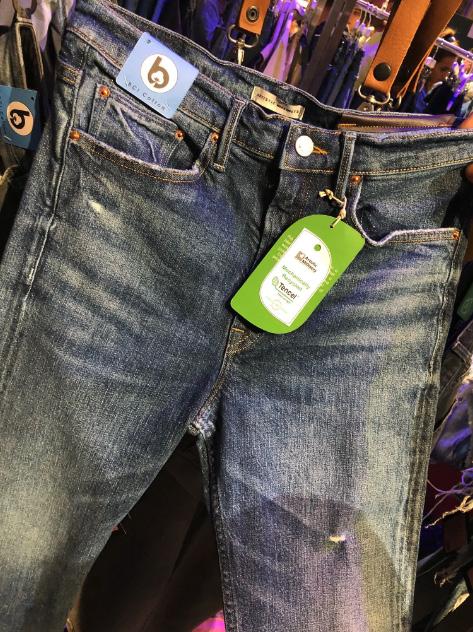
B.S.: We’ve had collections specifically geared toward these two demophraphics for some time now, with comfort at the heart of it. For example, Veloute uses brushed fabric for a velvety soft texture, combined with relaxed fits.
Y2K also capitalizes on the wide-legged aesthetic of the early2000s. It’s vibrant yet forgiving and has superb laser efficiency. Of course, the collection has conscious credibility, featuring fibers like Lenzing™ Ecovero™ and Milliner Organic Cotton.
Are there any upcoming innovations at Artistic Milliners for the close of 2022 and into 2023 that you would like to share?
B.S.: At our mills, we are taking a holistic approach to sustainability, like our previous investment in a fiber recycling plant on site or our partnership with regenerative recycling plants. And the innovations aren’t slowing down anytime soon.
In fact, one of our latest innovations is our Mechanically Recycled Tencel, one we are incredibly proud of. It takes Tencel collected from our system and recycled at our proprietary Circular Park facility and gives it new life. This is one we’re excited to scale up in the upcoming year.
“It helps to have a robust, end-to-end vertical infrastructure that has green technology at its core.”
Are
words _____ANDRE CLAUDIOAt times it can seem like older generations of consumers are placing all their hopes on Gen Z to correct their environmental wrongdoings.
A 2022 First Insight report about the cohort— born between 1995 and 2021—found that 64 percent of Gen Z shoppers prefer to buy sustainable brands and are willing to spend 10 percent more on sustainable products. In comparison, just 23 percent of Baby Boomers say they are willing to make the splurge.
Gen Z’s perception of sustainable fashion varies from consumer to consumer, however. Here, nine Gen Zers share how they define sustainability and how it factors into their denim purchases.

Gen Z consumers really willing to pay the price for sustainable jeans?
WHO Amelia Shaw, 20
WHERE Frederick, Md.
Rivet: What was your last denim purchase?
Amelia Shaw: My last denim purchase was at a thrift store in Northern Virginia and was a $5 pair of little girls Mudd jeans. Recently, I started hearing that you should always go to the kids’ section to find the hidden gems. Since I’m short, I decided to check it out, and ended up finding one of my favorite pairs of jeans ever.
Rivet: What makes a jean sustainable?
AS: When denim is timeless, doesn’t go out of style and is usable for more than one season is when it becomes sustainable. I believe we have become accustomed to purchasing denim from fast fashion retailers every season for a low cost. Ultimately, that is not sustainable, and if you can afford to drop $1,000 on a new wardrobe every season then you can afford to shop at sustainable brands.
Rivet: What is your favorite denim brand and why?
AS: I love Levi’s because I feel like it’s just a very classic denim brand. I never have to worry about if it’s going to tear on me, stretch in a weird way or if it’s going to fade in the wash.
Rivet: How much are you willing to spend on sustainable jeans?
AS: If I’m purchasing denim firsthand, I’d be willing to spend upward of $75 for a good pair. However, I typically prefer thrifting for my denim. In that case, I’d spend around $20 for a great vintage and durable pair of jeans.
Rivet: What was your last denim purchase?
Sam Vicchiollo: Recently, I bought five pairs of basic jeans from Abercrombie & Fitch for a model casting. They each cost about $70, but I felt they were the perfect jeans and worth the price.

Rivet: What makes a jean sustainable?
SV: I think a jeans lifetime is what makes it sustainable. Creating products that can be used by more than one person over an extended period is crucial to how sustainable it is. That’s why I love partaking in thrifting culture. In fact, about 90 percent of my closet contains thrifted items. I love going to thrift shops and finding secondhand clothing because one, I feel like I’m helping with sustainability, and two, there are so many items created with high quality to last a lifetime. I believe these items deserve a second chance at life, and Gen Z is giving them that chance.
Rivet: What is your favorite denim brand?
SV: For a long time, it was Levi’s. Now, Abercrombie & Fitch is my favorite place to buy jeans. Their jeans are high quality. Also, I have a small waist with bigger legs, and I feel like Abercrombie & Fitch’s sizes fit me perfectly.
Rivet: How much are you willing to spend on sustainable jeans?
SV: If the quality is there, then I’m willing to spend the extra money knowing that I have a durable, sustainable product. So, I’d pay up to $150 on sustainable jeans. I think anything more than that is a little too pricy.
WHERE Little River, S.C.
Rivet: What was your last denim purchase?
Kayla Jones: I recently thrifted a pair of Levi’s from the men’s section at Goodwill for $6. I always try to buy my denim secondhand—as well as most of my wardrobe—because I believe it’s the most sustainable way to shop.


Rivet: What makes a jean sustainable?
KJ: I think there are many factors that go into making anything sustainable. For jeans, I believe the current process for growing cotton is a non-sustainable way to produce. To make jeans sustainable, we need to look at these processes and use less water and energy.
Rivet: What is your favorite denim brand?
KJ: When I go thrifting for denim, I usually look for Levi’s, Wrangler or Dickies because I feel like those use more durable, thicker fabrics.
Rivet: How much are you willing to spend on sustainable jeans?
KJ: If I am thrifting for jeans, I think up to $15 is a great price, maybe even lower than that. However, if I were buying new, I would probably pay up to $80 for sustainable jeans.
Rivet: What was your last denim purchase?
Chris Duthie: My last denim purchase was a pair of black skinny jeans from Plato’s Closet.
Rivet: What makes a jean sustainable?
CD: I would imagine jeans are more sustainable when they’re not skinny or stretchy because those probably contain higher plastic contents. I also believe that jeans using fewer toxic dyes, less water during production or natural/plant-based fibers instead of artificial fibers are more sustainable.
Rivet: What is your favorite denim brand?
CD: I honestly don’t think I know what brand most of my jeans are. I also don’t know my favorite denim brand because I typically buy secondhand or on clearance. I feel like this is just more sustainable.
Rivet: How much are you willing to spend on sustainable jeans?
CD: It would depend on what’s meant by “sustainable,” such as fair wages, locally sourced and produced, etc. However, I’d probably pay $30 for a pair of sustainable jeans since I primarily shop secondhand and believe a pair of jeans should not exceed $11.

WHERE Lorain, Ohio
Rivet: What was your last denim purchase?
Jazmine Smith: My last denim purchase was $80 dad shorts from Abercrombie & Fitch.
Rivet: What makes a jean sustainable?
JS: Personally, I like to stay away from trendy clothing as I find timeless denim more sustainable. That’s why I love thrifting. I think there’s something special about passing down a pair of jeans, which you can’t really do if a jean isn’t sustainable or made from good materials.
Rivet: What is your favorite denim brand?
JS: Abercrombie & Fitch and Levi’s are two of my favorite denim brands. Being someone who is taller and a bit curvy, I find that Abercrombie makes the best jeans for people like me. With Levi’s, I find the denim to be comfortable and durable, giving me a bang for my buck.
Rivet: How much are you willing to spend on sustainable jeans?
JS: I’m willing to spend upward of $100 for a good pair of sustainable jeans.


Rivet: What was your last denim purchase?
Angelina Aileen: J Brand mid-rise straight jeans.
Rivet: What makes a jean sustainable?
AA: It’s not only the material it’s made from, but also the business decisions a brand makes in sourcing, producing and manufacturing the end product, like the amount of water and energy used, how they source their cotton, if it’s organic or not and if they’re maximizing the ability to produce via recyclable materials.
However, engaging in sustainable practices alone is not enough to build brand loyalty among new consumers. Brands should strive to be certified to earn credibility.
Rivet: What is your favorite denim brand?
AA: I love the J Brand because they take action. I also trust the brand and I am confident when recommending them to others because they consider the impact they have on our environment. They upcycle unused fabric waste, have pledged to use sustainable technologies and even use eco-wash processes. Their jeans also fit me like a glove, and I always get compliments whenever I wear them.
Rivet: How much are you willing to spend on sustainable jeans?
AA: $70-$100 for mid-tier jeans. $100-$250 for luxury brand jeans.
Rivet: What was your last denim purchase?
Sash Shaban: A vintage 1990s Valentino jean jacket.
Rivet: What makes a jean sustainable?
WHO Griffin Maxwell Brooks, 21

Rivet: What was your last denim purchase?
Griffin Maxwell Brooks: My last denim purchase was three thrifted pairs of Levi’s jeans— all around $12—which I plan on patchworking into one Frankenstein pair of jeans. While all three pairs were cute on their own, I realized they were similar styles and might end up getting lost in my wardrobe. By making my Frankenstein jeans, I can ensure the denim has a long life and the fabric doesn’t go to waste.
Rivet: What makes a jean sustainable?
GMB: If you’re not affecting production demand, then you’re being sustainable. That’s why I believe thrifting jeans is the most sustainable way. However, if you're going to buy new jeans, there’s ways to go about that, like shopping at brands who have public commitments to reducing water consumption, sourcing locally and being more sustainable overall.
Rivet: What is your favorite denim brand?
GMB: Thrifting is ideal for me, but two brands that I really like are Frame and Stella McCartney. They’re both very different price points but have many beautiful pieces. If you can afford either, those are great routes to go as they have a very rigid commitment to sustainability. However, you can find quality denim for a cheaper price, like at a thrift store.
Rivet: How much are you willing to spend on sustainable jeans?
GMB: Denim is a staple in my wardrobe, but it’s a basic that I don’t ever feel the need to pay an absurd amount of money for—unless I’ve found a hot couture designer must-have piece. That being said, I typically like to pay around $15 for jeans, but I will spend up to $40 if it makes my butt look big
SS: Three components. First, environmental, meaning the brand implores some type of recycled content in the material, and they reduce energy and water consumption in the manufacturing process. Second is quality, which [might prevent] customers from wanting or needing a new pair of jeans. If brands made jeans that last, then why would I need to go and buy a new pair?
Last is legacy, which is what keeps the jeans in style. If I’m not switching jeans for quality, it’s because the brand name or style is not trending anymore. I believe that brands should strive for relevancy, and cater to the market’s trends, preferences and style.
Rivet: What is your favorite denim brand?
SS: Rag & Bone. The jeans have great quality that last a long time and don’t wash out. It’s also so easy to find a pair that fits me and the style I’m going for because of the many options they have. Personally, I fancy their simplistic aesthetic and young-meets-old school vibe.
Rivet: How much are you willing to spend on sustainable jeans?
SS: $250.
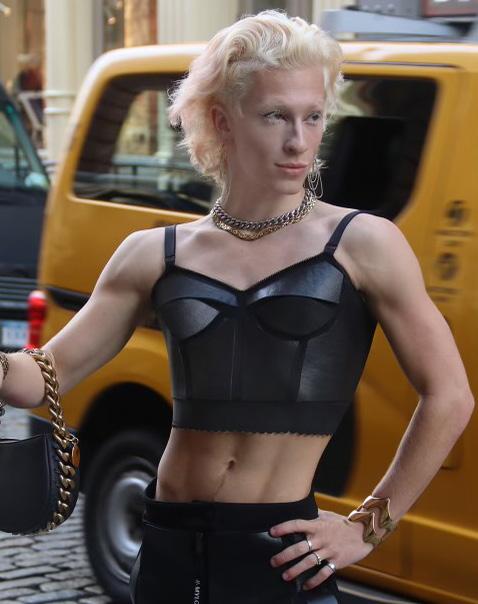
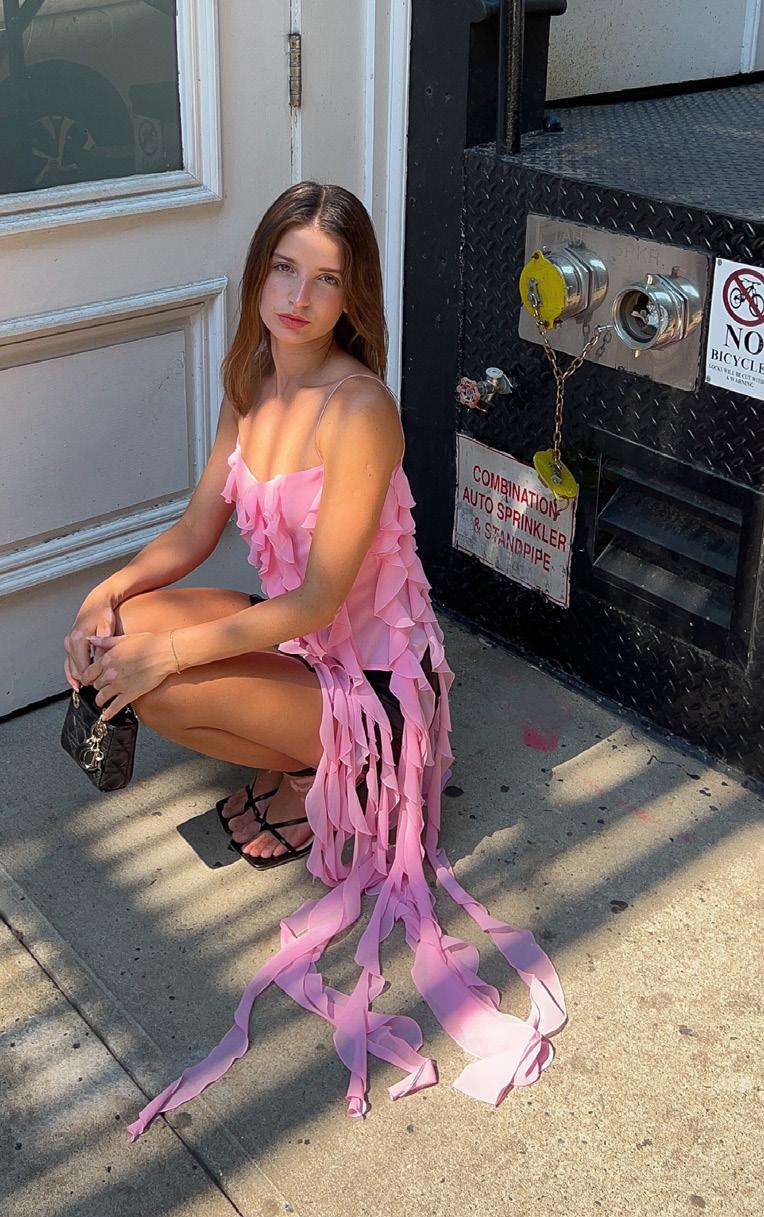
Rivet: What was your last denim purchase?
Marina Rough: My last denim purchase was a $50 cropped jean jacket from Mango. I never owned a cropped jean jacket, but I figured it’d be a great staple piece for fall.
Rivet: What makes a jean sustainable?
MR: I think the material the denim is made from determines if it’s sustainable. For example, is it made with organic cotton? Does it have polyester in it? Will it have stretch?
Rivet: What is your favorite denim brand?
MR: Levi’s is my favorite brand because of the amazing quality you get for a reasonable price. Also, they’re a jean everybody wants, so you can easily sell on Poshmark (or another resale platform) once they’re no longer desirable.
Rivet: How much are you willing to spend on sustainable jeans?
MR: I’m willing to spend around $100 on a good pair of sustainable jeans.
While the fashion industry is enthralled with throwing nostalgia-inducing fashion, sustainable capsules and slick digital campaigns at millennials and Gen Z, brands may be missing out on Gen X’s spending power. Digital marketing solutions company RevLocal reports that Gen X, or anyone born from 1965-1980, accounts for 31 percent of the total U.S. income, and their income (on average) is higher than the national average as well as the averages for all other generations.
Born to Boomer parents and raised on MTV icons like Kurt Cobain and Prince, jeans are part of Gen X’s generational uniform. However, the qualities and designs Gen Xers look for in a denim brand are growing up with them.
Here, executives from two leading Gen X women’s denim brands share how they are addressing demand for comfort, fashion and classic style.
To fully appreciate NYDJ, formerly known as “Not Your Daughter’s Jeans,” it’s critical to understand the landscape of denim fashion when the brand launched in 2003. Pop stars, models and clever marketing made premium denim brands and their $200-plus price tags covetable items. Rises were falling while silhouettes tightened up, squeezing consumers who wanted the market to give them flattering, comfortable blue jeans.
What began as a business focused on denim to address a gap in the women’s denim market has since expanded to include tops, matching sets, footwear and more—and with a snappier moniker.
Jeans, however, remain NYDJ’s bread and butter with prices at $89-$139. “Currently, NYDJ’s business is 70 percent denim and is
brands serving Gen X balance comfort and fashion.
words _____ANGELA VELASQUEZonly continuing to grow with new colorways and styles,” said Estelle Dahan, NYDJ VP of design. The brand is seeing “positive high single-digit comps” compared to pre-Covid denim sales, she added.

Evolving with its consumers has been key to the brand’s success story. NYDJ offers jeans in sizes 00-22 in regular, petite, plus and tall, enhancing styles with proprietary slimming panels. In 2020 it began to experiment with sustainable color technologies and organic and recycled materials.
“We make clothing for every woman to feel comfortable and confident,” Dahan said.
Rivet: What qualities in denim resonates with your consumer?
Estella Dahan: We’ve found that stretch is a key quality in the comfort of denim, and we’ve found a way to integrate that into almost all our bottoms. To keep them comfortable, but flattering, we created Life Tuck Technology, which uses a proprietary slimming panel with a patented crisscross design to shape and support your curves for an alwayssleek silhouette.
When sourcing fabrics, we always keep comfort top of mind, like with our Sculpting Comfort collection. We’ve layered our beloved denim into three stages of comfort based on the level of stretch: serious comfort, high comfort, and ultra-comfort. The fabrics featured were selected to support the figure while lifting and shaping your curves. The serious comfort is made with supportive stretch denim, and our exclusive satin elastic waistband molds to your waist for a fit that feels like pull-on jeans. The high comfort is made of our softest stretch denim, comprised of silky-soft viscose and modal that moves with you for a fit that feels like yoga pants.
Lastly, our ultra-comfort is made of powerstretch denim that expands up to three sizes for a fit that feels like compression leggings. We look for these key elements when sourcing fabrics to ensure we only offer the best.
Rivet: What are NYDJ’s bestselling fits?
ED: Some of our iconic and best-selling fits include the Marilyn Straight Leg jeans, Sheri Slim
jeans and Teresa Wide Leg jean. Our Marilyn Straight jeans are a classic fit that never goes out of style and are loved by Oprah. The Sheri Slim is a crowd favorite as it’s the perfect balance of skinny and straight with a slightly tapered leg. Our beloved Teresa Wide Leg is super popular for the wide-leg jeans trend on the market. It adds a bold statement to any outfit.
Rivet: How does NYDJ approach trends?
ED: We identify consumer needs in the market, styles that are trending, and washes that are popular and integrate that into our offerings. We recently released the Haley wash, a wardrobe essential light blue wash with a slightly faded look that plays into what is trending by offering it in the Marilyn Straight Leg jeans and Sheri Slim jeans, two of our most popular styles.
Rivet: What are some key trends for Spring/ Summer 2023?
ED: As spring approaches, I think we’ll see the return of florals and vibrant pastel colors like pinks and greens with a mix of lighter denim washes. I think wide-leg bottoms will continue to trend next year. Consumers like the loose fit. Many feel it’s more comfortable and flattering but also very versatile.
Rivet: What is your fabric sourcing strategy?
ED: Our focus when sourcing fabric is all about premium denim. We focus on serving our customers the best stretch and rigid denim on the market. Our basic requirement for stretch is more than 50 percent stretch and more than 80 percent recovery.

Rivet: How does the brand address sustainability?
ED: At the start of this year, we aimed to become a 20 percent sustainable company. We are excited to share that we’ve almost reached our 2023 goal of 50 percent and are expected to meet it in the new year.
We take small steps towards achieving these goals, including considering which fabric we want to feature when we design denim. Throughout our design process, we heavily consider whether the product is 100 percent organic cotton, includes earth-friendly technologies, and uses recycled materials with the exact signature fit, comfort, and style our consumer loves. We’ve incorporated environmentally friendly fabrics not only in denim, but in our shoes with recycled rubber and denim made from plastic water bottles, as well as our blouses with sustainable polyester fiber created from 100 percent post-consumer plastic waste. Our collections have evolved over time with sustainable designs, and we’ll continue to set new goals for the future to make NYDJ even more sustainable.
Launched in 2014, Jen7 offers the best of two worlds. It shares the same premium DNA and attention to quality as its sister brand 7 For All Mankind but prioritizes comfort and accessibility.
“Jen7 focuses on great-fitting classics that appeal to a more mature customer while keeping in mind affordability,” said Claire Guité, associate designer for Jen7 and 7 For All Mankind women’s outlet and off price.
Sold in Nordstrom, Saks Fifth Avenue, Neiman Marcus, Bloomingdale’s, Macy’s, Stitch Fix, Zappos, Dillard’s, Amazon and specialty retailers, the brand carries prices ranging from $79-$159, with “essential denim bottoms” averaging around $99-$109. “We are expanding our denim ready-to-wear in 2023 to include more denim jackets, dresses and jumpsuits, so that is where you will see a higher price point,” she added.
The additions fit in with Jen7 consumers’ busy lifestyles. “The Jen7 woman knows what she likes and what she needs to keep her days moving,” Guité said. “She has an interest in fashion and trends but depends on the classics: affordable, high-end denim with great fit, function and comfort.”
Though the median age of Jen7 consumers “is around 45-50,” Guité said the collections also appeal to younger and older women. What it boils down to is style and lifestyle. “She is feminine, confident and appreciates the quality and value of clothing,” Guité said about the Jen7woman. “She shops at department stores as well as online and likes to share photos and videos of her life on social media. She is relatable and could be someone’s mother, sister, daughter or grandmother.”
Rivet: What qualities in denim resonates with your consumer?
Claire Guité: The uncompromising attention to fit and comfort while still being fashionable and feminine is what resonates most with our consumer. We focus so much on having a great fit across the board that works for so many different body types and a wide range of sizes. Classic jeans will never go out of style and will never have an age limit.
Rivet: What are some common concerns that Jen7 consumers have about shopping for jeans?
CG: For a more mature customer, comfortability and great fit are what is most important and hard to find. As we get older and go through different
phases of life our bodies change. Jeans are the hardest piece of clothing for many women to find that fit their body well that are also comfortable and stylish. I think Jen7 fills that space for many older women because most fashion brands are tailored to very young consumers who have different needs and wants. Another common issue our consumer base faces is finding greatfitting denim for a size 16 or higher. Jen7 also fills that space for a curvier customer by having a wider size range that doesn’t compromise fit, comfortability and style.
Rivet: How do you provide solutions?
CG: The top block of our jeans always remains the same. This means from the top of the waist to the top of the thigh each fit is consistent. Your size will always fit you, whether it’s a skinny or a wide leg. We have what’s called an enhanceMe panel—a sculpting panel designed to keep its shape (and yours) all day long. Flexible woven stretch panels are built into the pockets to subtly slim, sculpt and shape.

In addition to this, the waistband on each pair of jeans is contoured to the body to eliminate gapping in the back and have a more comfortable fit while wearing. All this combined with high quality stretch fabrics makes for the most comfortable and flattering pair of jeans you can own, regardless of your size or shape. I am really being unbiased when I say these are the most comfortable pairs of jeans I own.
Rivet: What is Jen7’s bestselling fits?
CG: Our best sellers are Ankle Skinny, Ankle Straight, Slim Bootcut, Trouser, Cropped WideLeg, Mid Roll Short and Pencil Skirt fits. These are classic staple fits that will never leave the Jen7 brand. You will always see them in different variations, whether it be a different wash, fabrication, fashion detail or color. These are here to stay and our consumer base loves them.
Rivet: What are some key trends for Spring/ Summer 2023?
CG: Jen7 is seeing an increase in popularity in the wider leg openings in bootcuts, trousers, and flares. As we know, brands everywhere are moving away from the skinny jean. The skinny leg is still an essential for Jen7 and won’t be leaving anytime soon, but the wider leg trend is taking over. For Spring/Summer 2023 we have a focus on feminine florals and pastel colors, bright blue washes, ’70s-inspired details and an update to some of our key existing wider leg fits. [With the expanded] denim ready-to-wear
assortment, she can get dressed up for brunch or dressed down for a day at the beach. The assortment is incredibly versatile.
Rivet: Are there any trends that don’t resonate with your customer?
CG: I would say that there’s nothing I design for Jen7 without the consumer in mind, however we do have a growing consumer base that is younger (20s-30s). Because of that, we are pushing a little more denim ready-to-wear—things like denim jumpsuits, dresses, and jackets. These might be considered more of the ‘fashion’ styles that a younger consumer is going to be drawn to over our more mature customer. The same attention to overall fit and comfortability is put into these styles as well.

Rivet: What is your fabric sourcing strategy?
CG: We work with several fabric mills here at Jen7 that we also share with 7 For All Mankind. They will come show us fabric options, or if I am looking for something specific, we will reach out to them and ask to see what they have or what they can do. As far as requirements, the Jen7 fabrics must have a high percentage of stretchability and a low percentage of growth. This means the fabric is very stretchy but retains its shape and doesn’t bag out. This is incredibly important in the overall wearability and longevity in a pair of jeans. We are also very price conscious when it comes to choosing fabrics so we can keep our jeans affordable.
Rivet: How important is stretch to your consumer?
CG: Stretch is incredibly important to our consumer because the amount of stretch combined with the soft hand feel of the fabrics is what makes the jeans so comfortable. Not only does the fabric have great stretchability but also recovery. It will hold its shape throughout the day and keep everything in place. Like I explained above, we make sure our fabrics retain their stretch and shape. These are jeans made to last not only throughout the day but for years to come.
Rivet: How does the brand address sustainability?

CG: When we talk about sustainability, it’s such an overarching word that doesn’t have a true definition in the fashion industry. For me, what it comes down to is making conscious and ethical choices and that starts with the fabrics and trims. Eighty-two percent of Jen7 fabrics have a sustainable element to them. As a company we work with BCI and Cotton Leads, who work with farmers to support sustainably produced cotton throughout the globe based on strict criteria.
We also have great elements in our trims. Our tack buttons are made with recycled copper and our woven labels are made from post-consumer recycled polyester yarns. Moving forward in choosing fabrics and trims we are pushing to make better and better choices and improving our impact in ways that we can. I would love to incorporate more materials like recycled cotton or other plant-based and recycled fibers into our fabrics that have less of an impact on the planet.
Denim is the foundation of the modern wardrobe.
 photography LEXIE MORELAND styling ALEX BADIA
KHAITE SUEDE BOMBER JACKET, DENIM SKIRT AND BOOTS; CELINE CORSET TOP; NOTTE PEARL NECKLACE; KLOTO SINGLE EARRING; CELESTE STARRE GOLD CHAIN, MODEL’S OWN SILVER NECKLACE AND EARRINGS; SEQUIN GOLD RINGS; ETTIKA GREEN RING; BONBONWHIMS HEART RINGS. JEWELRY WORN THROUGHOUT.
photography LEXIE MORELAND styling ALEX BADIA
KHAITE SUEDE BOMBER JACKET, DENIM SKIRT AND BOOTS; CELINE CORSET TOP; NOTTE PEARL NECKLACE; KLOTO SINGLE EARRING; CELESTE STARRE GOLD CHAIN, MODEL’S OWN SILVER NECKLACE AND EARRINGS; SEQUIN GOLD RINGS; ETTIKA GREEN RING; BONBONWHIMS HEART RINGS. JEWELRY WORN THROUGHOUT.


RE/DONE X HANES TANK
TOP; ANNAKIKI CARGO JEANS; R13 BASEBALL HAT.
OPPOSITE: FRIED RICE PLAID SHIRT; RE/DONE X HANES TANK TOP; R13 JEANS; CELINE PLATFORM SNEAKERS.

 CELINE OVERSHIRT; CORSET TOP, JEANS AND BOOTS.
CELINE OVERSHIRT; CORSET TOP, JEANS AND BOOTS.

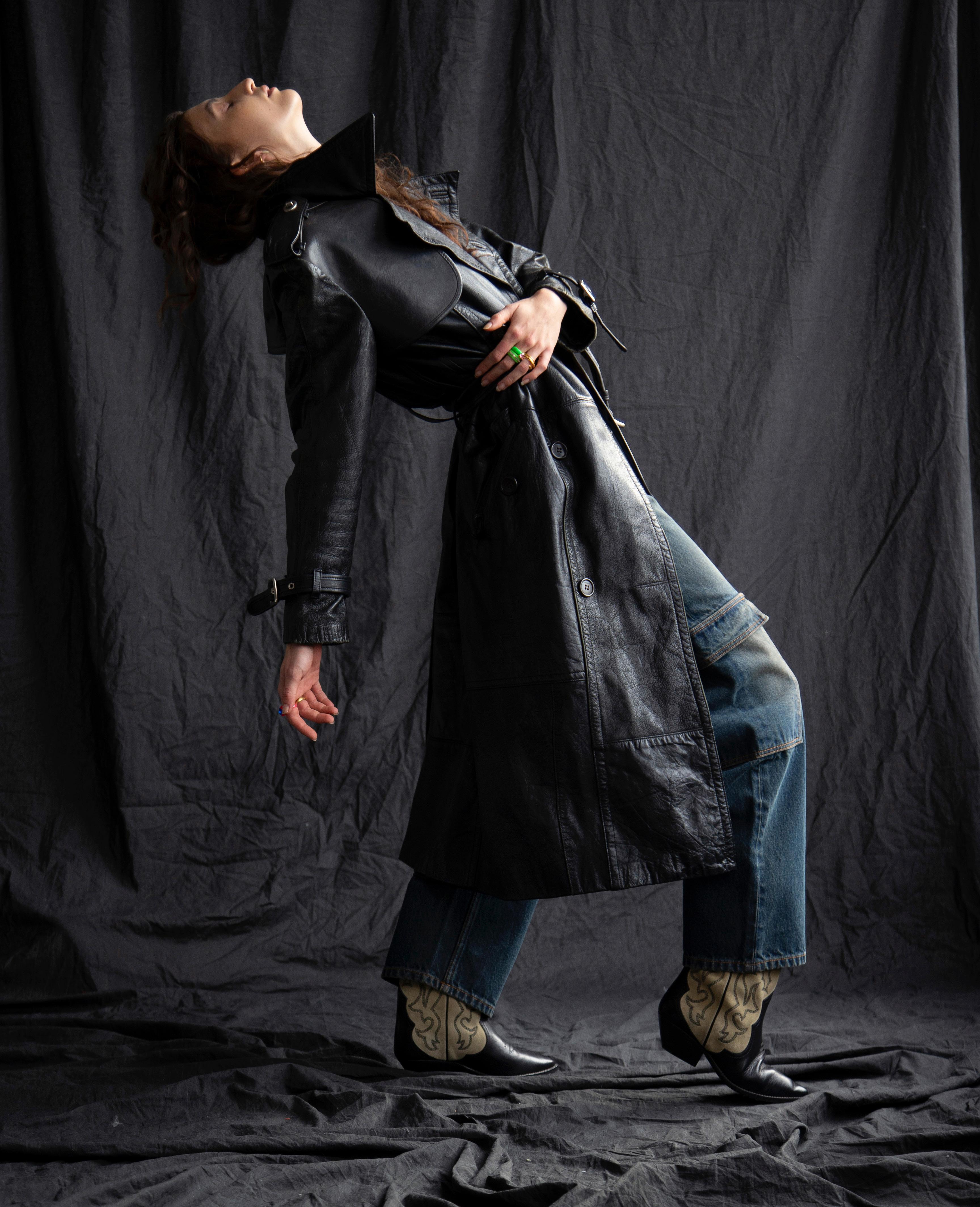 COACH LEATHER TRENCH COAT; STILL HERE CARGO JEANS; ISABEL MARANT BOOTS.
OPPOSITE: EDWIN VEST; MOTHER DENIM SKIRT; CARRERA SUNGLASSES.
COACH LEATHER TRENCH COAT; STILL HERE CARGO JEANS; ISABEL MARANT BOOTS.
OPPOSITE: EDWIN VEST; MOTHER DENIM SKIRT; CARRERA SUNGLASSES.

 ISABEL MARANT JACKET; UNIQLO CHECK SHIRT; RE/DONE X HANES TANK TOP; TOMMY HILFIGER JEANS; COACH HAT.
OPPOSITE: R13 OVERALLS; RE/DONE TOP; ISABEL MARANT BOOTS.
ISABEL MARANT JACKET; UNIQLO CHECK SHIRT; RE/DONE X HANES TANK TOP; TOMMY HILFIGER JEANS; COACH HAT.
OPPOSITE: R13 OVERALLS; RE/DONE TOP; ISABEL MARANT BOOTS.

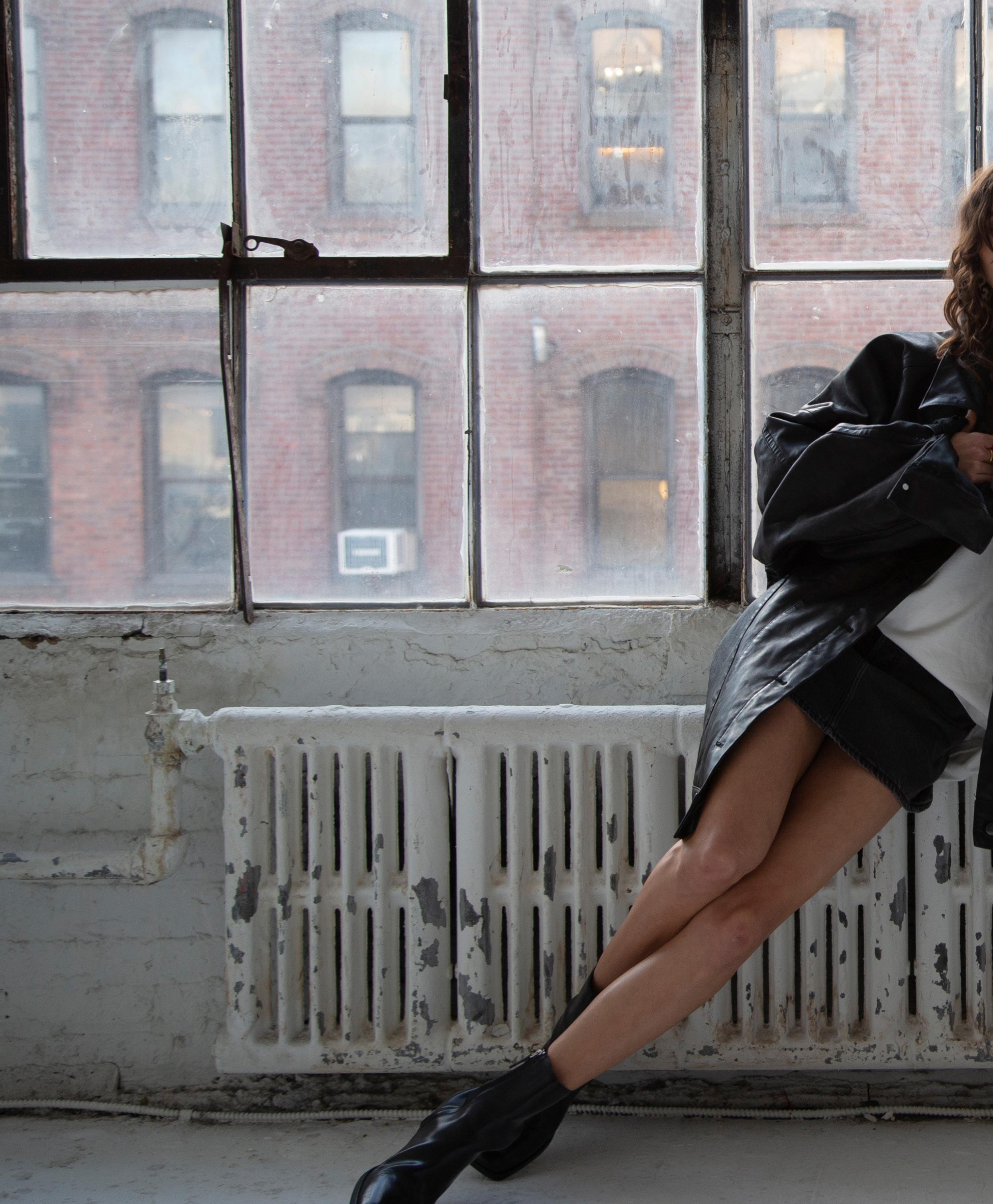 MARC JACOBS LEATHER JACKET AND COTTON T-SHIRT, LEVI’S DENIM SKIRT; CELINE BOOTS.
MARC JACOBS LEATHER JACKET AND COTTON T-SHIRT, LEVI’S DENIM SKIRT; CELINE BOOTS.
 Photography: Lexie Moreland; Styling: Alex Badia; Model: Maya Ethridge @ State; Hair: Rebeka Calo; Makeup: Ashleigh Ciucci @ See Management;
Casting: Luis Campuzano; Market editors: Emily Mercer, Thomas Waller; Fashion assistants: Kimberly Infante, Ari Stark; Rivet editor: Angela Velasquez
Photography: Lexie Moreland; Styling: Alex Badia; Model: Maya Ethridge @ State; Hair: Rebeka Calo; Makeup: Ashleigh Ciucci @ See Management;
Casting: Luis Campuzano; Market editors: Emily Mercer, Thomas Waller; Fashion assistants: Kimberly Infante, Ari Stark; Rivet editor: Angela Velasquez
Though Lycra EcoMade is about 10 percent more expensive than traditional Lycra, Jean Hegedus, the company’s director of sustainability, said people are attracted to its lower carbon footprint and its comparable performance to its standard sibling.
words _____CHRISTOPHER BLOMQUISTFabric and fiber mills continue to roll out new advancements in eco-friendly denim with elasticity. Companies are seeking these new solutions as traditional stretch fabrics have been made with petroleum-based chemicals and plastics and the laundering of these and other synthetic textiles contributes to microplastic and microfiber crisis polluting the world’s oceans.
A 2017 report by the International Union for Conservation of Nature (IUCN) found that 1.5 million tons of microplastics are released into the ocean each year and “the largest proportion of these particles stem from the laundering of synthetic textiles and from the abrasion of tires while driving.”
The purpose of stretch in denim is also in a state of transition. Though sales for high-stretch skinny jeans have waned since the style’s early 2000s heyday, consumer demand for stretch denim centers on the comfort they expect from modern blends versus the stiffness of old-school denim. Legs may be getting looser but a waist or rear with give is still most welcome.
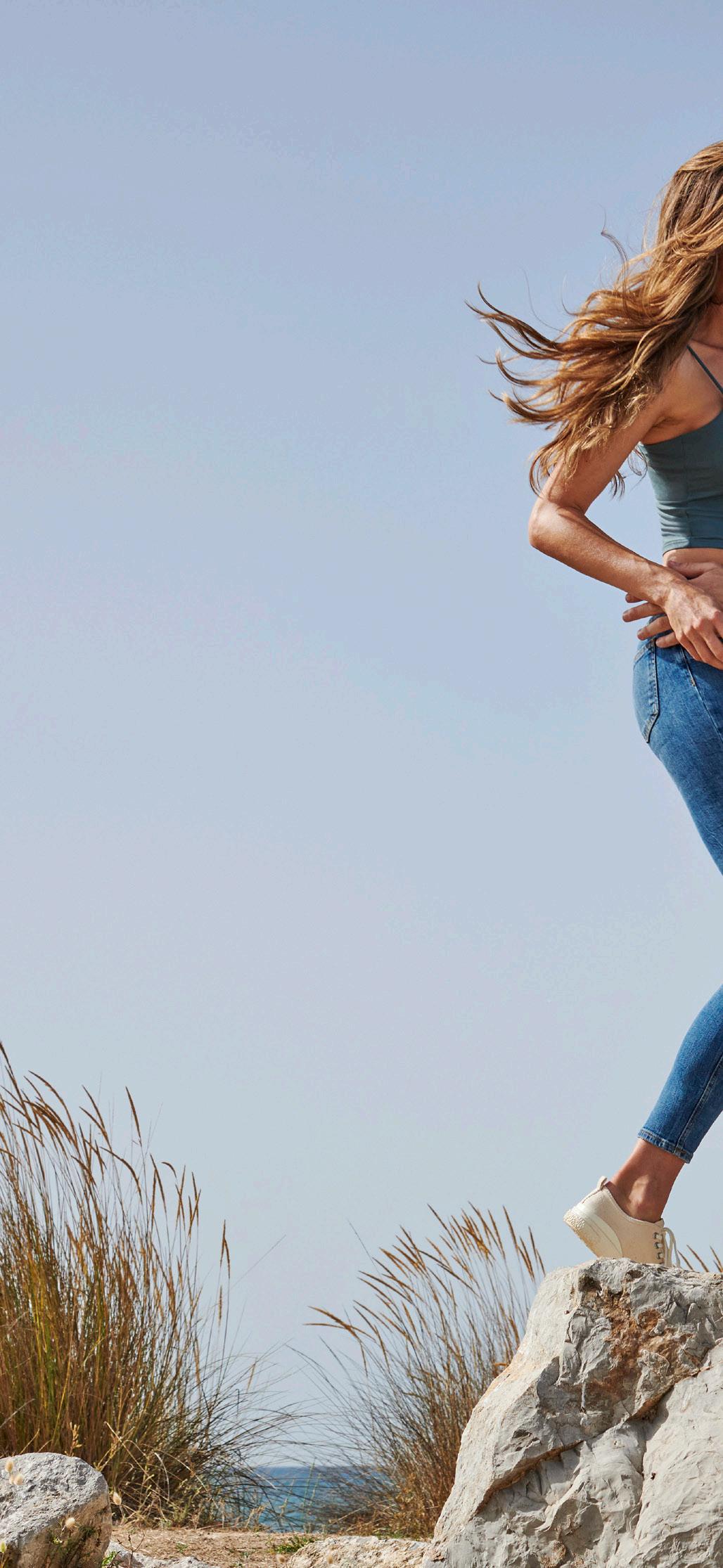
As a spandex manufacturer, The Lycra Company has stepped up with several sustainable stretch solutions beginning in 2008 with the launch of its first recycled product, Coolmax EcoMade. In 2019, the company launched Lycra EcoMade, a stretch fiber made with 20 percent recycled content derived from its production waste and mixed with virgin polymer.
As with any new product, collaboration and feedback from existing clients were integral in the development of the fiber. It’s how Lycra landed on 20 percent recycled content as the optimal amount for Lycra EcoMade. “We knew that it would be relatively limited in terms of the amount that we can sell,” Hegedus said, noting the company already runs a tight ship when it comes to creating waste. “And so we went to our customers first and said, ‘Would you rather we maximize the yardage or maximize the content?’ And the feedback that we got from most people was decidedly maximize the yardage.”
The fiber is produced exclusively at Lycra’s manufacturing facility in Monterrey, Mexico, though the long-term plan is to scale it at its five other hubs by 2030. Most clients, Hegedus said, combine it with Lycra T400 EcoMade, a spandex-free polyester fiber launched in 2018 made with 68 percent sustainable resources, including recycled and renewable materials, for superior recovery.
More innovation is in the pipeline. The Lycra Company recently announced a partnership with Qore, a joint venture between the U.S. food corporation Cargill and Helm, a German chemical company, to enable the large-scale commercial production of Qira, a bio-derived spandex. The goal is to have 70 percent of the Lycra fiber content derived from annually renewable industrial corn instead of petroleum. The addition of Qira will reduce Lycra’s carbon footprint by about 44 percent.
Qira will be produced at Cargill’s biotechnology campus currently under construction in the middle of the Corn Belt
New technologies are making denim with give greener.The Lycra Company
in Eddyville, Iowa. The 65 kiloton facility will open in 2024. If all goes according to plan, the first renewable Lycra fiber made with Qira will be produced at The Lycra Company’s Tuas, Singapore manufacturing site by the third quarter of 2024. It will start supplying customers with the fiber by the fourth quarter.
The fiber does not have a formal name yet, but Hegedus suspects that it will also be categorized under the EcoMade umbrella.
The Roica Eco-Smart family of yarns, which has been produced by Japan’s Asahi Kasei since 2016 is another set of fibers advancing sustainable stretch denim.
Roica EF, which is certified by GRS, contains 58 percent pre-consumer recycled content collected by Asahi Kasei. Roica V550 breaks down at the end of its life without releasing any harmful chemicals based on Hohenstein Environmental Compatibility Certificate. It is also the world’s first elastane yarn with a Cradle-to-Cradle (C2C) Gold Level material health certificate.
German retailer C&A used Roica V550 in its C2C Gold Level denim collection in 2018. Everlane used Candiani’s organic cotton and Rocia V550 blend in its Clean Denim range last year. A spokesperson for the San
Francisco apparel company said the brand is “actively exploring” additional stretch elastane alternatives to further reduce the environmental impact of its jeans.


Ken Ko, a representative for Chinese mill Panther Denim, firmly believes that offering stretch and sustainability do not have to be mutually exclusive anymore. The mill has found success by using both Lycra EcoMade and Roica V550. “If brands accept the slight cost differences and lead time differences by using sustainable elastane, we are ready to deliver a greener world,” he said.
Denim mills are perusing their own alternatives to traditional elastics.
In 2019, Italy’s Candiani introduced the world’s first compostable stretch denim fabric. The patented technology uses elastic yarns obtained from natural rubber in place of synthetic yarns. Entirely compostable, it breaks down in less than six months and was recently used to fertilize the soil and grow Candiani’s regenerative, non-GMO Blue Seed Cotton at the Rodale Institute in Camarillo, Calif.
Triarchy, Closed, Stella McCartney, Outerknown and more are using the technology in their denim ranges.

Stretch denim can also mean no elastane at all.
Mechanical stretch or stretch denims that are pure cotton with zero elastane, PET or petroleum-based fibers, have become a buzzword as of late and are leading mills toward a more biodegradable future.
Panther Denim offers cotton fabric with stretch characteristics under its Comphy concept. “We have rigid products without the use of elastane and provide natural stretch levels by loose fabric construction,” Ko said. “But it can only provide you with minimal stretch.”
Similar performance technology is also being promoted by Cotton Incorporated as Natural Stretch which can be found in woven shirting and bottoms fabrics as well as denim. Core spinning and heat-setting, which can cause the fabric to lose elasticity if it is not processed at the right time or temperature and can cause the spandex to yellow, are eliminated during Natural Stretch production. The non-profit organization adds that it is “easy care” compared to stretch fabrics made with spandex because it can withstand ironing, tumble-drying and chlorine without losing its elasticity.
For Spring/Summer 2023, Orta Anadolu introduced Torque, a family of 100 percent cotton fabrics with 20 percent elasticity. Described as comfort stretch fabrics with “excellent recovery,” the collection offers a variety of medium and heavy weights designed to perform for a wide range of silhouettes and wash applications. Zennure Danisman, the Turkish mill’s marketing and washing manager, said the fabrics can be applied to a variety of aesthetics, from raw and rinse looks with clean twill lines, to refined vintage-inspired washes with slub character.
Danisman added that “there are no disadvantages” with Torque. There is no additional cost compared to standard denim, which is one of the reasons it has already been employed by Replay, Guess, J. Jill and Trussardi, among others, she said.
Pakistan-based Naveena Denim Mills recently launched Mecha-Stretch, a mechanical stretch collection of fabrics marketed as being “conscious by design.” The fabrics offer a vintage look and a stretch capability of 10 to 25 percent. The 100 percent circular collection has weft and warp shrinkage of -1.
Aydan Tüzün, Naveena’s executive director of sales and marketing, said the fabrics “work for any style” including, slim, mom, boyfriend and flare jeans. “One of the trends in the market is towards vintage, authentic and rigid fabrics which also offer wear comfort and softness,” she said.
Mecha-Stretch, she added, “reflects this trend perfectly combining style and comfort.”
Tüzün said the fabrics are no more expensive than standard stretch denim. As the product was launched earlier this year, she said the key users of it “are in the development stage right now.”

Manufacturers across the globe have begun ramping up their product offerings as consumer wants and needs continue to change, and Panther Denim has made this a priority.
Tim Huesemann, sales director at Panther, tells Rivet how the company is providing retailers with different combinations of dyeing, printing and finishing of denim and piece-dyed fabrics to help cater to the different growing demands of every generation.
RIVET: Panther is a fully integrated textile manufacturing company providing a wide range of in-house services. How are you using your wide range of services to help retailers cater to so many different types of consumers?
Tim Heusemann: Not only do we manufacture, but we also provide trend suggestions that merge with our fabric development, allowing retailers to select what best suits them.
The younger generation has begun purchasing rigid denim in loose fits and the trend is spreading to the older generation. To widen the customer range, we balance our collection of rigid, comfortable stretch and ultrastretch proportions. For example, we recently extended our vintage collection Marbelous to Re-Loom, adding more styles, washes, colors, material combinations and stretch levels.
Denim manufacturers have been on a mission to lower the impact of dyeing and finishing. How is this priority shaping Panther’s textile designs?
T.H.: Sustainable manufacturing has always been our priority, and minimizing the use of harmful chemicals and water consumption is what we strive for.

We are currently developing a unique closed-loop finishing that will allow us to circulate our chemicals. We found success in our initial trials, and we are already working on the next phase—finetuning this fabric finishing for different fabrications, which will provide a clean look and soft hand feel. While intensive trials are still under process, we are looking forward to launching this soon.
Are there any upcoming innovations at Panther for the close of 2022 and into 2023 that you would like to share?
T.H.: Currently, we are developing fabrics to combine indigo and vibrant colors, and we plan on doing a washing trial before the launch. Hopefully, we can present them in the upcoming Kingpins New York show.
Additionally, we developed a unique denim shade—Sunglow Blue—in our Spring/Summer 2024 denim collection. With this, we aimed to achieve a second-hand vintage shade—one you might see at your favorite vintage store—updated with our latest fabric constructions.
Taking inspiration from the sky, we also developed another shade called Royston Blue. Without laundry tinting, it minimizes chemical usage in denim production. Lastly, we have a bright blue shade called Snow Blue, which is vibrant and looks nice when bleached or lasered.
What
T.H.: We feel people born after the ’80s are more devoted to sustainable denim because they treasure vintage items and are more concerned about the environment. In fact, many have started purchasing vegan clothing, exchanging their clothes instead of buying new or buying second-hand.
T.H.: At Panther, we are devoted to ethical and sustainable materials and manufacturing. Additionally, we are constantly researching the practices of materials and technologies, understanding the impacts on the environment, economies and individuals involved. There are also some sustainable projects that we are working on with in-house technology for 2023, but it’s too early to disclose.
“People born after the ’80s are more devoted to sustainable denim because they treasure vintage items, and are more concerned about the environment.”
Mills across the globe have recognized the power of education in shaping the future of denim. Players in prime sourcing locales from Asia to the Middle East, Europe and the Americas are ramping up opportunities for workers to learn—and eventually, lead the charge toward a more sustainable future for the industry.

“At Soorty, we’ve been working on the cause of upgrading our workers—both in their interpersonal skills and their technical prowess, for years,” said Asad Soorty, the company’s director. “With new developments in responsible manufacturing, growing understanding and more exposure, we have primed a number of different programs focus on expanding their horizons to compete on the global level.”
The executive said that the Pakistan-based mill strives to promote “expansion—not just in the quantity and quality of our products but also into researching and formulating new, more efficient, eco-friendly and sustainable ways of manufacturing.” It’s a target that’s constantly moving, with the curriculum underscoring the company’s vision to create
products that are both aesthetically and environmentally sound.
“Learning new skills or new modes of looking at the world is always a subtle mix of the right exposure, guidance, encouragement, and trust,” he added. Learning requirements for workers reflect Soorty’s vision, from “our management-priorities, our investments into incorporating new technologies and our
commitments to global coalitions and our brand and retail partners as a responsible manufacturer.”
Over the course of the past decade, Soorty has invested in establishing at least one internal training center per factory unit, working with United Nations (UN) bodies and academic institutes, from the UN Development Program to the Science-Based Targets initiative (SBTi),
Mills are united in their efforts to help foster educational opportunities for their workforce.Saitex has trained 90 associates through Rekut.
sphere” with its Citizen Alpha program. The academia-linked platform includes annual industry visits, roundtables on curriculum-updates, student-led talks and panel discussions.
Soorty Enhancing Women’s Service (SEWS) is an internal group focused on increasing women’s representation within the company, as well as providing upskilling opportunities and funding for female entrepreneurs. Meanwhile, PRISM works to increase diversity and inclusion metrics, and has thus far assisted in training 88 differently abled individuals, a majority of whom work at the mill’s facilities. Soorty’s Executive Development Center puts on routine trainings for management and executive staff focused on addressing systemic and structural issues within the organization, helping to increase leaders’ awareness, and understanding of challenges impacting staff.
Mexico’s Global Denim is intent on imparting its circularity-driven mission on its workforce, according to Anatt Finkler, the mill’s creative director. “We constantly raise awareness in the mill about all the certification processes and programs in which we are immersed, so everyone working in our mill is on the same page,” she said. “We don’t only inform about the context, but also of the results, findings, and ways to improve.”
Global Denim has invested in several internal initiatives and platforms to help facilitate the spread of knowledge and opportunity, from the annual Forming Leaders Program, which trains supervisors, managers, and area coordinators, fostering leadership skills over the course of three eight-hour sessions, to technical field trainings and English classes, “as being bilingual is a must in today’s world,” Finkler said.
A newly implemented platform called Knovio provides an array of educational courses in a digital format, available in cloudbased library for employees to access at will, and multiple alliances with regional universities are helping the mill to recruit new talent. “We give talks, create partnership programs, give tours for students, participate in school trade fairs for education and help the industry whenever its needed,” she added.
Zero Discharge of Hazardous Chemicals
Foundation, Cradle to Cradle, World Wildlife Fund (WWF), Alliance for Water Stewardship Foundation (AWS) and more to create programming for students.
This collaborative work is a two-way street, “revamping not just ours, but their course curriculums, and encouraging programs that school young professionals for ‘green jobs,’”
Soorty said. “We are teaching our staff that sustainable production isn’t a process, it’s a mindset.” Once workers internalize that way of thinking, they can provide their own perspectives and implement their own ideas, instead of learning from the top down.

Soorty’s educational tiers are divided into groups, clusters and units, the director explained, and extend “far into the education
Several external groups are aiding Global Denim in achieving internal and externalfacing goals. “We hired a consulting agency to work with us through the entire year to help us achieve a culture change and prepare us on getting several ISO certifications,” she said. The group has also engaged with outside groups to train internal auditors “to ensure the continuity of our good practices.”
The mill aims to operate with a lighter carbon footprint during its day-to-day operations, and employee education is key, Finkler said. Facilities are plastered with print
and digital campaigns focused on initiatives like PET recycling, waste separation, water saving, energy saving and paper recycling.
“We have the mentality that no matter the area of operation, everyone must be included and know what happens around them” about sustainable manufacturing processes and company-wide initiatives, Finkler explained.
Artistic Milliners’ educational programs focus heavily on empowering the women that make up most of its workforce, according to marketing lead Gilbran Khaliq. “We have several internal and external worker training and empowerment programs to empower our employees to face challenges in their lives and the world at large,” he said. “Many of our worker advancement programs are also intrinsically linked to our work in support of Sustainable Development Goal (SDG 5), Gender Equality, which is particularly important for our industry.”
The mill’s managing director, Murtaza Ahmed, was named a “sustainable pioneer” by the UN for his focus on gender parity and work conditions. “We employee over five thousand women and their advancement, particularly at the worker level, remains one our top priorities,” Khaliq said. The mill collaborated
with Gap Inc., becoming the first facility in Pakistan to deploy its Personal Advancement and Career Enhancement (PACE) program, which provides education surrounding
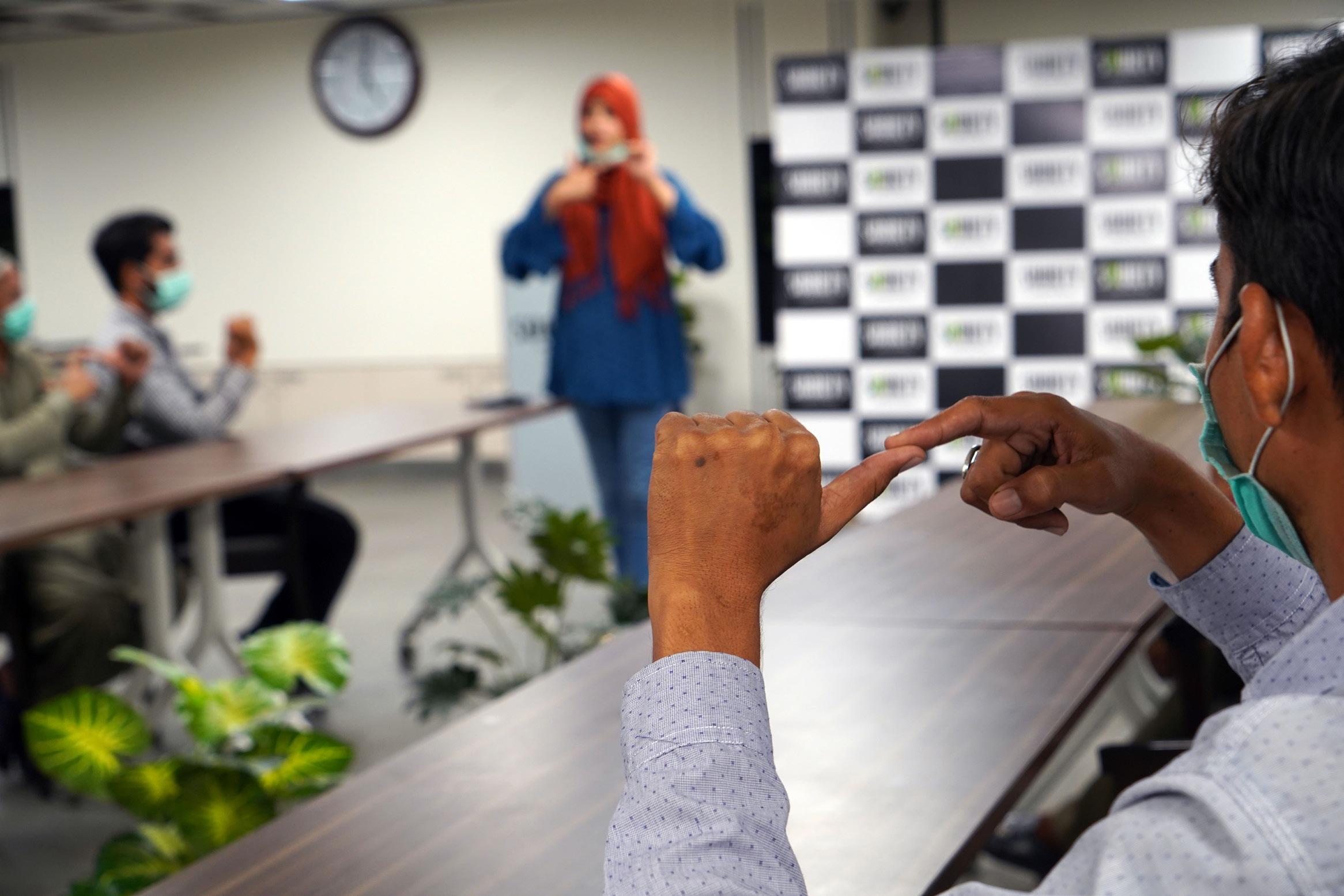
problem-solving, communication and legal and financial literacy.
“In the same vein, we have Bestseller’s HERessentials program, which is designed to bridge the digital literacy gap for women making our denim,” he added. In working with the Denmark-based apparel group, Artistic Milliners implemented a curriculum that encourages a healthy lifestyle for lowincome workers through peer-to-peer learning. HERessentials also provides general resources for worker health, information on financial inclusion and gender equity, and a venue to deal with crises relating to these issues.
Company-wide programs benefit all workers, including the SPARK initiative, “a forum to present their ideas to unlock ecoefficiencies within the company,” Khaliq explained. Resources and training are provided to help workers communicate and implement their best proposals. An adult literacy program sponsored by the Levi’s Foundation and The Citizens Foundation (TCF) Pakistan is designed to teach workers, within the span of six months, how to read and write in the Urdu language, while developing basic numerical skills. According to Khaliq, some graduates have been promoted after finishing the program.
“We are teaching our staff that sustainable production isn't a process, it's a mindset."
—ASAD SOORTY, SOORTYSoorty's PRISIM program trains differently abled workers.
“We’re also about to unveil the Better Work program in collaboration with the United Nation’s International Labor Organization (ILO) and the International Finance Corporation (IFC),” he added. The collaboration aims to create a dialogue between management and workers while training factory supervisors, particularly women, in supervisory skills.
Educational programs aren’t just limited to mill workers, according to Khaliq. Farmers are now being trained through Artistic Milliners’ Milliner Cotton curriculums, which were designed to promote composting, bio-pesticide use, water conservation techniques, micro nurseries for tree planting and more.
Bossa chief of marketing Özge Özsoy said that the Turkish mill’s collaborations with global universities power its company-wide educational efforts, and the factory’s doors are open to college and high school students interested in learning more about the industry.
“We have cooperation with many schools abroad such as Kingston, Norwich, Ravensbourne, Jeanschool Amsterdam,” she said. The company has provided fabrics to be used by students in various academic projects, and Bossa also accepted students from Jean School Amsterdam to intern in its factories.

During 2021, the group conducted forums and studies with several Turkish educational institutions. Proposals surrounding science and engineering, knitting training, project management training, innovative thinking, and mentorship have been developed alongside students and professors. Through research partnerships with the universities, Özsoy said Bossa has receive an award for its innovative studies and activities by the Turkish Textile Innovation League.
Vietnam’s Saitex takes a holistic view toward educating, training and upskilling workers, investing in platforms to improve their personal and professional lives.
“We must clearly define our training needs in order to create an effective training plan,” said Oanh Nguyen, the company’s health, safety, environment and sustainability manager. Each year, workers are surveyed about the needs of their respective departments. “The identification of training needs has helped the company to have clear orientations and criteria for training programs and courses,” she said, “as well as attract the attention of all employees in the company, making them enthusiastic and voluntarily participate in training programs.” Employees can and should learn new things “that not only support their working jobs but
also their independent lives,” like financial literacy training,” she added.
To prepare the next generation of workers for their technical responsibilities at the factory, Saitex conducts 27 sessions at its on-campus training center covering sewing and stitching by hand and machine, as well as operating and maintaining machinery.
The mill’s Rekut program is “a groundbreaking social entrepreneurship project and production line for the differentlyabled and people from disadvantaged backgrounds,” Nguyen added. Associates receive training and support for sustainable jobs “with equal, open opportunities and a stable income,” she said, “understanding that in urban areas of Vietnam, people with different abilities and special needs are three times as likely to be unemployed.”
Saitex has trained 90 associates through the Rekut program to date, with the aim of growing that number to 1,000—or 20 percent of its overall workforce—by 2025, to support its inclusivity goals. Once workers complete Rekut training, which focuses on upcycling fabric waste and deadstock garments into face masks, home goods, apparel and accessories, they can choose to enter into other areas of the business, like design and industrial engineering. In support of their advancement, they also learn to read and write in both Vietnamese and English. Launched in 2019, Saitex worked with non-governmental organizations (NGOs) like the UN Development Program and disability advocate groups to tailor workspaces, recruitment and training processes to Rekut’s unique needs.
Like Artistic Milliners, Saitex’s general worker population can participate in Gap’s PACE program. So far, the company has trained 20 leaders, to be followed by a first team of 250 women employees who will be trained in communication skills, problem solving, time management, clean water and sanitation and financial literacy.
The company has always placed a high premium on worker health, especially education surrounding nutrition, Nguyen said. Saitex has become known for its on-site hydroponic farming system, which yields six tons of fresh vegetables per year. “The result is healthy food for our community, while creating jobs that generate social interaction, employment with equal pay, and respect to some of the most vulnerable groups of our community.”
Nguyen sees education as imperative to ensuring both sustainable and social advancement at Saitex. “Training is a profitable investment activity because it brings benefits such as improving working efficiency for employees, developing quality staff, and lowers recruitment costs as we have low employee turnover as it builds employee trust and loyalty,” she added.
Nations Comtrade data. One report anticipates a deficit of 3.24 million bales valued at roughly $1.53 billion. That leaves just 5.79 million of the 9.03 million bales that the current harvest was poised to deliver.
words _____JASMIN MALIK CHUAFor Pakistan’s denim mills, the devastating floods that have submerged a third of the country, killed more than 1,700 people and destroyed up to 40 percent of the cotton crop are the least of their problems.
It’s true that the record-shattering rainfall and heavy glacial melt have wiped out homes, roads, bridges, farmland and livestock, creating additional economic hardships for a population already grappling with ballooning inflation and a collapsing currency. Months after the monsoons began, millions of Pakistanis remain homeless, critical infrastructure is in shambles and hunger is on the rise. Speaking at the COP27 climate conference in Egypt in November, Prime Minister Shehbaz Sharif pegged the destruction at some $30 billion. “Millions of people are going into winter without shelter or livelihood,” he said.
The impending cotton shortage also augurs ill for the world’s fifth-largest producer of the fiber. In 2021, Pakistan exported $3.4 billion worth of cotton in 2021, making up roughly 6 percent of the global supply, according to United
But waters will recede, communities will rebuild and cotton will regrow, according to mill operators that have avoided the worst of the deluge, which bore down on low-lying areas adjoining the Indus River. Most of the larger manufacturers are stocked up for the next few seasons. The threat they face is more existential: As a cost-of-living crisis due to spiraling food and fuel prices weakens consumer demand in the West, and brands find themselves yoked with too much inventory, orders have fallen precipitously. Without a steady flow of business, suppliers have a harder time riding out shocks, causing a knockdown effect that could leave tens of thousands of jobs hanging in the balance. Smaller outfits, battered by the volatility, have been forced to freeze operations or shutter all together.
“When the demand isn’t there, the supply gets affected,” said Umar Khawajah, vice president at Naveena Denim, which has seen a 40 to 50 percent year-over-year drop in orders. “So we pray day and night that the situation gets better in the U.S., Europe and other places so we are able to supply our product.”
Better Cotton, too, said that it will be able to make up any shortfall from Pakistan, its secondlargest producer after India, from its partners in Africa, Australia, Brazil and the United States. The London and Geneva-based nonprofit, which promotes cotton production based on a slew of
Multan, Pakistan.
social and environmental criteria, is still assessing its losses, which it originally estimated at 70 percent but has since walked back, saying that it’s still too early to tell. Its biggest priority now is the farmers who bore the brunt of the disaster.
“We are focusing on their livelihoods,” said Hina Fouiza, the organization’s Pakistan director. This includes working with on-theground implementation partners, including CottonConnect Pakistan, the Rural Business Development Center and World Wildlife Fund Pakistan, to find alternative sources of employment for its growers while the soil drains and recovers. Overall, some 1.5 million farmers cultivate cotton, contributing to 0.6 percent of Pakistan’s gross domestic product.
Pakistan was already in financial straits when calamity—a “monsoon on steroids,” as United

“Monsoon on steroids” hurt more than Pakistan’s cotton crop.
Nations Secretary-General António Guterres put it—struck. Weighed down by external debt, the cash-strapped nation managed to secure a $1.1 billion loan from the International Monetary Fund to avert a Sri Lanka-like default mere days before the heaviest downpours hit. But Russia's war in Ukraine, which has driven up energy prices, has continued to deplete its foreign reserves. As of October, they stood at $7.4 billion—enough to cover less than six weeks of imports. Without further debt relief, recovery from the floods will be long and arduous. Already, currency woes have propelled inflation to a historic high of 27 percent.
“We are spending millions of rupees from our own meager resources,” Sharif said as he asked richer countries to provide climate reparations to poorer ones like Pakistan. “How


can one expect from us that we will undertake this gigantic task on our own? The gap is humongous; the gap is widening by the day.”
Pakistan’s textile sector, which exports 60 percent of its output, is experiencing its own widening gap as production sputters. “Even a 5 percent drop means a lot to Pakistan,” said Iqbal Sheikh CEO of the Pakistan Textile Council. The “collaboration” part of the relationship with buyers in the West, he noted, has so far been “missing” at a time when support is most needed.
“If textile exports suffer because of things that are not within our control, that means we’ll have fewer dollars,” Sheikh said. “If you have fewer dollars, the rupee will lose its value and that will cascade into inflation.”

Aid from fashion’s biggest names has been in short supply as well. Ayesha Barenblat, founder and CEO of fashion advocacy group Remake, said that she has “personally written” to every major brand that sources from Pakistan to ask about relief support, only to be met largely with “radio silence.” H&M Foundation, the Swedish retailer’s philanthropic arm, announced in September that it will be directing $250,000 to the International Red Cross and Red Crescent Movement, while Gap Inc. has made an unspecified donation to CARE Pakistan. Wrangler owner Kontoor Brands declined to comment, citing a “quiet period” ahead of its quarterly results. Levi Strauss did not respond to an email requesting information. A source familiar with the situation said that the denim giant was trying to figure things out like everyone else.
Barenblat isn’t convinced, however. “Remember the brands [that promised] during Covid to provide relief through the ILO Call to Action, which resulted in nothing?” she said. “Their deafening silence during this current crisis in Pakistan speaks volumes of how little they value their supply chain workers.”
“That's very scary,” Saleemi said. “Mid-season price reductions basically mean everything that I've budgeted out from my financial year gets impacted; I hit no targets. Anything in the future I can work toward, let's say buying cheaply or tightening my belt, but anything that I’ve already budgeted for or planned for? That's painful.”
Duty relief would be a boon, he said. Preferential trade terms would help stimulate manufacturing in Pakistan, promoting employment. “That helps the situation more so than a handout,” he said.
The slowdown has made it difficult for manufacturers like Soorty, which invested in capacity building in anticipation of a postCovid boom, to manage their bills. “No one saw this coming,” said Mansoor Bilal, the company’s vice president of marketing, research and innovation, adding that orders have decreased by 5 to 10 percent.
But it’s work, rather than charity, that Zaki Saleemi, senior vice president at Crescent Bahuman, would like to see more of. Orders for the mill have tumbled by 30 percent year over year as buyers have pulled back. Customers in Europe are sliding their orders from the first quarter to the second. Others are talking about mid-season price reductions.
Still, he knows that things could have gotten a lot worse. Soorty’s organic-cotton pilot in Balochistan, which it launched in April, miraculously escaped the high waters, which means that the close to 1,200 farms involved in the program are still on track to hand over 10,000 bales of cotton next year. “God was kind [to] us and everything is O.K.,” Bilal said.
Bilal said that he understands brands are hurting right now as well. To surmount current conditions, the industry needs to take a “collective approach and a collective effort,” he said. “We all need to work with our heads down together.”
Textile waste continues to be a big problem in the fashion industry. In fact, textile waste is the source of 35 percent of microplastic waste in the world, according to denim manufacturer Calik Denim. Here, Serhat Karaduman, CEO at Calik Denim, tells Rivet how the company is continuing its strive toward a more sustainable future by developing new technologies to combat the global climate crisis and boost a cyclical economy.
RIVET: Earlier this year, Calik Denim introduced a onestep self-registration within its mobile application. What are the benefits of this new feature?
Serhat Karaduman: In 2019, we developed the industry's first and only mobile application, where we brought our customers with global trends in denim and offered many more features. In the new year, we have developed a brand-new feature in this application and enabled users to quickly access all the content by creating their own passwords without waiting for approval processes. In this new world which is developing faster every day, we are not standing still, and we have updated the application with one more feature lately. Now, users looking for denim fabrics with a certain feature will be able to directly access the fabric they are looking for by filtering the fabrics in the last three collections of
Calik Denim from elasticity, sustainability, color and innovation selections, thanks to the new tab named “Select by Collections”. We follow the needs of our customers very closely, and we always work hard to develop the best.”
Are there any other upcoming innovations at Calik for the close of 2022 and into 2023 that you would like to share?
S.K.: It is estimated that the amount of textile waste—which was 0.7 million tons in 2022—will reach 2.2 million tons in 2030. Now—with the development of biodegradable products—we aim to dissolve denim wastes in nature and develop our own environmentally friendly approach in production. With this goal, we launched the first and only technology, B210, which will carry the industry to a completely different point. B210 brings a fresh breath of circularity to the denim industry as it applies to all Calik Denim’s fabrics. This innovation—which is over 99 percent biodegradable within 210 days—stands out with its applicability— even to products containing synthetic fiber—and can be applied to any product with elasticity, from rigid to super stretch.
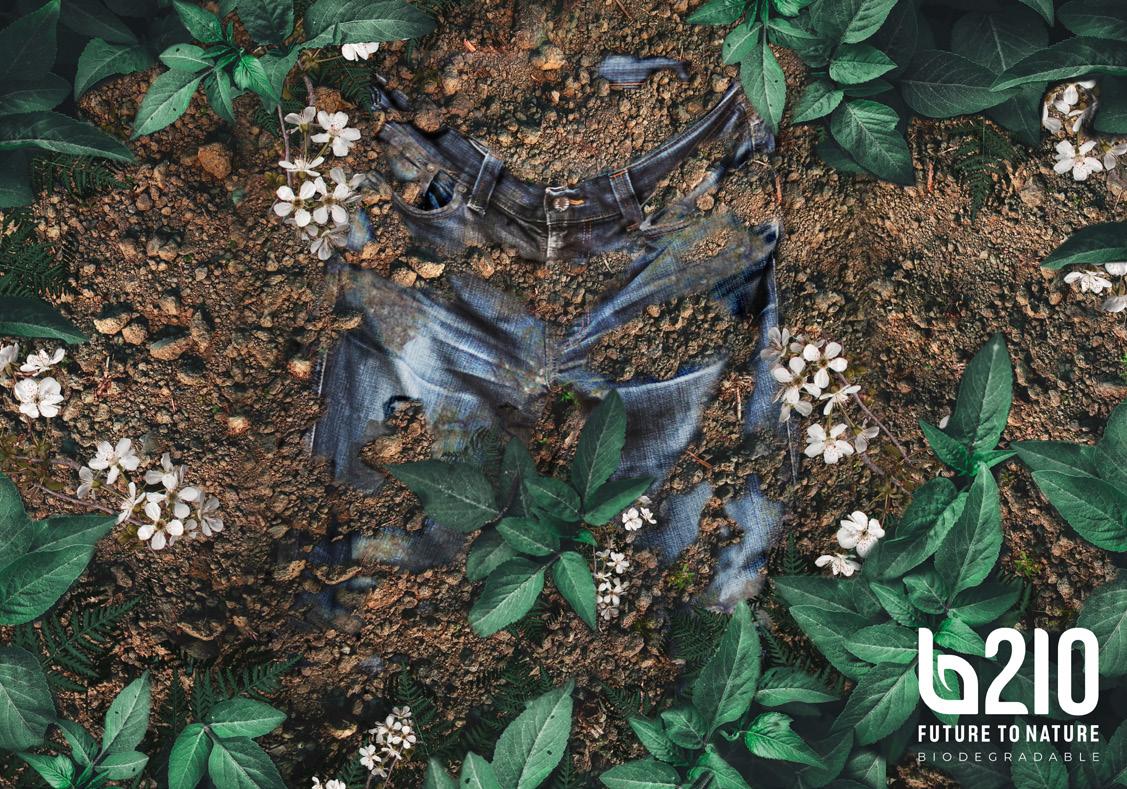
Gen Z has voiced concern about the working conditions for employees and how they are treated. What is Calik doing to increase transparency and improve working conditions?
S.K.: At Calik Denim, we carry out all our production and
business processes with holistic transparency. As a reflection, we pass the necessary inspections and obtain certifications which document that equal and fair working conditions are enforced at our company. Additionally, we are actively working on increasing employee loyalty with our 2025 targets set within the scope of our “Passion for Denim, Passion for Life” sustainability strategy. And, of course, the way to increase this loyalty is through fair working conditions, equality, fair wage policy, transparency and more.
Skinny jeans have served millennials for most of their lives. However, now that trend forecasters are documenting a shift to looser styles, does Calik have any new stretch-fit denim innovations in the works to serve the millennial consumer?
S.K.: Since the pandemic, we’ve noticed the end consumer tends to wear clothing that is stylish, but also comfortable. To keep pace, we offer products that will meet different needs, like stretch, high elasticity and comfort. We work closely to support our customers, with collections that best meet the end consumers' needs.
“It is estimated that the amount of textile waste—which was 0.7 million tons in 2022—will reach 2.2 million tons in 2030.”
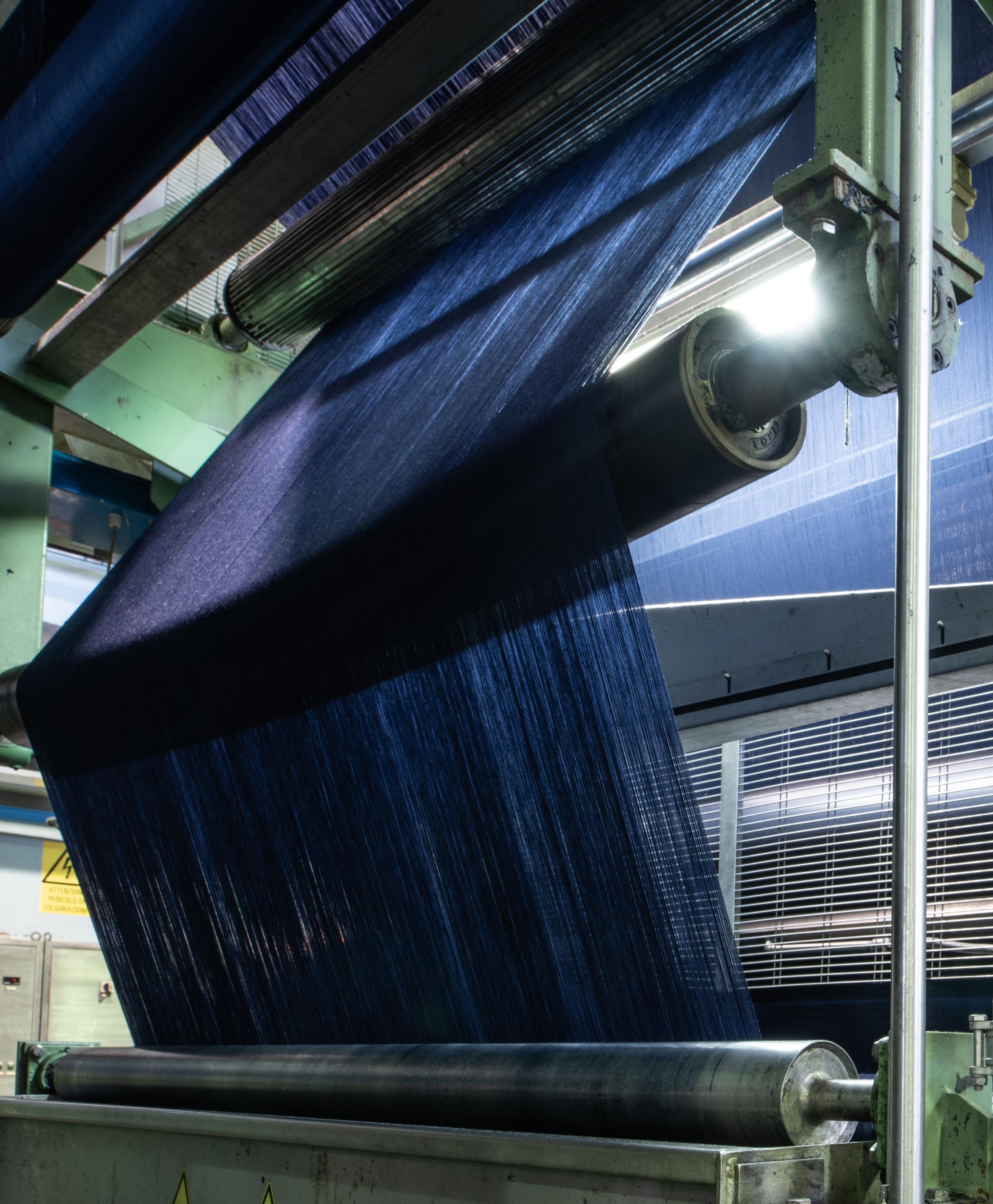 Candiani Denim
Candiani Denim
The world is experiencing “the first truly global energy crisis,” Fatih Birol, executive director of the International Energy Agency (IEA), said during Singapore International Energy Week in late October. He added that things will probably only worsen as demand for liquid natural gas is not expected to meet available supply in the coming months and that the world’s oil supply will also be reduced due to OPEC’s recent decision to cut oil exports by 2 million barrels per day.
That’s bad news for almost everyone but especially grim for denim mills that have literally been put through the mill of late due to rising gas, oil and electricity prices and shortages brought on by this crunch. The struggle to weather this storm of financial burden has been an especially challenging and oftentimes unprecedented one that has pruned production capacity, pushed up prices for raw materials (and ultimately for the fabrics), slashed staff ranks and operations, and unleashed cries for help to regional governments, most of which have fallen on deaf ears.
The situation has been particularly painful in Europe where sanctions against Russian oil and gas exports over Russia’s invasion of Ukraine among other factors caused bills to skyrocket to never-before-seen figures in 2022. In late August gas prices hit a record-setting 321 euros, roughly equivalent in dollars, per megawatt-hour (MWh), a massive jump from the 27 euros they were the August before.
That escalation prompted Euratex, the European Apparel and Textile Confederation that represents the interests of the European textile and clothing industry at the level of the EU institutions, to issue an emergency statement on Sept. 16 that read in part: “An ambitious and meaningful European price cap on the wholesale price of natural gas is absolutely necessary. Europe is running out of time to save its own industry. It is now time to act swiftly, decisively in unity and solidarity at European level. We understand a very high price cap has been so far discussed among Ministries and that is not reassuring for companies across Europe: if any cap is, as expected, above 100/MWh, these businesses will collapse.”
“Given the dire international competition in which the E.U. textiles industry operates, it is not possible to just pass on the increased costs to consumers. Yet, with these sky-high prices, our companies cannot afford to absorb those costs,” the statement continued. “The E.U. textiles companies are mainly SMEs [small and midsized enterprises] that do not have the financial structure to absorb such a shock. In contrast with such reality in Europe, the wholesale price of gas in the U.S. and China is 10 euros/MWh, whereas in Turkey the price is 25 euros/MWh. If the EU does not act, our international competitors will easily replace us in the market, resulting in the deindustrialization of Europe and a worsened reliance on foreign imports of essential products.”
Euratex also noted that several textile mills, especially dyeing and finishing ones, use boilers and dryers that operate on gas only. “There is no alternative technology,” it said.
This gigantic gas-price leap rubbed serious salt into the extant financial wounds of Alberto Candiani, owner of the 84-year-old Candiani mill in Lombardy, Italy, which started getting socked with increased energy bills at the start of 2022, a topic he passionately spoke about at Bluezone in August. He revealed that in the past the company paid about 7 million euros a year for gas and electricity but by the end of 2022 the yearly fee

Exorbitant increases in the cost of gas, oil and electricity are driving some denim mills to the brink of survival.
will reach between 25 million to 30 million euros. The company’s monthly energy bill used to be about 700,000 euros but in 2022 it has been amounting to 4 million euros per month, he said.
Although things are showing slight signs of improvement since August, Candiani said in November that the problem very much remains. “In the past 20 years energy and gas bills have never exceeded all bills, including water. They have never exceeded 10 percent of our turnover. Never,” he said. “This year we're talking 36 percent [of turnover]. And mostly because of the energy costs and natural gas escalated to a point that I couldn’t even expect. In the first quarter of 2022 it kind of doubled and then second quarter tripled, and July and August were just out of control.”
Despite increasing its efficiency by replacing its boilers prior to the crisis which allowed it to sell its “spare” emission units as prescribed by the Kyoto Protocol for 3 million euros, the mill was still forced to raise prices for its wares three different times in 2022, which amounted to a 30 percent hike in the end. “We went from 5.25 euros per meter to 7 euros per meter. And this is unprecedented,” he continued, adding that he was grateful that roughly 80 percent of his customers were willing to accept the increase.
He also said that Candiani has received no government assistance other than a tax write-off it will be eligible to take for the year but that it will still have to pay its bills until then.
To further reduce energy use, the mill switched from a six-day workweek to a four-day one in July and has implemented solar power, though that will only cover 10 percent of its energy needs. Candiani was also forced to scrap a plan to hire 100 new workers in 2022 after having “a beautiful year” post-lockdown in 2021. Instead, he could only take on about 55. “As an entrepreneur that’s failure, right?” he said. “It feels very bad. It’s just frustrating.”

Energy-fueled frustrations have also run high with denim makers in other parts of the world from Asia to North America.
Pakistan, home to such mills as Naveena, Siddiqsons, Artistic Denim Mills and Crescent Bahuman Limited, has had a longstanding energy crisis that forced businesses to shutter for more than two weeks in December 2021 because they did have enough power to continue operations. And seven months later parts of the nation were experiencing 10 to 18 hours of load shedding, or enforced blackouts, that adversely affected production.
Since then, the problem has only worsened after September’s so-called “monsoon on steroids” hit the country, killing 1,400, leaving thousands more homeless, wreaking $30 billion in economic havoc and destroying 45 percent of its cotton crop, according to Ahsan Iqbal, minister of planning and development of Pakistan.
Imran Taveer, a denim researcher at Crescent Bahuman, said his company has not been
immune to the challenges in Pakistan. “One of the most pressing issues has been the rising energy costs and we have experienced the same as well. Our country is already energy deprived so the demand is more than the actual supply which is one of the main factors for the continuous rising prices. These price increases have been quite extensive and regular and a lot of small industry has not been able to cope which has resulted in their closure,” he said.
The mill is managing by implementing alternative energies. “We are using different sources for making electricity and not [depending] on only one source has helped us mitigate the situation in a much better way,” he said. As part of this mechanism, Crescent Bahuman just launched a solar park that synchronizes 8.0 megawatts with its power generation.
Finkler said has risen in price by as much as 100 percent in Mexico.
“We have been renewing and making our machinery more energy efficient to relieve these costs as much as we can,” she said. “We create sustainable energy resources; we have our own hydroelectrical power plant and our own cogeneration plant, which not only increases energy efficiency and supports renewable energy but also has lower emissions and reduces energy costs,” she said about the company’s state-of-theart facility in Puebla.
Durable like the fabric they produce, these and other energy-embattled denim mills have not given up and remain cautiously optimistic, or at least semi-optimistic, about the future.
“I believe with the increased domestic consumptions, energy inflation especially in this part of the world is going to stay for a longer time until and unless there are some other better initiatives taken at government levels,” Taveer said. “We are seeing downfall in the industry and one of the attributes is rising manufacturing costs that include energy costs too.”
Candiani, the mill owner, said lower European gas prices, which fell to 108.5 euros as of Oct. 28, and strong U.S. dollar have combined to ameliorate matters somewhat, especially since U.S. clients make up about 40 percent of his company’s total business. “Now things are normalizing a bit, but we do not see the benefits yet. Natural gas is still very expensive,” he said. “The bill I’m expecting in October should be a little bit better than September but the energy costs are going to stay high until February or March they say.”
He then added, “But what doesn’t kill you makes you stronger, right?”
“We are seeing downfall in the industry and one of the attributes is rising manufactur ing costs that include energy costs too."
—IMRAN TAVEER, CRESCENT BAHUMANCrescent Bahuman is implementing alternative energy sources.
Denim itself is timeless, but styles evolve over time. One thing that doesn’t change is the appeal of stretch fibers for comfort and fit. Ebru Ozaydin, strategic marketing director, denim and ready-to-wear at The LYCRA Company, spoke with Rivet about the enduring appeal of spandex and how sustainability is guiding shoppers’ choices.
RIVET: What are different generations looking for when it comes to stretch denim?
Ebru Ozaydin: Denim buying behavior varies according to demographics, but also culture, lifestyle and social norms. Every decade, the denim cycle reinvents itself with historical or cultural references, and there is always something new to discover for all generations.
Younger shoppers are more experimental, more prone to try seasonal trends, and sometimes driven less by quality and more by variety. They’re also less defined in their gender thinking and more focused on individuality and new experiences.
For veteran shoppers, the search for the “perfect pair” becomes less about finding the trendiest or most coveted jeans and more about what best agrees with their own set of aesthetic codes. This group is looking for timeless pieces with versatility and longevity.
The implementation of stretch fibers in various denim fabric constructions plays two vital roles: in rest, it gives shape and comfort; and in motion, it supplies freedom of movement and a feel-good factor.
At Kingpins Show in Amsterdam, you used CGI to showcase LYCRA® ADAPTIV fiber. What is the value of virtual illustrations in explaining technologies?
E.O.: Computer-generated imagery is a great tool to communicate with fashion consumers, going beyond the limits of physical experience. Though still in its infancy, it has great potential to demonstrate the value of a consumer-centric innovation in a faster, more effective way.
As a technology company whose mission is offering garment solutions for consumers, we have created virtual assets that will resonate with the denim consumer—particularly Gen Z, who is tech-savvy and spends more time online—about the key benefits of LYCRA® ADAPTIV fiber, a patent-pending polymer with a unique chemistry that adapts to fit different body shapes.
Since the virtual experience is an integral part of the metaverse, a new thinking in digital fashion has inspired our storytelling, harnessing a creative way to engage the consumer.
LYCRA® XTRA LIFE™ fibers allow denim to last longer. How do these compare to conventional fibers, and what is the sustainability impact of enhanced durability?
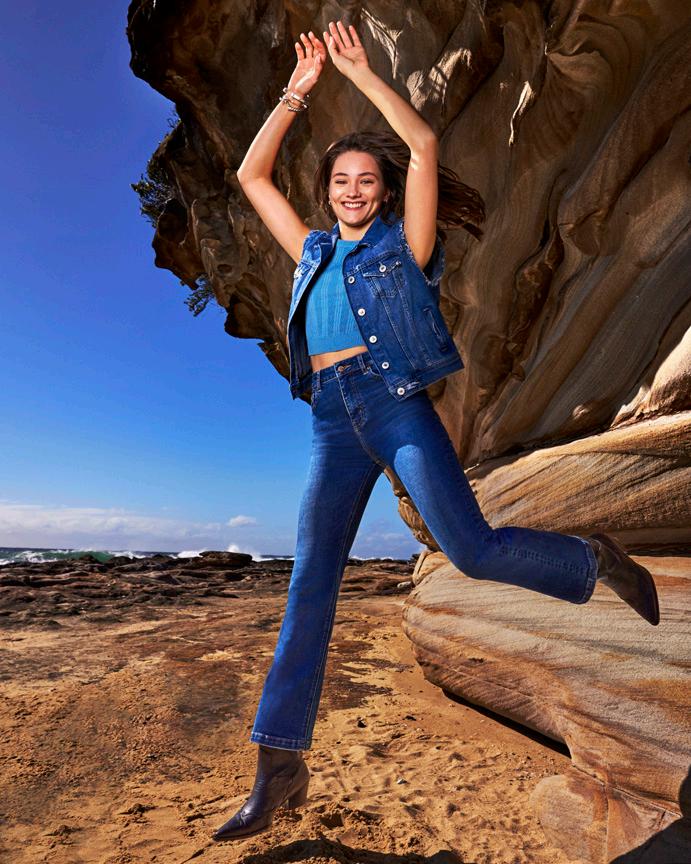
Given the range of denim silhouettes today, what place does stretch have in denim wardrobes? What are some best practices for adding stretch to different styles of jeans?
E.O.: Stretch is an inevitable element of denim design since the ’70s. Regardless of the denim cycles and/or trends, the consumer recognizes and appreciates the value of stretch denim with its superior benefits: comfort, freedom of movement and shaping.
Fabrics engineered with stretch technologies are for all type of silhouettes—from close-to-body cuts to looser ones. The tunnel vision of considering stretch fabrics only for skinny jeans is so yesterday. Designing a pair of jeans is more than a definition of leg opening; it is a complex process focusing on various consumer needs and pain points.
E.O.: This product portfolio—including LYCRA® DUAL COMFORT technology, LYCRA® Anti-Slip fiber, LYCRA® TOUGH MAX™ technology, LYCRA® dualFX® technology and LYCRA® T400® EcoMade fiber made from recycled and renewable materials— adds long-lasting comfort, fit and performance to stretch jeans. Extending the lifespan of garments can help reduce carbon, water and waste footprints. That also helps strengthen the brand reputation as well as consumer satisfaction and loyalty.
Consumers gained a broader understanding of environmental issues during the pandemic, and cost of living "realities" have made them reconsider how garments are made and their longevity. Durable clothing is increasingly in demand by consumers concerned about reducing their footprint. In our May survey, 67 percent of respondents planned to buy fewer but higher-quality garments that last longer.
“The tunnel vision of considering stretch fabrics only for skinny jeans is so yesterday.”Photo credit: Hailley Howard @hailleyhoward
Numerous factors go into shoppers’ decision-making for denim purchases—cost, style, material composition and fit, to name a few. But what is the No. 1 item on consumers’ wish lists? According to a Rivet and Cotton Incorporated survey of industry insiders, they believe environmental concerns come first. Sustainability was named by 46 percent of respondents, slightly edging out durability and comfort, which were both chosen by 45 percent of those surveyed.
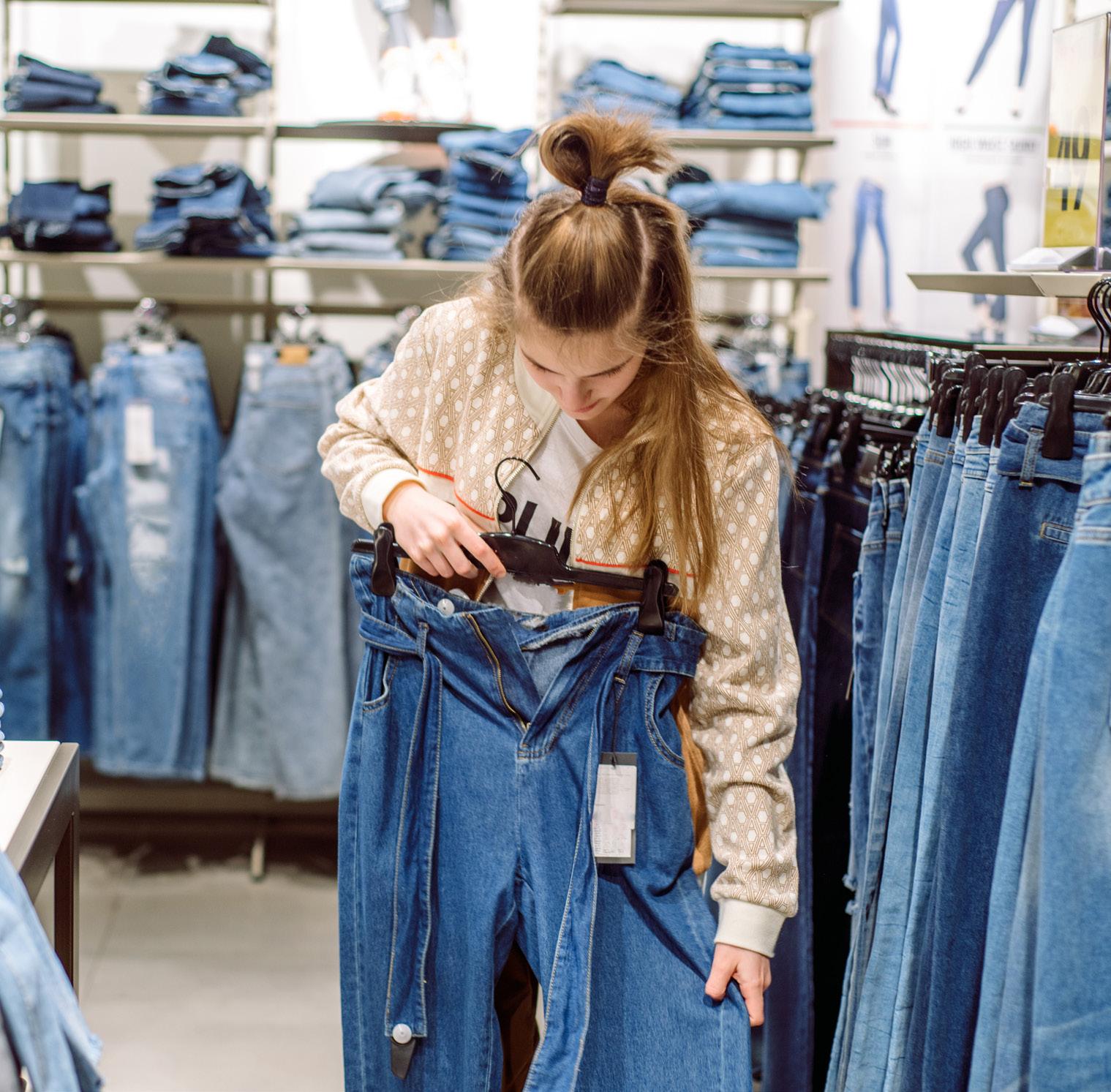
Although the industry thinks consumers favor ecofriendly denim, this is not translating to material sourcing and production priorities. When asked to rank the importance of attributes in manufacturing, sustainability was only deemed essential by 35 percent of those surveyed. Quality (49 percent), price (43 percent) and comfort (41 percent) were weighed most heavily, and sustainability even slipped behind other factors like style and durability.
According to the Cotton Incorporated 2022 Consumer Survey, consumers put comfort (64 percent) and durability (51 percent) far above sustainability (19 percent) concerns when making purchasing decisions. However, industry insiders need to be especially attuned to the issues of sustainability and environmental friendliness because while consumers may not put it at the top of their list, they do hold the industry responsible when their clothing is not sustainable. Over half of consumers will hold the company that manufactured it responsible (58 percent) and 52 percent will hold the brand responsible, according to the Cotton Incorporated 2021 Sustainability & Health and Wellness Survey.
“Shoppers have told us that if the clothing is not comfortable or doesn’t fit, and if the price and quality are not right, they will not buy even if it is sustainable. This doesn’t mean they are not interested in sustainable clothing,” says Melissa Bastos, director of corporate strategy and insights at Cotton Incorporated. “At the end of the day, shoppers hold the industry responsible if they find out the clothing they have purchased is not being produced in a sustainable way.”
This sustainability disconnect reflects a larger need to better align product development practices with what the market actually wants. When professionals were
asked what area of their business requires improvement, knowledge of consumer sentiment and demand came out on top, at 53 percent, ahead of researching sustainability innovations (50 percent).
Matching supply to demand has become even more critical as shopping behavior rapidly changes. Industry Respondents were split over denim demand in the past 12 months; 39 percent indicated it was about the same, and 39 percent said it was lower than usual. Forty percent of respondents expect demand to be about the same for the next year, but illustrating how elusive consumer nature can be, 28 percent of respondents forecast greater demand while 23 percent anticipate demand will decline.
Despite the mostly flat demand projections, around half (52 percent) of those surveyed say they are planning to raise prices in the next 12 months. Rising supply chain expenses—such as prices for materials and transportation—could be behind this strategy. Costing is the No. 1 production concern for those in the industry, cited by 61 percent of respondents, beating out sustainability (51 percent) and access to materials (48 percent). According to the Consumer Survey, 84 percent are expecting to see clothing prices rise. If they do rise, more than half of consumers (58 percent) are expecting to search for sales and 41 percent will wait to buy new clothing.
In response to inflationary pressures, many brands have already raised prices. Across the board, apparel prices were up 5.5 percent year-over-year in September, per the Bureau of Labor and Statistics’ Consumer Price Index. The price growth in fashion has not been
as steep as in categories like food and fuel, but more expensive necessities are straining discretionary spending.
Even amid this challenging retail landscape, industry insiders see the potential for sustainability pricing premiums; 88 percent believe consumers would pay more for sustainability. On average, respondents see the possibility for a 10 percent price bump. But among those planning to raise prices, a third think shoppers would pay upwards of 15 percent more for eco-friendly jeans. Consumers agree they are willing to pay more for sustainable clothing (76 percent), according to the Consumer Survey, with 24 percent of shoppers saying they would pay 15 percent or more. Catering to shoppers’ interest in the environmental impact of their jeans, companies are communicating their sustainability efforts, primarily through social media posts (52 percent) and hangtags (52 percent). The majority of consumers say they prefer to see the information about the sustainability of garments when shopping for clothing on hangtags,
websites, or on in-store displays (58 percent), and 43 percent want to see it through social media, according to the Consumer Survey.
Companies are also turning to collaborations as a differentiator. Almost all (93 percent) said they engage in partnerships, predominantly with fashion influencers (62 percent), other brands (47 percent) and sustainability influencers (44 percent). Forty percent said their collaboration activity had remained steady and 30 percent said it had grown in the last 12 months, indicating these industry mashups will remain a top tactic.
Unless otherwise indicated, all data cited comes from a survey of industry professionals conducted by Rivet in collaboration with Cotton Incorporated from Aug. 15 to Sept. 16, 2022. This article highlights responses from the 281 respondents who are employed full-time, part-time or self-employed. Respondents included professionals at various levels in manufacturers, mills, brands and retailers.
The Cotton Incorporated Consumer Survey was conducted with 1,003 U.S. consumers from Oct. 27 to Nov. 2, 2022.
“At the end of the day, shoppers hold the industry responsible.”
Collaborations, Ye and supply chain-led projects caught the industry’s attention in 2022.
American Eagle Outfitters raises its 2023 financial targets following a joyous holiday season.
Fashion for Good launches a consortium project to accelerate the shift from wet to mostly dry textile processing.
The denim in PreFall 2022 collections
is a battle of bold versus classic, resulting in an exciting-to-look-at hodge-podge of fits, finishes and styling.
EU-funded circular accelerator SwitchMed and Nudie Jeans announce they repurposed 6,530 pairs of secondquality jeans into 16,000 new pairs made of 20 percent recycled cotton in a pilot project.
Saitex opens a stateof-the-art fabric mill in Vietnam.
Levi Strauss & Co. president and CEO Chip Bergh says the world is still in the “early innings” of the shift to looser fits, signaling more success to come for both men’s and women’s jeans categories.
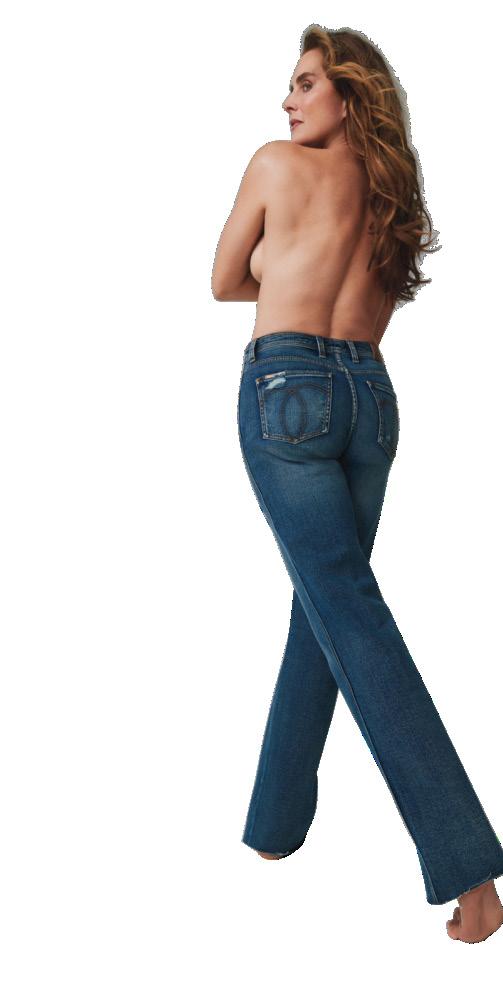
Searches for double denim have pop off following viral photos showing Ye (formerly known as Kanye West) and actress/artist Julia Fox in coordinating indigo garb at men’s fashion week in Paris. Lyst says searches for “doubledenim” shot up 31 percent week-onweek following the public display.

U.S. brands and retailers import $308.10 million worth of jeans in January.
Archroma’s EarthColors for denim workwear.
Denim Tears’ Tremaine Emory joins Supreme as creative director.
Frame responds to consumers’ pent-up demand for travel with Jetset Jeans, a comfort-focused high-stretch pant.
Yeezy Gap Engineered by Balenciaga debuts a $440 jean moto jacket.
Protestors from the Changing Markets Foundation and Extinction Rebellion

Maurices’ new tween girl line.
Jack & Jones drops C2C Gold certified jeans.
words ANGELA VELASQUEZ Julia Fox + YeLenzing opens a Thai lyocell plant for Tencel with a capacity of 100,000 tons per year.
American Eagle reports it did $2 billion in Q4 denim sales.
International Labour Organization says cotton in Uzbekistan is now “free” of child and forced labor.
Marks & Spencer debuts circular jeans for men, women and children.
Pantone and Valentino debut “Valentino Pink PP,” inspiring a flood of
bright pink fashion for the remainder of the year.
Gap Inc. joins brands like H&M and Inditex in suspending deliveries to Russia.
Levi’s reaches over $5.8 billion in revenue—its highest revenue since 1998.
Fred Segal reveals The Original Jean Bar at its L.A. flagship, offering premium and sustainable denim brands.
The NPD Group names straight-leg jeans the top-selling fit among women in the U.S. surpassing the once universally popular skinny jean.

MARTarget adds Levi’s products to 300 additional stores.
Net-a-Porter sells exclusive sustainable designs by Agolde, Citizens of Humanity and Goldsign.

G-Star Raw launches NFTs based on its G-No the rhino mascot.
C&A opens a German jeans factory.
Dickies rolls out 100th anniversary celebrations, beginning with a campaign that pays tribute to the makers that have dressed in tits garments for the last century.

Small-batch label Hiut Denim celebrates its 10th anniversary.
AG, Gloria Vanderbilt, Amiri and Levi’s are among The NPD Group’s list of best-selling denim brands.
Scotch & Soda adds repair services at its Amsterdam store.
TikTok users discover how showering with their jeans on can result in betterfitting jeans.
Guess offers an in-store recycling program benefitting Homeboy Recycling, which sorts and processes items for repair and resale, as well as upcycling and recycling.
Stony Creek Colors inks deal with Archroma to scale its IndiGold highperformance plantbased pre-reduced indigo.
Levi’s announces that it plans to open 100 locations in
Thailand.
Gap Inc.’s Personal Advancement and Career Enhancement (P.A.C.E.) program reaches 1 million women and girls in 17 countries.
Lyst names Kim Kardashianapproved Balenciaga and Gucci the hottest brands in Q1 2022.
Kingpins Amsterdam and Denim Days return to in-person events.
Western and destroyed denim lead festival fashion trends at Coachella.
Zara gets sizeinclusive thanks to a collaboration with Khloe Kardashian’s Good American brand.
Old Navy is named consumers’ favoritefitting brand by True Fit.
Jack & Jones is the first to use Milliner Organic Cotton.
Primark commits to ensuring all its clothing is made from recycled or more sustainably sourced materials by 2030.
Jacquard denim, hemp fabrics and natural dyes abound at Denim Premiere
APRVision’s first trade show in Berlin.
Isko presents luxury fabrics with PG Denim’s Paolo
Trendalytics names acid wash, cuffed jeans and the color purple as trends to watch in men’s
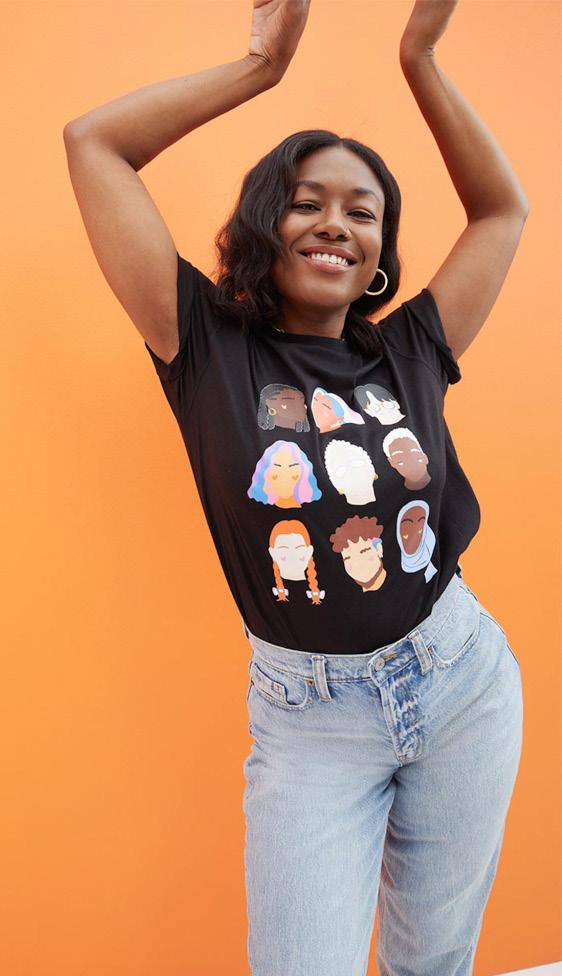
Tommy Hilfiger's parent company, PVH, allots funds for the House of Denim Foundation.
MAYAbercrombie & Fitch Inc. CEO Fran Horowitz says women’s denim, dresses and knits delivered their highest first-quarter sales and AUR in over a decade.
Soorty breaks ground on a 6.26-megawatt captive solar project in Pakistan.
Candiani debuts hemp-infused Tencel fabrics.
Dickies x ZaraMud Jeans debuts 100 percent postconsumer recycled cotton jeans.
Bluesign teams with Sustainable Chemistry for the Textile Industry (SCTI) to develop a sustainable chemistry index that will provide a standard communication guide for chemical suppliers, manufacturers, brands and NGOs.
Levi’s opens a Haus of Strauss in Mexico City.
Farfetch says sales of “Conscious” products grew 1.8 times faster than the marketplace’s average last year.
Denim brands react to the fall of Roe v. Wade on social media.
The Sustainable Apparel Coalition commissions a review of the data and methodology of the Higg Materials Sustainability Index.
AGI Denim achieves B Corp certification.
Loewe grows plants on jeans with bio-designer Paula Ulargui Escalona.
U.S. brands and retailers imported $2.05 billion worth of denim apparel in the first half of the year, according to OTEXA.
Vacation-ready prints, bright colors and biodegradable fabrics trend at Project New York—the first since the start of the pandemic.
Mud Jeans and Saitex land on B Lab’s 2022 “Best for the World” list.
support behind the Dutch Denim Deal to drive circularity.
Wrangler bows a collection of licensed collegiate apparel made in collaboration with Colosseum Athletics.

of their purchasing power to Blackowned businesses.
Denim takes center stage at Cotton Citizen’s new Beverly Hills store.
H&M introduces “Better Denim” collection amid claims that it falsely advertised its sustainability practices.

Good American launches deniminspired swimwear. practices.
Huue raises $14.6 million to scale its bacteria-derived indigo.
Naked & Famous, Caterpillar, Joe’s, Artmeetschaos and more take home Rivet x Project Awards.
Levi’s relaunches ’90s-era SilverTab at exclusively at Kohl’s.
Rudolf Group marks its 100th birthday with a modern rebrand.
Monki debuts its first products that follow Ellen MacArthur Foundation’s Jeans Redesign project.

AGI Denim opens “Exquisite Blue Towers,” a gallery exhibition in New York City.
Closed opens its first U.S. store, a popup in L.A.
Balenciaga, Schiaparelli and feature denim in their Fall 2022 haute couture collections in Paris.
Old Navy joins the Fifteen Percent Pledge, the racial equity and economic justice nonprofit that encourages corporations to commit 15 percent
Re/Done says “bonjour” to its first store in Paris.
Mother Denim WranglerThis is just the beginning of our journey with Ellen MacArthur Foundation toward H&M Group’s ambition to design all products for circularity by 2025.” —Caroline Carlryd, Monki
NFTs, sustainable stretch denim and better basics are hot topics at Bluezone in Munich.
Tommy Hilfiger returns to NYFW with a star-studded Andy Warholthemed fashion show.

Ye pulls the plug on his Yeezy collaboration with Gap after accusing the brand of copying his designs for their own merchandise.
Hugo Boss and Replay combine styles in a denimmeets-athleisure collaboration.
Levi’s announces plans to add
secondhand and upcycling initiatives in top markets by 2025.
Edited says the number of men’s skinny jeans in stores plummeted from 48 percent in 2021 to 21 percent in 2022.
Levi’s expands its use of natural indigo with custom fabric from Cone Denim.
Isko opens a Creative Room near Hamburg, Germany to support local clients’ R&D needs.
WGSN and Coloro name Apricot Crush the 2024 color of the year.
American Eagle reports it has slashed water consumption by an average of 36 percent per pair of jeans produced.
Footwear stalwart Frye announces plans to launch a denim-focused apparel collection.
G-Star Raw taps into the Y2K trend by reissuing styles from the year 2000.
Blue In Green announces plans to open a second store in Denver, Colo.

Madewell launches jeans made with Isko’s Bluesignapproved fabrics.
Bright colors, removable trims and dry finishing technologies make a splash at Kingpins Amsterdam.
Diesel’s parent company OTB aims for net zero by 2050.
OCTCalik Denim introduces biodegradable B210 technology.
Khloe Kardashian, Jens Grede and Remi Bader are among the 2022 Rivet 50 honorees.
Adidas, Gap, Vogue and Balenciaga cut ties with Ye after he makes a slew of antisemitic remarks.
Lucky Brand drops a collection of licensed “Yellowstone” apparel inspired by the popular ranch series.
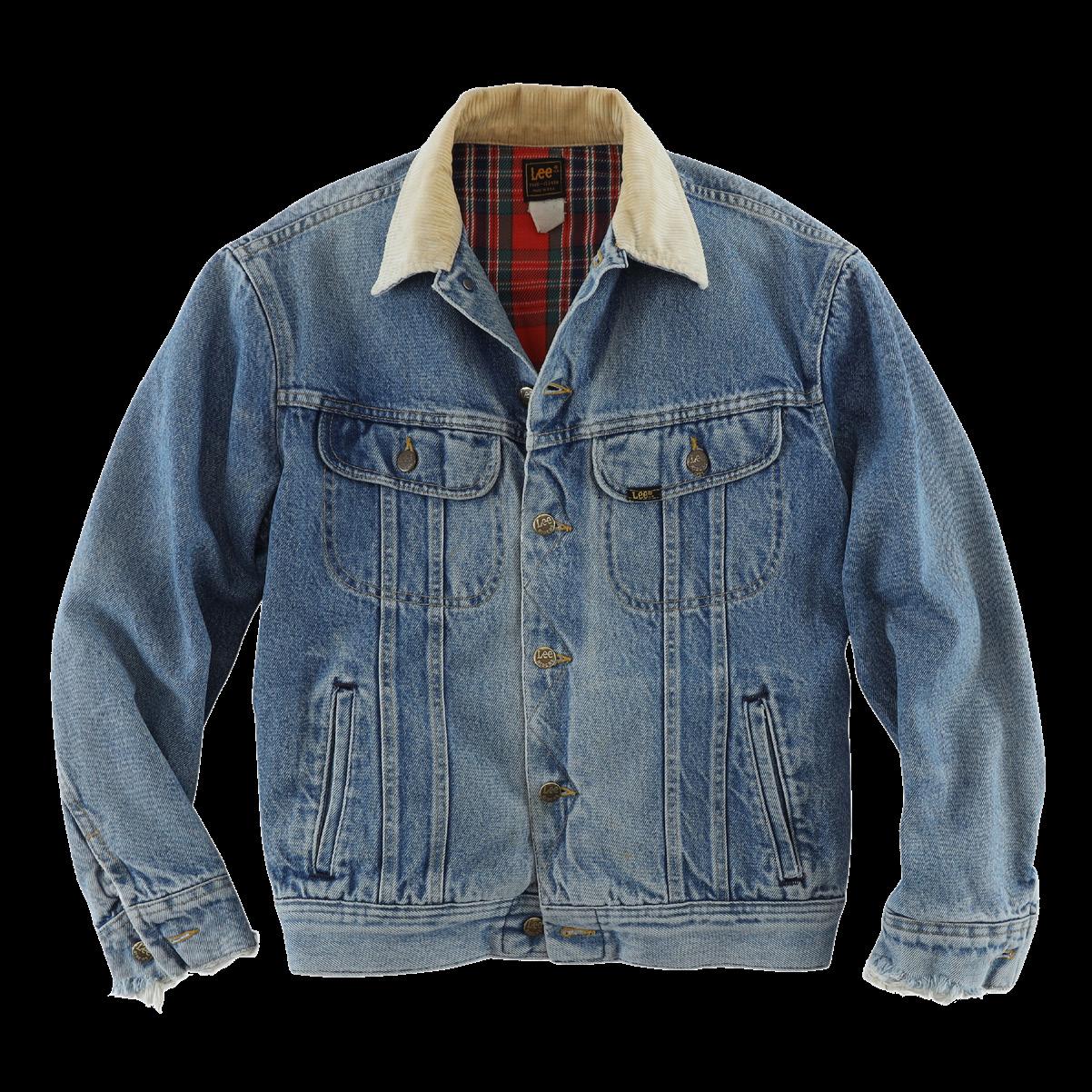
Lee adds a vintage shopping vertical to its website, selling 1960s Lee Storm Rider jackets.
Mother, Levi’s and Citizens of Humanity encourage consumers to vote early in the U.S. midterm elections.
Candiani gets into bespoke cotton
variety, designed to be a stronger fiber.
AG’s new animalfree leather employs organic biomass and other plantbased materials that eliminate toxic chemicals.
Lee and The Brooklyn Circus pay homage to Black cowboys in a capsule collection.
Victoria Beckham targets a younger consumer with a denim collaboration with influencer Mia Regan.
Women’s retail Maurices introduces a jeans exchange program for consumers that no longer fit into their jeans.
Unspun partners with artist Bráulio Amado to add custom prints to its made-to-order jeans.
Tommy HilfigerThe denim belt loop is celebrating its centennial.
words _____CHRISTOPHER BLOMQUISTThe often taken for granted denim belt loops turned 100 this year.
Belt loops themselves are significantly older than their denim counterparts. They were introduced in the 19th century and used mostly on uniforms such as the sporting ones that can be seen on baseball players from the 1880s. By the turn of the century, they were on the breeches of the official U.S. army uniform issued in 1904. The Boy Scout Handbook 1911 First Edition says that the $2 trousers for scout masters had to be full length and “made of standard olive drab cotton cloth, belt loop.”
First appearing on a pair of Levi’s 501s in 1922, denim belt loops were an alternate to suspender buttons, an original feature of the jean, and reflected society’s growing fondness for belts over braces. The back cinch was also retained for those who wanted to wear suspenders. The cinch was finally removed permanently from the jeans in the 1940s when fabric was being rationed because of WWII.
While they’ve prevailed for a century, the denim belt loop has not radically evolved—though there have been variations over the years. “Belt loops on our 501 jeans haven’t changed much over the years, but belt loops on other Levi’s products have ranged from oversized loops on Red Levi’s to double loops and leather loops on Orange Tab jeans to slanted
loops on Silver Tab Levi’s that were attached on the waistband at an angle,” said Tracey Panek, Levi Strauss & Co. historian.
Though there are traditionally five loops on the waistband of a jean, Wrangler features seven on its Cowboy Cut model, first launched in 1947, for extra comfort when horseback riding. Other variations include DIY embroideries or loops made of vegetable tanned leather, like the limitededition jean released by Italian brand Roy Roger in 2013.
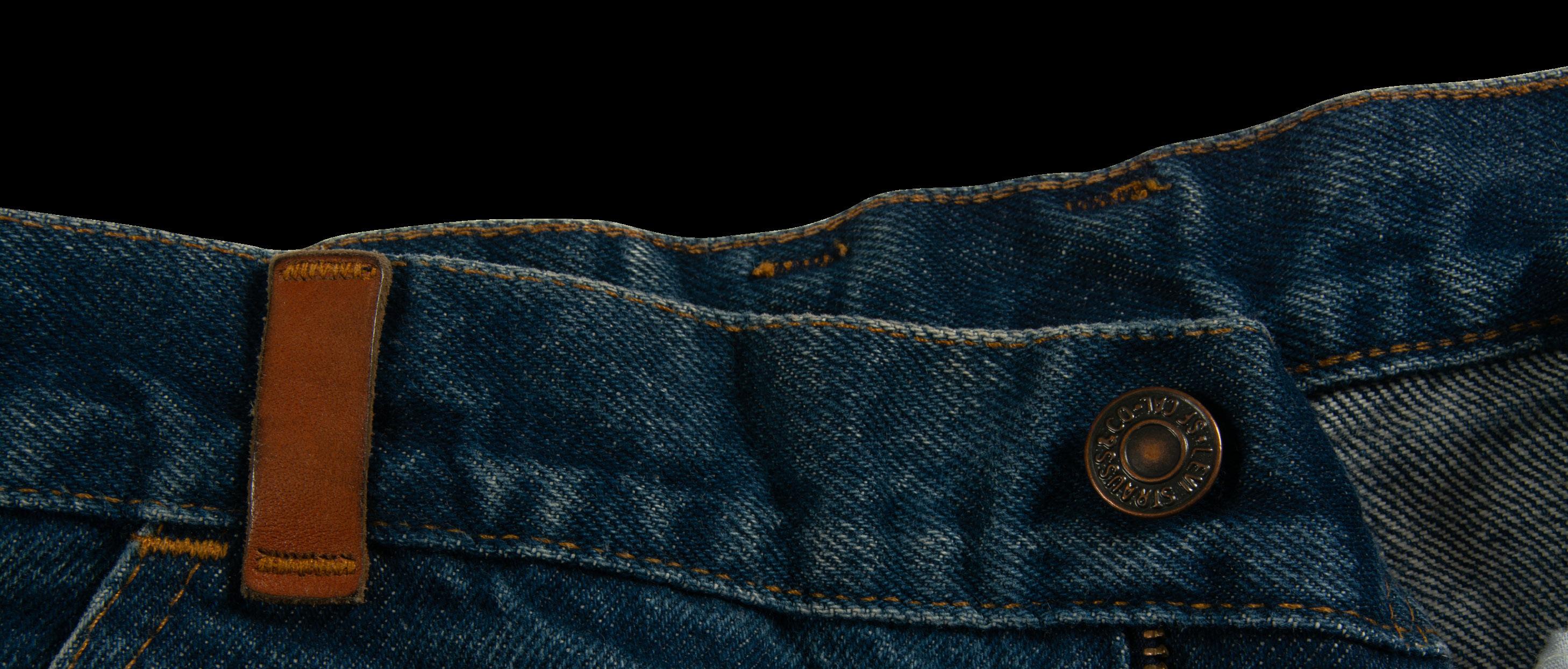
“Belt loops oddly hold an importance to me in the design and function of the jean,” said Christine Rucci, president of Godmother NYC Inc. “I am a purist and love 7/16" x 2-1/4" to allow for 2-inch belt to pass through. I mainly work with 100-year-old Union Special machines at my local denim factory in the Garment District and they are set with the old-fashioned width.”
Rucci is also fond of loops’ potential decorative aspects by adding hardware such as chains and other “jewelry for your jeans” as she calls it. One of the most extreme examples of this were Earnest Sewn’s collaboration with Van Cleef & Arpels released in 2008. The jeans had a gold Alhambra-style chain from the front right belt loop which attached to a wallet in the back pocket. The jeans retailed for $9,700-$11,300.
The presence of belt loops generally means an accompanying belt and brands including Levi’s and Wrangler among others have a history of awarding large belt buckles to rodeo stars. They also do big business making and selling belts of their own. Belts are the largest business in Levi’s accessories division. The brand said it produces more than 2.5 million belts annually.
That’s a lot of loops to go through.
February
February
February
February
May


